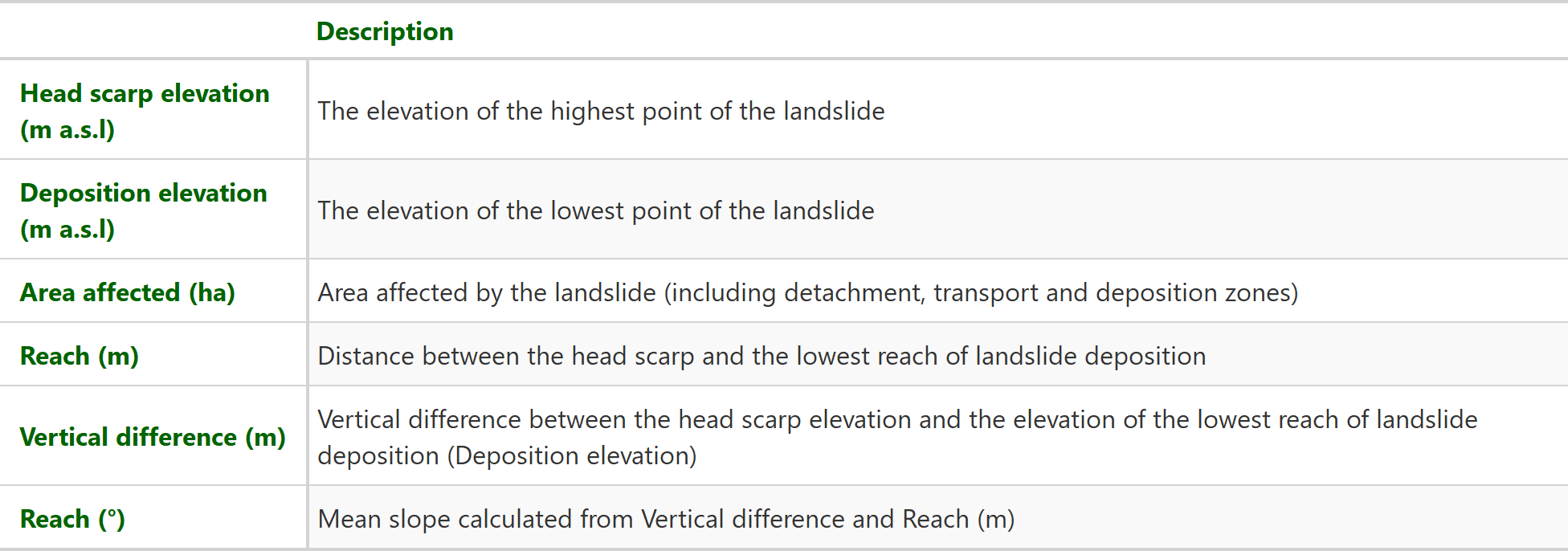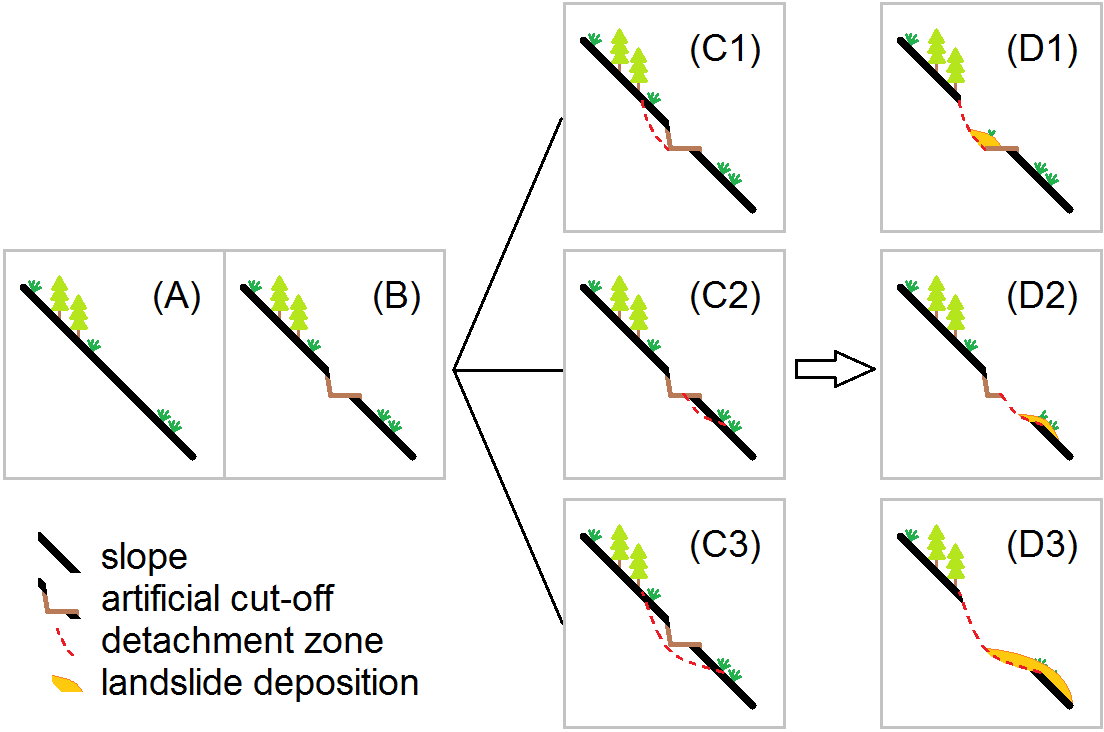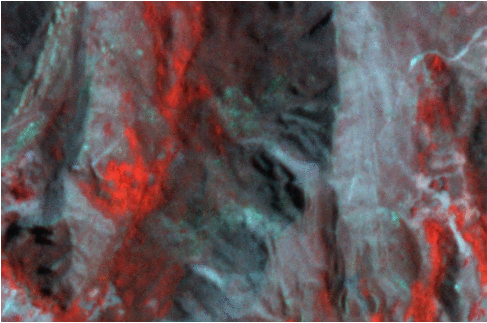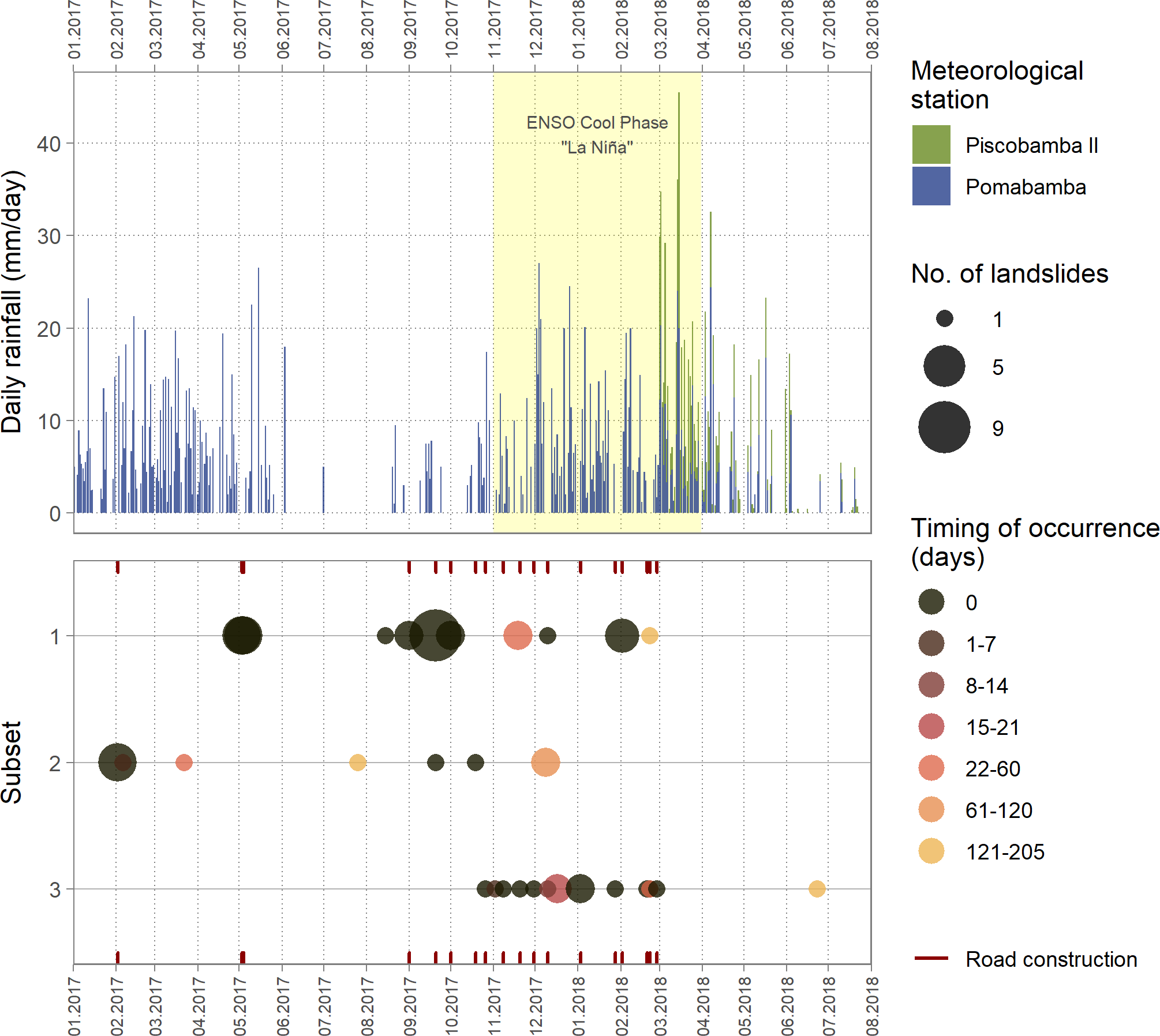class: center, middle, inverse, title-slide # Road Construction and Rainfall as Landslide Triggers in the Rio Lucma Catchment, Eastern Cordillera Blanca, Peru ## vEGU21 | Session: GM4.13 ### <div class="line-block">Lorena Abad<sup>1</sup>, Daniel Hölbling<sup>1</sup>, Adam Emmer<sup>2</sup><br /> <sup>1</sup>Department of Geoinformatics - Z_GIS, University of Salzburg, 5020 Salzburg, Austria<br /> <sup>2</sup>Institute of Geography and Regional Science, University of Graz, 8010 Graz, Austria</div> ### Apr. 29, 2021 - 15:30 --- <div class="my-footer"><span> <a href="http://creativecommons.org/licenses/by/4.0/"><img src="https://i.creativecommons.org/l/by/4.0/88x31.png"height="25px"/></a>                             </span></div> ### Study Area .pull-left-35[ #### Rio Lucma Catchment - **Location**: eastern side of the Cordillera Blanca, Peru. - **Average rainfall** in the area: 1,169 mm/year, (80% during the rainy season, i.e. November to April). - **Elevation**: 2,500 - 5,830 m a.s.l. - **47 km** of unpaved roads were *recently* constructed to connect remote settlements. - Located in a high relief landslide-prone area. - Roads are rarely equipped with drainage or landslide mitigation measures. ] .pull-right-65[ <div id="htmlwidget-f681d2a563c6a163c75a" style="width:650px;height:500px;" class="leaflet html-widget"></div> <script type="application/json" data-for="htmlwidget-f681d2a563c6a163c75a">{"x":{"options":{"crs":{"crsClass":"L.CRS.EPSG3857","code":null,"proj4def":null,"projectedBounds":null,"options":{}}},"calls":[{"method":"createMapPane","args":["tmap401",401]},{"method":"createMapPane","args":["tmap402",402]},{"method":"addProviderTiles","args":["OpenStreetMap",null,"OSM",{"minZoom":0,"maxZoom":18,"tileSize":256,"subdomains":"abc","errorTileUrl":"","tms":false,"noWrap":false,"zoomOffset":0,"zoomReverse":false,"opacity":1,"zIndex":1,"detectRetina":false,"pane":"tilePane"}]},{"method":"addProviderTiles","args":["Esri.WorldImagery",null,"ESRI Imagery",{"minZoom":0,"maxZoom":18,"tileSize":256,"subdomains":"abc","errorTileUrl":"","tms":false,"noWrap":false,"zoomOffset":0,"zoomReverse":false,"opacity":1,"zIndex":1,"detectRetina":false,"pane":"tilePane"}]},{"method":"addProviderTiles","args":["Esri.WorldTopoMap",null,"ESRI Topo",{"minZoom":0,"maxZoom":18,"tileSize":256,"subdomains":"abc","errorTileUrl":"","tms":false,"noWrap":false,"zoomOffset":0,"zoomReverse":false,"opacity":1,"zIndex":1,"detectRetina":false,"pane":"tilePane"}]},{"method":"addPolygons","args":[[[[{"lng":[-77.3774725075078,-77.3675934783029,-77.3703202123566,-77.3743607033178,-77.3930875464688,-77.4115212953128,-77.4301322025985,-77.4380408437788,-77.4514976607711,-77.4676562078993,-77.47961638785,-77.4902111549352,-77.5052364047123,-77.5221254658383,-77.523929860809,-77.5204294683927,-77.5210706040392,-77.5152561376467,-77.4963441195226,-77.4839385624572,-77.4610747879789,-77.4442033991321,-77.4205682550098,-77.3774725075078],"lat":[-8.90043266112152,-8.90815231728087,-8.92831771229687,-8.94076509529537,-8.95123008195852,-8.94303076655625,-8.94038336329276,-8.94256645016178,-8.94618737447111,-8.94187917151247,-8.93357724414897,-8.93885947577601,-8.93840393263457,-8.93696817141074,-8.92610978051032,-8.91901060742118,-8.90504917380947,-8.89172379638076,-8.87883553066313,-8.87972986849027,-8.88744307485432,-8.88575711920094,-8.89558348351603,-8.90043266112152]}]]],"X1","Study area",{"interactive":false,"className":"","pane":"tmap401","stroke":true,"color":"#FF0000","weight":2,"opacity":1,"fill":true,"fillOpacity":0,"dashArray":"none","smoothFactor":1,"noClip":false},null,null,null,{"interactive":false,"permanent":false,"direction":"auto","opacity":1,"offset":[0,0],"textsize":"10px","textOnly":false,"className":"","sticky":true},null]},{"method":"addPolylines","args":[[[[{"lng":[-77.4054700757524,-77.4054608002659,-77.4055131894984,-77.4056202770677,-77.4056825604172,-77.4056910245167,-77.4056022966096,-77.405533648514,-77.4054851395082,-77.4054756368944,-77.4054143065724,-77.40530909768,-77.4051950001041,-77.4050469828128,-77.4049323869251,-77.4048269552997,-77.4047516964372,-77.4046307446853,-77.4044782995481,-77.4042928927447,-77.4040536474691,-77.403892831218,-77.4036340806209,-77.4034831218146,-77.403263066594,-77.4032907466344,-77.4033082676221,-77.4033203802378,-77.4033082831423,-77.4032897853567,-77.4028803695071,-77.4025488167022,-77.4022417645635,-77.4019824001002,-77.401956523084,-77.4020025710954,-77.4021779308399,-77.4023118131788,-77.4024428898851,-77.4026773674688,-77.4029512226529,-77.4030746460011,-77.4032899495218,-77.4034859393804,-77.4035884059993,-77.4037063897323,-77.4038523896052,-77.4039554830042,-77.4042304470871,-77.4044774466746,-77.4046748818416,-77.4048915817429,-77.4049560681148,-77.4049728695038,-77.4048741782461,-77.404737441196,-77.4046018281179,-77.4045519460194,-77.4045828337736,-77.4045664213856,-77.404567202587,-77.4046042901079,-77.4046837735909,-77.4048588744031,-77.4049658553592,-77.4050831217494,-77.4051987541256,-77.4052813890834,-77.4053692910082,-77.4054499802688,-77.4055692243286,-77.4056845955822,-77.4057830826233,-77.4058247527632,-77.4057943097494,-77.4056917394024,-77.4055386961902,-77.4055051790934,-77.4054403054122,-77.4054556213541,-77.4055806653109,-77.4056214099907,-77.40562220065,-77.4056026075225,-77.4056259552409,-77.4057280297325,-77.4058435074336,-77.4060930842772,-77.4063518671581,-77.4066761047138,-77.4067819720661,-77.4068847961872,-77.4069804228407,-77.4070577750871,-77.4071692457579,-77.4074995484389,-77.4078968219603,-77.4080098788125,-77.4081213093925,-77.4081505413554,-77.4082042240545,-77.4083445997212,-77.408434883021,-77.4084445513046,-77.4084489514072,-77.4084827643133,-77.408483858215,-77.4084641630807,-77.4084627198672,-77.4084723839518,-77.408504193636,-77.4083907815605,-77.4084541631004,-77.4084062554344,-77.408327968919,-77.4082447750868,-77.4082471906595,-77.4083338017526,-77.4083412605255,-77.4082390968772,-77.4081699447059,-77.4081339893315,-77.4081350553425,-77.4081399664053,-77.4081511783658,-77.4081627333345,-77.40817742959,-77.4081603357831,-77.4081124984183,-77.4080262465781,-77.4079623431153,-77.4079683164006,-77.4079777571946,-77.4079732428705,-77.4079456749462,-77.4078178293373,-77.4076547041699,-77.4074220781079,-77.4072691035024,-77.4071192860718,-77.4069202518754,-77.4068357571161,-77.4067247350873,-77.4066447917285,-77.4065302948323,-77.406458738842,-77.4064412873653,-77.4065090015053,-77.4066276821243,-77.4067774430878,-77.4067952476163,-77.406877290826,-77.4070110111538,-77.4072208572017,-77.4073699629822,-77.4075012679956,-77.4075498011793,-77.4075113695447,-77.4074034579736,-77.4071010664491,-77.4069474456045,-77.4068088485388,-77.4067177867972,-77.4066083463348,-77.4064860938917,-77.4063083157243,-77.4061914158357,-77.406079296305,-77.4060062253369,-77.4059507790526,-77.4059150666201,-77.4058962899314,-77.4058519321631,-77.405789364567,-77.4056825464339,-77.4055737949838,-77.4054514234055,-77.4053705908852,-77.405315236562,-77.4052437447265,-77.4051565190102,-77.4050622621526,-77.4050034325808,-77.4049334091724,-77.4048155970751,-77.4046674227928,-77.4046609075473,-77.4046229957489,-77.4045671199023,-77.4044782037122,-77.4043483962889,-77.404228693437,-77.4041263496408,-77.4040071642366,-77.4038926419042,-77.4037932986729,-77.4036931631552,-77.4036162849038,-77.4035804529639,-77.4035060735572,-77.4033780621892,-77.4032334585965,-77.4029453700612,-77.4026669683293,-77.4025053704924,-77.4023108931304,-77.4021421636544,-77.4020634691012,-77.4019751679187,-77.4019075346877,-77.4018131654576,-77.4017240376945,-77.4017020351637,-77.4016908387783,-77.4016890174769,-77.4016829694891,-77.4016803503349,-77.4016477060472,-77.401572105964,-77.4014556721675,-77.4013359406876,-77.4012132144531,-77.4011556108244,-77.4011466698352,-77.4011981272206,-77.4012840175798,-77.4013556726423,-77.4014472159407,-77.4015155923931,-77.4015703185261,-77.4015827953357,-77.401516768704,-77.4013899213175,-77.4013842348393,-77.4014022086671,-77.4014782837059,-77.4015606910757,-77.4016350249327,-77.4017041404504,-77.4017566791355,-77.4018219071279,-77.4019061927723,-77.4019637646589,-77.4020868495004,-77.4022659940245,-77.4024314501317,-77.4026162346567,-77.402838636383,-77.4029145944757,-77.4029427294897,-77.4029454220628,-77.4029885286007,-77.403017133809,-77.4029342142113,-77.4028673868954,-77.4028287674938,-77.4027846226972,-77.4027415990624,-77.4026458143151,-77.4025032225308,-77.4024461240926,-77.4023906738236,-77.4023180108409,-77.4022699371518,-77.4022367643604,-77.4022598535076,-77.4023032996294,-77.4023870771108,-77.4024523376519,-77.4025587583322,-77.4025882115146,-77.4025154028035,-77.4024561385254,-77.4024057140721,-77.402299261529,-77.402211077018,-77.402108065624,-77.4020901348952,-77.4021340731218,-77.4022739165314,-77.402481511774,-77.4025857327709,-77.4027957656006,-77.4029250865603,-77.4030678860793,-77.4031974686089,-77.4033039631647,-77.4034090731451,-77.4035723228083,-77.4037141271252,-77.4038192098526,-77.4040264846296,-77.4041005758168,-77.4040848373364,-77.4040226093076,-77.4040419909522,-77.4040865610233,-77.4041794012704,-77.4042674512744,-77.4043055445663,-77.4043037984365,-77.404235997075,-77.4042390187378,-77.4042699327153,-77.4043409200485,-77.4044118272109,-77.4044301255092,-77.4044610968598,-77.4045395580576,-77.4047822891375,-77.4049561298817,-77.4049986786294,-77.405011911244,-77.4050501332681,-77.4051255214895,-77.405274223094,-77.4053009144289,-77.4053203030634,-77.4052977236995,-77.4052656996733,-77.4052557279316,-77.4052694548209,-77.4053519000412,-77.4054177104252,-77.4054979425006,-77.405591458359,-77.4057604173782,-77.4058781470479,-77.4061082237547,-77.4061994232698,-77.4063291243636,-77.4064306094948,-77.4065225314176,-77.4066282259709],"lat":[-8.89613184881744,-8.89640436654539,-8.89656115986368,-8.89666381929883,-8.89677948045732,-8.89693602739108,-8.89702768601802,-8.89714010131402,-8.89729755887555,-8.89751794154691,-8.89762341418282,-8.89767947345503,-8.89769395457114,-8.89771076499175,-8.89774465944009,-8.89787246450615,-8.89797838283703,-8.89814400398906,-8.89827278470326,-8.89841184692583,-8.89871033863189,-8.89889960297811,-8.89908181978247,-8.89920536216275,-8.89938827118374,-8.89952262882223,-8.89971137647506,-8.89998246905513,-8.90039650270654,-8.9007157582166,-8.90087450146512,-8.90097723564047,-8.90119169383092,-8.90142364638822,-8.90152392111965,-8.90159251140585,-8.90154277557233,-8.90150506033842,-8.90150615086542,-8.90157065860459,-8.90163792559341,-8.90164996397404,-8.90174187872212,-8.90186118816578,-8.90189130656066,-8.90198109992849,-8.90211883959502,-8.90212489479024,-8.9020866395069,-8.90200044413929,-8.90199008407454,-8.90208682710024,-8.90222931668095,-8.90240417323452,-8.90253186684332,-8.90263734360087,-8.90277627876551,-8.90290514116813,-8.90330891564592,-8.90357061894658,-8.9037383115979,-8.90383736913753,-8.90392906644838,-8.90406653308224,-8.90414871298359,-8.90423393069169,-8.90430985613432,-8.90430989048506,-8.90428499478553,-8.90424694437947,-8.90420698922853,-8.90417250971645,-8.90417939284148,-8.9042490052148,-8.90435038979078,-8.90448354969409,-8.90468798077969,-8.90479956352223,-8.90492622611876,-8.90503898127275,-8.90531318408092,-8.90548820059755,-8.90576614315535,-8.90595661317886,-8.90611567609141,-8.90619869677204,-8.9061930075814,-8.90614959227826,-8.90607577134268,-8.90593294990464,-8.90590012707086,-8.9058774342689,-8.90592320903666,-8.9060298015001,-8.90608245783949,-8.90605383914745,-8.90601838904948,-8.90608713336396,-8.90633125082421,-8.90660421717855,-8.90671476197206,-8.90693019366521,-8.90716406753608,-8.90735445201739,-8.90756983796419,-8.90765044418544,-8.90776558631367,-8.90803581208008,-8.9082184330249,-8.90832716110446,-8.90853290662288,-8.90868711323799,-8.908975419584,-8.90915317674979,-8.90926361166439,-8.90948378796237,-8.90963460469838,-8.90977681900948,-8.90989405803137,-8.9099324225837,-8.90985371580464,-8.90972084324438,-8.90962387132445,-8.90951412929334,-8.90933674194113,-8.90919558594082,-8.9090720275399,-8.90894190294271,-8.90881108302605,-8.90860225350571,-8.90845003246409,-8.90824326671641,-8.90819321251406,-8.9080306218333,-8.90784179271891,-8.90774308662786,-8.90768685510856,-8.90772142939988,-8.90779049721518,-8.90787715931,-8.9079966054601,-8.9080718494614,-8.90816986630943,-8.90820196545909,-8.90824614230474,-8.9083251622567,-8.90846731579667,-8.90850388813721,-8.9084831853309,-8.9083965739305,-8.9083934677341,-8.90837310547532,-8.90836792350174,-8.90844625340324,-8.90849284061792,-8.90854253730117,-8.90864296845156,-8.90877065818908,-8.90878341924714,-8.90876959436456,-8.90876613303291,-8.90877819963487,-8.90881256479869,-8.90885598315328,-8.90885784273272,-8.90880118376009,-8.90883132428707,-8.9088606281202,-8.90886362933886,-8.90873178989651,-8.90862550973895,-8.90855527628439,-8.90843043536623,-8.90828871249578,-8.90819876741779,-8.90820171446865,-8.90822301198851,-8.90823230335645,-8.9081941463422,-8.90812045464406,-8.90798695526077,-8.90768053043249,-8.90746308543379,-8.9073196851077,-8.90718415415289,-8.9069111676188,-8.90690247750415,-8.90677623978926,-8.9066330357187,-8.90657934260103,-8.90657232816902,-8.90659324555831,-8.90660122780524,-8.90657252014812,-8.90643428162555,-8.90613874882979,-8.90598210873977,-8.90579165574724,-8.90561276144247,-8.90552313526271,-8.90540835498334,-8.90525676821882,-8.90524307563113,-8.90525720588744,-8.90529035738404,-8.90535880418664,-8.90551122167422,-8.90564271298597,-8.90580004280322,-8.90590948589794,-8.90595520338799,-8.90595124951007,-8.9058623571184,-8.9057273475024,-8.90571786815,-8.90553241999488,-8.90539008632408,-8.90529708001139,-8.90518663770573,-8.90514752859108,-8.90516845339698,-8.90522458871887,-8.90528416647486,-8.90538954734497,-8.90542498834347,-8.90543465310516,-8.90542213742957,-8.90543573516848,-8.90548291774096,-8.90556192183669,-8.9056775873149,-8.90587025267099,-8.90612641156074,-8.90629737059287,-8.90646363866221,-8.90667698293587,-8.90674914751651,-8.90675540919604,-8.90670975586317,-8.9066284917644,-8.90651117374817,-8.9063903072687,-8.90630774845205,-8.90620881649593,-8.90617274104006,-8.90616812854777,-8.90624240232539,-8.90644484580503,-8.90659498382415,-8.90677683233221,-8.90687186429801,-8.90700252074524,-8.90710685007552,-8.90718294566293,-8.907161367317,-8.90708261493359,-8.90694752484746,-8.90684528191798,-8.90679982774057,-8.90673850735533,-8.90666696018377,-8.90660460680669,-8.90655477238228,-8.90655833563474,-8.9066410166592,-8.90673775480585,-8.90678767797222,-8.90689742948593,-8.90703868473134,-8.9071675798459,-8.90724785339618,-8.90729842036759,-8.90726607949674,-8.90720369275569,-8.90712718047749,-8.90707113527565,-8.90706524081097,-8.90714929092431,-8.90722719814763,-8.90732619894838,-8.90742730982354,-8.90744225748088,-8.90742935628428,-8.90752945751946,-8.90764295013235,-8.9077035811506,-8.90777299807109,-8.90786201435813,-8.90797471554292,-8.90815861259496,-8.90819836691173,-8.90826371458727,-8.90837615964796,-8.90850394594101,-8.90880216540545,-8.90896091984993,-8.90907204717263,-8.90923606912054,-8.90934838876607,-8.90947849081655,-8.90968083705893,-8.90985068499722,-8.90997173196603,-8.91005854477432,-8.91017691123671,-8.91034799631846,-8.91049877422868,-8.91056059415353,-8.91059009478587,-8.91066754743075,-8.91074240949601,-8.91089703874839,-8.91110365740198,-8.91131450659453,-8.91143804164414,-8.91168457870126,-8.91185282585757,-8.91214787763567,-8.91240334724716,-8.91262784769952,-8.91273613838402,-8.91283134286575,-8.91301514268119,-8.91302048160082,-8.91301072285151,-8.91300284646918,-8.91300698171051,-8.91307656276781,-8.91318752931527,-8.91334376828859,-8.91344834409811,-8.91357020293636,-8.91371450014632,-8.91388958166054]}]],[[{"lng":[-77.4517634339713,-77.4516984546254,-77.4516585395248,-77.4516220452889,-77.4516654254205,-77.451737082869,-77.4519140232075,-77.4520461511336,-77.4521433502311,-77.452269527331,-77.4523670565551,-77.4524701008891,-77.4525448702789,-77.4525988897715,-77.452577800611,-77.4525363271136,-77.4524565829137,-77.4523648392924,-77.4522626940851,-77.4522152696909,-77.4521717673338,-77.4520691907868,-77.4519637516128,-77.4518114004843,-77.4516226780367,-77.4514290716022,-77.4513141937754,-77.4512607720185,-77.4511833234262,-77.4510144483521,-77.4508724320018,-77.4506970189678,-77.4506622598819,-77.4506987137169,-77.4507647353839,-77.4508641018536,-77.4509695453335,-77.4510384056352,-77.4511156622706,-77.4511848547454,-77.4513038856375,-77.4514033577501,-77.4515419391884,-77.4516522737665,-77.4517053552758,-77.4517730738908,-77.4518374912717,-77.4518428178857,-77.4518190328811,-77.4518462658867,-77.4517610907423,-77.4516316833102,-77.4515243766328,-77.4514787775879,-77.4514064267794,-77.451396799601,-77.451418761548,-77.4514738437809,-77.4515578522321,-77.4516599579388,-77.4517964809134,-77.4518813496445,-77.4519314024595,-77.4520083027884,-77.4520984329388,-77.4520857508126,-77.4519878806379,-77.4518211825091,-77.4517464052864,-77.4518033792053,-77.4520029302435,-77.4521291943305,-77.4521616623751,-77.452212069606,-77.4521771204461,-77.4521637268921,-77.4522073262693,-77.4523337391876,-77.4524386236371,-77.4525184474864,-77.4525890060248,-77.4527169839711,-77.452817385212,-77.4530491906878,-77.4532061821404,-77.4534814402908,-77.4537215140258,-77.4538094356784,-77.4539040375765,-77.4539471289528,-77.4539136860264,-77.4537916293056,-77.4536361932607,-77.4535086029477,-77.4533834258921,-77.453296685139,-77.4532423521105,-77.4531868619796,-77.4531074230718,-77.4530165110353,-77.452833888768,-77.4526964239091,-77.4525428528189,-77.4523906107953,-77.4522866743045,-77.4521929364635,-77.4520438299232,-77.451901119285,-77.451888972249,-77.4518927420755,-77.4518985658517,-77.4519015027152,-77.4518810278705,-77.4518091720723,-77.4516366383286,-77.4515154145087,-77.4513984690715,-77.451345626245,-77.4513312667713,-77.4512709405767,-77.4512636128458,-77.4513051017835,-77.4514220591225,-77.4514598274003,-77.4514789227809,-77.4514413409816,-77.4513875028355,-77.4513479850014,-77.4512847851242,-77.4511964463141,-77.4510692575824,-77.4510301737921,-77.4510077917415,-77.4509514899329,-77.4508577450685,-77.4507560215717,-77.4506448368048,-77.4506199588724,-77.4505609186801,-77.4504205912969,-77.4503858304165,-77.4503812139466,-77.4504102812616,-77.4504541300187,-77.4504693937104,-77.4504254811826,-77.4503698179421,-77.4504073038982,-77.4505343958453,-77.4507338440408,-77.4507952514482,-77.4508442303783,-77.4508443884469,-77.4509200589326,-77.450966473642,-77.451002170491,-77.4509033393223,-77.4508351985763,-77.4508426454615,-77.450776009938,-77.450716560248,-77.4506466375084,-77.4506345876839,-77.4507208704369,-77.4508446068739,-77.450924965486,-77.451011853575,-77.4510406240986,-77.4508952541756,-77.4508524744624,-77.4508830472358,-77.4508980206884,-77.4509088734588,-77.4509638672096,-77.4510418246661,-77.4511743389998,-77.4511453472018,-77.4511645875086,-77.4512535769192,-77.4513218149058,-77.4514939889264,-77.4515610450522,-77.4517022958767,-77.4518205676595,-77.451989749844,-77.4520686302325,-77.4520726839421,-77.4521122067702,-77.452193786942,-77.4523334585653,-77.452410946415,-77.4525238214236,-77.452655263744,-77.4527474258718,-77.4529141563612,-77.452873670117,-77.4527737721643,-77.4527505163032,-77.4528036192308,-77.4529896844126,-77.4530717985682,-77.4532814584238,-77.453391297631,-77.4534441517534,-77.4535320114962,-77.4537026504852,-77.4538668237632,-77.4541133791768,-77.4543719457624,-77.454529937921,-77.4546689027835,-77.4548278251683,-77.4548951195356,-77.4550362578671,-77.4551740561529,-77.4553289210837,-77.4554279140679,-77.4554959276571,-77.4555566316769,-77.4556499771594,-77.4558073890882,-77.4558610498336,-77.4559340802352,-77.4560520600616,-77.4561627172698,-77.4562137409306,-77.4562502458581,-77.456148991554,-77.4560704753635,-77.4559576498745,-77.4559012058926,-77.4558574206957,-77.4558100353784,-77.4558173814424,-77.4558437227788,-77.4558102879872,-77.4557420618825,-77.4556846876145,-77.4556486986681,-77.4556172475151,-77.4555490110112,-77.4554118064784,-77.4552901889626,-77.4552415663613,-77.4551348748191,-77.4550977324627,-77.4550436565988,-77.4549912613741,-77.4548930295271,-77.454791911338,-77.4546210942237,-77.45451985186,-77.454351313865,-77.4542167808342,-77.4541830598136,-77.4541939406995,-77.4542151864385,-77.4542468671657,-77.454272029612,-77.4542855708636,-77.4541884566524,-77.4540656399311,-77.4539319349376,-77.4537661382572,-77.4536957723739,-77.4536112650936,-77.4535087259551,-77.4534158210031,-77.453407006988,-77.4531727665013,-77.4530550789067,-77.452928119577,-77.452794763823,-77.4526480038904,-77.4525110993331,-77.452423291026,-77.4523580862981,-77.4523319030769,-77.452323979291,-77.4522582200924,-77.4520355932738,-77.4519547664721,-77.451823253707,-77.4516327778776,-77.4515051921942,-77.4514171381689,-77.4512514939445,-77.4511371269844,-77.4510628044727,-77.4510125261585,-77.4509176473503,-77.4507905400827,-77.4505478427892,-77.4503315670063,-77.450160081674,-77.4500494554669,-77.449986902313,-77.4500767975276,-77.4501892083484,-77.4503459662102,-77.4505118409971,-77.4506780622501,-77.4507927324374,-77.4508322198524,-77.45082193478,-77.450842505484,-77.4509334088554,-77.451074188693,-77.4510534041893,-77.4510921446218,-77.4511315240438,-77.4512420085697,-77.4513558497295,-77.4514818362928,-77.451584280165,-77.4516604148955,-77.4517307129438,-77.4517905402113,-77.4518154691675,-77.4518150863321,-77.4518785883471,-77.4519828291789,-77.4521661601891,-77.4523347988278,-77.4524449290382,-77.4527003792638,-77.4527249955985,-77.4527876170357,-77.4529588758319,-77.4531491294523,-77.4532801250305,-77.4534310867011,-77.4534806459532,-77.4532797313005,-77.4531813936202,-77.4530094377863,-77.4528324107844,-77.4526827057663,-77.4526603586198,-77.4527306406247,-77.4530134164568,-77.4530896204052,-77.4532478959694,-77.4533914116836,-77.4535209773052,-77.4535280109472,-77.4534480191173],"lat":[-8.8985107736541,-8.89864754932265,-8.89874328069571,-8.89888521139442,-8.89896063220905,-8.89898615295326,-8.89901419730363,-8.89902629005404,-8.89905092370173,-8.89912084361741,-8.89925545956749,-8.89934707709557,-8.89948852355768,-8.89974235475303,-8.8998696128342,-8.89996965702657,-8.90003614017747,-8.90003847692229,-8.89997223218515,-8.8998804981872,-8.89975020591574,-8.89957391665858,-8.899516436748,-8.899532175218,-8.89961992215204,-8.89972096367396,-8.89967515004491,-8.89964117858852,-8.89960366461539,-8.89960862772153,-8.89962315045641,-8.89964582340249,-8.89971346097296,-8.8997663916392,-8.89977983373059,-8.89978512467049,-8.89978758149242,-8.89980703563572,-8.89978949857119,-8.89979408537585,-8.89985634273692,-8.89991664476601,-8.89996797886713,-8.89996915941902,-8.89996899072883,-8.9000216163451,-8.9001489299568,-8.9003443072819,-8.90056523496092,-8.90067258552999,-8.90079110977457,-8.90093634773738,-8.90102008354642,-8.90106704791706,-8.90117691668457,-8.90135645348994,-8.90143135276123,-8.90158935862115,-8.90187972452606,-8.90214121382013,-8.90235570982501,-8.9025442322132,-8.90270468001303,-8.90288366951193,-8.90309071268404,-8.9032311065238,-8.90337871500867,-8.90349113216616,-8.90363042632067,-8.90376380012633,-8.90388635390983,-8.90401084726053,-8.90411577088138,-8.90432407029193,-8.90449150688081,-8.904651655795,-8.90469904668564,-8.90475295914998,-8.90477644940046,-8.90475453444993,-8.90472009014099,-8.90463695497689,-8.90461268516939,-8.90464414145291,-8.90469521124091,-8.90477437556177,-8.90480245719106,-8.90481453808095,-8.90480976247365,-8.90484911946288,-8.90490916768047,-8.90494706423835,-8.90499666063515,-8.90501308258677,-8.90501128104282,-8.90498519285783,-8.90493743025165,-8.9048797202009,-8.90484672957379,-8.9048571599962,-8.90492009933866,-8.90497969097511,-8.90501908401934,-8.90501655541696,-8.90494687043902,-8.90494169292343,-8.90494488359357,-8.90490356850853,-8.90484313837286,-8.90475067709748,-8.90459723571701,-8.90458882453911,-8.90449630252018,-8.90438523387855,-8.90432866193081,-8.90429032979086,-8.90423923791561,-8.90409635328039,-8.90400978570755,-8.90390179427961,-8.90382202887133,-8.90368180500241,-8.90348927998826,-8.90341930890999,-8.90330295370014,-8.90315093467322,-8.90297241771091,-8.90277794324643,-8.90265464286846,-8.90256246781868,-8.90245095013273,-8.90223707250865,-8.9019881268298,-8.90178960690033,-8.90172132643997,-8.90167507224868,-8.90158552563661,-8.9014314691384,-8.90136014626563,-8.90129495094005,-8.90135291172541,-8.90136631971196,-8.90148184829797,-8.90158231510065,-8.90180605244888,-8.90190380358117,-8.9020213858013,-8.9020396354064,-8.90195086475024,-8.90193133815788,-8.90199552200017,-8.90212751303277,-8.90242708585688,-8.90261461375088,-8.90274957256213,-8.90288027986668,-8.90314998342245,-8.90327132066846,-8.90347663801367,-8.90370597528177,-8.90378780909309,-8.90392255259011,-8.90403682439134,-8.90419153426476,-8.90449967017211,-8.90469729902693,-8.90484424346817,-8.90503354866621,-8.90518296020428,-8.90537324154536,-8.90550899340601,-8.90563872030909,-8.90573274653384,-8.90580284765047,-8.90585855349815,-8.90593916878958,-8.90608501539588,-8.90618447567992,-8.90621607346404,-8.90615348445633,-8.90601116897433,-8.9059532539279,-8.90588633332644,-8.90586966400079,-8.90589454006706,-8.9059402278093,-8.90602972821691,-8.90610234877212,-8.90607277724424,-8.90606376037059,-8.90607956376254,-8.90609619332421,-8.90607821867873,-8.90615218243992,-8.9063464196717,-8.90647225497938,-8.90672697398004,-8.90688585085755,-8.90693342710806,-8.90692473454886,-8.90687898223572,-8.90676253118241,-8.90659785944305,-8.90650553296096,-8.90638410928865,-8.90634459985661,-8.90638528440685,-8.90646117543985,-8.90658266100762,-8.90663885681141,-8.90668238635038,-8.90672121432038,-8.90670381768174,-8.90653469559745,-8.90637492010559,-8.90615963945138,-8.90600732591355,-8.90591607317798,-8.90582792972056,-8.90572041365216,-8.90551792056785,-8.90546280669611,-8.90534607323012,-8.90522604985687,-8.90518421795295,-8.90519618555674,-8.90534683639052,-8.90555509051837,-8.90564491149239,-8.90569739196155,-8.90579437683899,-8.90599956388698,-8.90610470564204,-8.90624105006862,-8.90635944504303,-8.90644412356605,-8.90654016529304,-8.90663964337473,-8.90674630659953,-8.90687197443875,-8.90698398934458,-8.90708858592157,-8.90721560789954,-8.90730940073821,-8.90752148622319,-8.90764699338283,-8.90801186188385,-8.90822039405595,-8.90832107321264,-8.90827959852458,-8.90819086009801,-8.90814933124138,-8.90814597668428,-8.90811519389739,-8.90801865888911,-8.9078185917494,-8.907746469757,-8.90767785303313,-8.90759527472636,-8.90743355748166,-8.90732991657242,-8.90732667862534,-8.9074172487462,-8.90756438181173,-8.90759640433729,-8.90755504139471,-8.90754713959676,-8.90759377132972,-8.90760199868795,-8.90775082675564,-8.90777105132452,-8.90768666156807,-8.90760813210153,-8.90766294498364,-8.90775643168079,-8.90783144912095,-8.90781415283752,-8.9077399567477,-8.90764844928102,-8.90758358091541,-8.90752215446689,-8.90748154155632,-8.90739915224019,-8.90741438941099,-8.90740451607715,-8.90736727560749,-8.90743240137339,-8.90738583203648,-8.90722346362505,-8.90711067179728,-8.90700554413824,-8.90690667394463,-8.90679641803145,-8.90678504613724,-8.90683705260304,-8.9069576677322,-8.90709462046012,-8.90714422134281,-8.90710768605517,-8.90709856390758,-8.90708074254993,-8.90706288388632,-8.90712738514367,-8.90730687808374,-8.90752641296463,-8.90760388599191,-8.90766537656292,-8.90782024301628,-8.90796370026018,-8.90810453756519,-8.90817611344702,-8.90814621098504,-8.9081404683583,-8.90815054226677,-8.90811170228246,-8.90808076638566,-8.90808251840493,-8.908242821241,-8.90838436517032,-8.90840149642993,-8.90853317554732,-8.90863317862481,-8.9086466947465,-8.90869060824997,-8.90875423413261,-8.9089000393681,-8.90903011013729,-8.90920341076112,-8.90934264753305,-8.9093983914915,-8.90945106099381,-8.90949882162804,-8.9095585154481,-8.90954693469027,-8.90953587770665,-8.90952850371355,-8.90951925105112,-8.90950176270798,-8.90952957528766,-8.90956650421899,-8.90961352093574,-8.9096346832008,-8.90970891137386,-8.90978978195567,-8.90993695335473,-8.91013472769864,-8.91024756586678]}]],[[{"lng":[-77.4257226060281,-77.4258633381586,-77.4265027898064,-77.4269886420416,-77.4274263248603,-77.4278388863918,-77.4284350980337,-77.4284450023184,-77.4274788132398,-77.4267710979751,-77.4264087840929,-77.4262226753406,-77.4254370801495,-77.4249910163577,-77.4241520691607,-77.4234825192557,-77.4235204926582,-77.4238444798385,-77.4242297093543,-77.4246317653311,-77.4250585995417,-77.4256551446546,-77.4259195115916,-77.4263003573823,-77.4266238424463,-77.4268989659142,-77.4273531429799,-77.4273424482296,-77.427511543474,-77.4279661532042,-77.428264062004,-77.4286126476607,-77.4289960218835,-77.4291948295167,-77.4294698919784,-77.4297170031298,-77.4303136115974,-77.4307705936844,-77.4310224481191,-77.4314093149822,-77.4316693744337,-77.4319806878787,-77.4322831536068,-77.4325601000505,-77.4327799315696,-77.4329997024748,-77.4334015714664,-77.4334794071705,-77.4336378105196,-77.4337050137933,-77.4340662378473,-77.4343347400304,-77.4344189573528,-77.4346217792196,-77.4347589803782,-77.4349786956617,-77.4349254729467,-77.4350650420438,-77.4351414161861,-77.4351882593101,-77.4350890939454,-77.435173974436,-77.4352397161318,-77.4349461148546,-77.4347773782027,-77.4345026167132,-77.4345113042021,-77.4345473347949,-77.4346571304829,-77.434813589897,-77.4350058992484,-77.4350840387931,-77.4352490051763,-77.4355406007692,-77.4357603167848,-77.4358402236135,-77.4358373184578,-77.4357734045178,-77.435982673143,-77.4363082317762,-77.4366763201653,-77.4370211368695,-77.4370406947743,-77.4371320729746,-77.4373375609232,-77.4374457109509,-77.4375200773355,-77.4376324803925,-77.4377955591158,-77.4380051805972,-77.4381090182273,-77.4382826100156,-77.4384795337034,-77.4387230007769,-77.4390194516168,-77.4392415948587,-77.4396713599073,-77.4403126435122,-77.4404754267783,-77.4407522628667,-77.4409545129242,-77.4412527857734,-77.4415974825097,-77.4420116368042,-77.442106551251,-77.4423029964247,-77.442520527094,-77.4425456873991,-77.4426110110745,-77.4428879611525,-77.4432751261114,-77.4434994522818,-77.4438443293176,-77.4441342187459,-77.4442275426425,-77.4442850152957,-77.4443635744346,-77.4443954712512,-77.4445459129876,-77.4447173810273,-77.4449163148837,-77.4449777041696,-77.4449907552985,-77.4451010246795,-77.4451246480106,-77.4450678277547,-77.4450532967394,-77.4451042083008,-77.4453517413955,-77.4456077793968,-77.4458892146739,-77.4462701126704,-77.446602402458,-77.4470656968602,-77.4474507926801,-77.447512278191,-77.4476395025331,-77.4477792486569,-77.447982371374,-77.4481396308329,-77.4482219291757,-77.4483507511948,-77.4486756811563,-77.4488191994119,-77.4492446043622,-77.4495864359253,-77.4499078507808,-77.4501268918313,-77.4502415291246,-77.4505139692424,-77.4506299146239,-77.4508017839568,-77.4508700002572,-77.4509027235997,-77.4509977569539,-77.4511486099337,-77.4511141600823,-77.450849526123,-77.450937096472,-77.4509236964095,-77.451067468646,-77.4513050530535,-77.4515479121679,-77.4517087068622,-77.4517400740106,-77.451710477094,-77.4517651690688,-77.4517457001005],"lat":[-8.89442450522675,-8.8945244241357,-8.89526883228161,-8.8953141714165,-8.89518199366167,-8.89534158091927,-8.89556353114115,-8.89570775614547,-8.89550280335789,-8.89595704410348,-8.89587210506791,-8.89575752271591,-8.89607989595219,-8.89659907743467,-8.89663469840427,-8.89770794962688,-8.89779157148268,-8.89744298583176,-8.89717178032856,-8.8969799942627,-8.89731478334249,-8.89719425428628,-8.89719245739885,-8.89705079461322,-8.89713682063524,-8.89697414587237,-8.89744477942418,-8.89755133096923,-8.89763927597276,-8.89772962619094,-8.89799532044924,-8.89833629384905,-8.89867147562316,-8.8986675151254,-8.89855916467856,-8.89885823054759,-8.89868336930855,-8.89854596462144,-8.89838952939137,-8.8985424847771,-8.89861590119581,-8.89869659437419,-8.8986697616496,-8.89876826957776,-8.89887716217169,-8.89904038085151,-8.89901156501394,-8.89938566575724,-8.89958015881865,-8.9000064839216,-8.90039342809524,-8.90047938775892,-8.90082215271122,-8.90101460456136,-8.90125922242429,-8.90147676713781,-8.90179222157429,-8.90180908922887,-8.90159604453056,-8.90131192558021,-8.90109660136091,-8.9008417769852,-8.90068095837327,-8.90034005568981,-8.89992615695186,-8.89976288054226,-8.89955812136804,-8.89948920764769,-8.89965230561842,-8.89969426437529,-8.89983028827457,-8.89993275711397,-8.89993293544702,-8.90017563012207,-8.90039317362621,-8.9008111565802,-8.90152784748499,-8.90194985570229,-8.90222323014822,-8.90235312861943,-8.90227412552792,-8.90220136563822,-8.90172707701323,-8.9013322656607,-8.9010253345865,-8.90076426673568,-8.90045301469704,-8.9001710556564,-8.89996437157375,-8.89974519995618,-8.89955934619794,-8.89940908799278,-8.89919825828166,-8.8989749399836,-8.8986534691813,-8.89858892935269,-8.89820699784357,-8.89781274463478,-8.89787769172717,-8.89808484809387,-8.89811304662616,-8.8980527694862,-8.89808865918099,-8.89843178182825,-8.89866799799045,-8.89889178383452,-8.89917409731727,-8.89937471559035,-8.89959418140107,-8.89969268060429,-8.89957398884257,-8.89944467679942,-8.89931758038874,-8.89919042491363,-8.89894813952925,-8.89861178706652,-8.89833396162227,-8.89817727946789,-8.89792460123781,-8.8977847793084,-8.89767214931745,-8.89760673108154,-8.89727242959193,-8.8970009146793,-8.89666871309961,-8.89640746824701,-8.89615462556721,-8.89601259431455,-8.89593136533532,-8.89580835523115,-8.8956686552637,-8.89547264229061,-8.89524523401241,-8.89513079448827,-8.89496821268028,-8.89482827835565,-8.89452751719196,-8.89438139383038,-8.89430220097626,-8.89411194201376,-8.8938766593158,-8.89378168337345,-8.89388337494397,-8.89393284949094,-8.89381229808409,-8.89375488206177,-8.89362753786748,-8.89372627384375,-8.89391388455338,-8.8940014496156,-8.89413415517653,-8.89445592532269,-8.89459871193095,-8.89499751259843,-8.89531259521118,-8.89553194921097,-8.89585363319907,-8.89614538656176,-8.89650459764148,-8.89689897178673,-8.897210210754,-8.89736732260957,-8.89749398062406,-8.89775625570925,-8.8979978534966,-8.89825325581641,-8.89845177973097,-8.89856778929478]}]],[[{"lng":[-77.4473774861255,-77.4474974029563,-77.4479777552969,-77.4484570006088,-77.4487541736495,-77.4490573577618,-77.4492649078548,-77.4494414086865,-77.4494322387323,-77.4493448096364,-77.4491265464872,-77.4489506305617,-77.4488674589942,-77.448613659652,-77.448480840476,-77.4483579201521,-77.4483909494422,-77.4485965835769,-77.4487722357069,-77.4490178253994,-77.4493425167986,-77.4495041370766,-77.4497548884281,-77.4498594473582,-77.4498469169531,-77.449737061149,-77.4494859511643,-77.4491965302014,-77.4488953144166,-77.4486810615526,-77.4485671698018,-77.4485426303884,-77.4485942844906,-77.4486012308216,-77.4484984771426,-77.448436464616,-77.4483908116167,-77.4484557858442,-77.4484577386084,-77.4483644387776,-77.4481651230275,-77.4479432664882,-77.4479367025597,-77.4480613052484,-77.4483200265438,-77.4486600359474,-77.4487952738254,-77.4488410756327,-77.4488799636943,-77.4489167103748,-77.4491006434667,-77.4492015014125,-77.4493112140902,-77.4493160401029,-77.4491621423241,-77.4491367841585,-77.4491667214098,-77.4490908448343,-77.4490044566906,-77.4489231658509,-77.4488964413797,-77.4487603821651,-77.4485738312234,-77.4484637778695,-77.4483627509731,-77.4481987152902,-77.4479784049029,-77.4479609612448,-77.4479655171131,-77.4480244879528,-77.4481243196951,-77.4483416958707,-77.4486325213657,-77.4489694333873,-77.449256759305,-77.4493406393599,-77.4493877875722,-77.4494237424371,-77.4495457237837,-77.4495242818581,-77.4494639686903,-77.4493694843254,-77.4492376222777,-77.4490382458079,-77.4488224834142,-77.4486662221649,-77.4485695547589,-77.448587402041,-77.4486184976614,-77.4486796872484,-77.4486681085454,-77.4485913785446,-77.4484490596957,-77.4482553580888,-77.4481189471729,-77.447882938654,-77.4478836302606,-77.4479277777825,-77.4480132444275,-77.4480876206778,-77.4482472007557,-77.4484490640447,-77.4486794175532,-77.4488562549047,-77.4489593717977,-77.4490712618921,-77.4491980611202,-77.4494207127715,-77.4497156907609,-77.4497781029057,-77.4497870337077,-77.4498803468955,-77.4499646214007,-77.4499823951166,-77.4497876126835,-77.4496566814415,-77.4494306583954,-77.44912223918,-77.4488787413661,-77.4487187990826,-77.4486692736097,-77.4486366492894,-77.4485137982212,-77.4481667426183,-77.4480168615193,-77.4477909800175,-77.4476510259444,-77.4475485166274,-77.4475048827162,-77.4473483997142,-77.4472388811386,-77.4471831912503,-77.4471889080609,-77.4472518091064,-77.447475692242,-77.4475372244115,-77.4476786996198,-77.4477566087145,-77.4478499832157,-77.4479341770295,-77.4480179112013,-77.4481314429687,-77.4484024234092,-77.4486206404497,-77.4488006063234,-77.4489459855676,-77.4491749962867,-77.4493226138083,-77.4494315101857,-77.4496896309653,-77.4499717179649,-77.4500464656906,-77.4499719382767,-77.4498386503536,-77.4496526675742,-77.4497135451297,-77.4499144010664,-77.4499743911362,-77.4500067245641,-77.4500321182605,-77.4499844328027,-77.4498540631627,-77.449761332821,-77.4496960046696,-77.4496237175777,-77.4497072502028,-77.4497993161772,-77.449654900542,-77.4494568638833,-77.44928280884,-77.4491723678061,-77.4492042778782,-77.4491852033681,-77.4490315700883,-77.4490723171711,-77.4491980768098,-77.4493691143873,-77.4494692976977,-77.4494302026311,-77.4493302333571,-77.4490862211837,-77.4489244238532,-77.4488368338959,-77.448846008391,-77.4489699708406,-77.4490716615949,-77.4491998347553,-77.449347936971,-77.4493940535715,-77.4494112055381,-77.4494004828516,-77.4493842473355,-77.4494533733621,-77.4495094719727,-77.4495726205018,-77.4496513508219,-77.4497438951222,-77.4498571002426,-77.4499719277206,-77.4500923043682,-77.4501764870721,-77.4502648718937,-77.4502708151166,-77.4500459538986,-77.4500139353912,-77.4499494448699,-77.4498448988157,-77.4497180091363,-77.4496522726116,-77.4495234966824,-77.4494122533813,-77.4492622995098,-77.4490033523173,-77.4487385785198,-77.4486095572933,-77.4485281347663,-77.4483823071117,-77.4483312311361,-77.4483688723385,-77.4483649731094,-77.448375582101,-77.4484176450785,-77.4485816102605,-77.4487486704438,-77.4488719717484,-77.4490266419663,-77.4492450267973,-77.4494335655724,-77.4495207277081,-77.4496556076212,-77.4499467585718,-77.4500941168216,-77.4501969568526,-77.4502552785795,-77.4502551871294,-77.4503993007772,-77.4505288341934,-77.4506508263477,-77.4507141763604,-77.4508213139462,-77.4508910632523,-77.45091807637,-77.4507738703669,-77.4506332296834,-77.4505061639304,-77.4504720662987,-77.4503727907944,-77.4500318178358,-77.4498328564612,-77.4496669869558,-77.4495071507309,-77.4493157319235,-77.4492275186346,-77.4490898049669,-77.4489701445517,-77.4488568828152,-77.448885677584,-77.4489711033203,-77.4490679560225,-77.4491836395182,-77.4493430178775,-77.4493931577157,-77.4494917009915,-77.4496077044036,-77.4497831266627,-77.4498531950518,-77.4499356498906,-77.4501049483965,-77.4502064397305,-77.4503719425876,-77.4505377648638,-77.450676528881,-77.4508494353793,-77.4511210235073,-77.4512690667163,-77.4515050038527,-77.4515686269268,-77.4515885550573,-77.4518483065608,-77.4519988018635,-77.4520934125803,-77.4521904445168,-77.4522355084208,-77.452249629569,-77.4522733954489,-77.4523918656355,-77.4524993210551,-77.4526437990761,-77.4527996581388,-77.4529811130754,-77.4531440573427,-77.4534657659249,-77.4536446558499,-77.4537527013845,-77.4538244100296,-77.4537918638694,-77.4537821723555,-77.4539059428184,-77.454039677526,-77.4541313617595,-77.454325613098,-77.4544625952481,-77.4546882830224,-77.4548135623623,-77.4549227513591,-77.4550347267694,-77.4550271834513,-77.4549029548151,-77.4547168420794,-77.4545317335224,-77.4542903142106,-77.4542076302998,-77.4541299283295,-77.4540024076201,-77.4538079741391,-77.4537908331975,-77.4538305943316,-77.4538735547303,-77.4538122617169,-77.4537328236926,-77.4537228129039,-77.4538185192808,-77.4539715406811,-77.4541170658259,-77.4541881818827,-77.4541794939736,-77.4542430668877,-77.4542981398129,-77.454325422929,-77.4543794452136,-77.4545228231405,-77.4546730743573,-77.454774446917,-77.4548861490977,-77.4549875686853,-77.4551159521846,-77.4552593284339,-77.4554333279805,-77.455521538169,-77.4555265200326,-77.4555250094778,-77.4555281618316,-77.4555569085908,-77.4555241369688,-77.4553796155969,-77.4552510909799,-77.4551517259494,-77.4550242056451,-77.4549149239898,-77.454714552639,-77.4546102999652,-77.4544712214261,-77.4543517513212,-77.4542956751489,-77.454254084826,-77.4541538101976,-77.4539342906943,-77.4536994129269,-77.4533431416179,-77.4530864598698,-77.4529574451117,-77.4529001772197,-77.4528500859036,-77.452744462676,-77.4525619168438,-77.4524380557118,-77.4524465101423,-77.4526742119493,-77.4527104552346,-77.4527160293879,-77.4527753990343,-77.452913792783,-77.4531066672995,-77.4532191009354,-77.4533770560689,-77.4534955224557,-77.4536346012679,-77.4537434233337,-77.4537728552123,-77.4537524687613,-77.4538035640588,-77.4539312163984,-77.4540656800929,-77.4541709380447,-77.4542052960276,-77.4541839267552,-77.4540951619927,-77.4541820537417,-77.4543647117747,-77.45449107046,-77.4545245924682,-77.4544854098849,-77.4543956289067,-77.4543831771162,-77.454443365228,-77.4546531375343,-77.4547645352451,-77.4549271739679,-77.455109552689,-77.4552782820883,-77.4554023952938,-77.4556100692997,-77.4557600266836,-77.4558980629183,-77.4560293582707,-77.4561385146565,-77.456273496406,-77.4564115655866,-77.4566088395004,-77.4567400121644,-77.4568766620213,-77.4569959605913,-77.4571629346857,-77.4572957943955,-77.4574281068413,-77.4576085418943,-77.4579031509859,-77.4580517312061,-77.4582499359718,-77.4584230181644,-77.4585161006437,-77.4586616026158,-77.458874577267,-77.4589865834436,-77.4594101310994,-77.4595158068807,-77.4597268208266,-77.4600747156965,-77.4602797939078,-77.460294416488,-77.4604442765831,-77.4606519677264,-77.4607371944387,-77.4607965625903,-77.4608996414119,-77.4609720313124,-77.4609354684941,-77.4608798359591,-77.4608936402723,-77.4609842345914,-77.4611385976031,-77.4611518899839,-77.4613037927769,-77.4614074792547,-77.4615332632913,-77.4616690524193,-77.4618283228994,-77.4620754087326,-77.4623067402179,-77.4624879142154,-77.4628250869612,-77.4632274112299,-77.4635401161186,-77.4637823505274,-77.463962952212,-77.4641388407744,-77.4641496466552,-77.4642927107467,-77.4644123800445,-77.464579151069,-77.4647038880503,-77.4648496658373,-77.4648639276102,-77.4650026700105,-77.4650480575183,-77.4651175944859,-77.4652270017885,-77.4653021756488,-77.465343183469,-77.4653212202885,-77.4653613625212,-77.4654335123898,-77.4654925034549,-77.4655593553781,-77.4657328530324,-77.4658951903678,-77.4660772970372,-77.4664025338539,-77.4666811069573,-77.4668829940721,-77.4671573241784,-77.4674965788601,-77.4676925408561,-77.4679229392998,-77.4681390208161,-77.468324965465,-77.4684581643852,-77.4686973161049,-77.4689047452739,-77.4689795477625,-77.4690561342279,-77.4691776743016,-77.4692781718129,-77.4693953206253,-77.4695599660449,-77.4696912111841,-77.4697625231333,-77.4698640885173,-77.4699692420028,-77.4700396258836,-77.4701857322912,-77.4702723870896,-77.4702982034555,-77.4703584120972,-77.4704708186836,-77.470704163552,-77.470990282794,-77.4710838226734,-77.471127074521,-77.4711652563572,-77.4712968125709,-77.471424558057,-77.4714775468036,-77.4713958725225,-77.4713199148574,-77.4713081668885,-77.4713732554015,-77.4714990470425,-77.4716062351989,-77.4716999165578,-77.4718481775537,-77.471870146289,-77.4718378546718,-77.4717175242141,-77.4716872506521,-77.4717216534168,-77.4717740177815,-77.4717865924292,-77.4718076242059,-77.471856615357,-77.4719607619068,-77.4720426904432,-77.4720859117644,-77.4721382178238,-77.472246196343,-77.4722671102127,-77.4721738660235,-77.4720884198918,-77.4721015336588,-77.4720749486897,-77.4720812465566,-77.4720101559877,-77.4720329760929,-77.472134450902,-77.472288171577,-77.4724033401039,-77.4726054046659,-77.4727653245128,-77.4729264981465,-77.4731232955142,-77.473389462577,-77.4735797596401,-77.473848276906,-77.4740489378559,-77.474244333824,-77.4744488445431,-77.4746158278367,-77.4746911858825,-77.4747093774023,-77.4746265518858,-77.4746448597043,-77.4746027479507,-77.4745916345204,-77.4746062157539,-77.4745379163939,-77.4744910046135,-77.4745748119562,-77.4746465750264,-77.4746115864816,-77.4745158937447,-77.4745736499244,-77.4748077012592,-77.4749458928359,-77.4751321511056,-77.4751976241131,-77.4752663437119,-77.4753632907407,-77.4753784364186,-77.4754197548954,-77.4755227033799,-77.4757296055441,-77.4759196464445,-77.4761263076346,-77.4763328139846,-77.4764470905217,-77.4766846877604,-77.4768254685877,-77.4770216810364,-77.4771660565173,-77.4771960822181,-77.4771709208675,-77.4771434254756,-77.4772280256174,-77.4773379729033,-77.477438845831,-77.4776154772061,-77.4777967252186,-77.4781175825006,-77.4783214498631,-77.4786722819795,-77.4788615110524,-77.4790987973892,-77.4791923557455,-77.4793763328796,-77.4795113419731,-77.4795732592347,-77.4797027003943,-77.4798962405882,-77.4800901400927,-77.4801448053837,-77.4802076309106,-77.4802790383833,-77.4803962258482,-77.4806295697095,-77.4807261611003,-77.4808572610881,-77.481000251119,-77.4811871194127,-77.481419065813,-77.4815159069759,-77.4816020445137,-77.4816235021399,-77.4817891998428,-77.4819303763104,-77.4820624976297,-77.4823176143426,-77.4825453408831,-77.4827185434239,-77.4832075397494,-77.4835320156138,-77.483915741858,-77.4841140822769,-77.4843147387777,-77.4845274778451,-77.4847651354458,-77.4849870525004,-77.4851470398685,-77.4853607780488,-77.4855407469682,-77.4858474559991,-77.4860282220093,-77.4863067646882,-77.4866007810207,-77.4868239227215,-77.4869995114303,-77.4872010263648,-77.4874236738064,-77.4875801950342,-77.4879236778692,-77.48823343284,-77.4884382586898,-77.4886664965019,-77.4889665999087,-77.4890970353738,-77.4894253709834,-77.4897156143751,-77.4899293063781,-77.4902807423038,-77.4905063152944,-77.4907022140004,-77.4908717669638,-77.491085794395,-77.4913247650466,-77.4915957108769,-77.4918646694049,-77.4921333262046,-77.4923244314698,-77.4925036901089,-77.4924758976053,-77.4922639227192,-77.492019776038,-77.491897150209,-77.4918938424378,-77.4919541341658,-77.4921408174552,-77.4922474477276,-77.4924378397666,-77.4925675495999,-77.492729537413,-77.4928735715557,-77.4930695054996,-77.4931284199211,-77.4932800734602,-77.4932333480654,-77.4932587914246,-77.4933442162137,-77.4934578735876,-77.4935298337664,-77.4936157677737,-77.4938079453538,-77.4940588092845,-77.4942658145193,-77.4944019449358,-77.4945598760302,-77.4947219047662,-77.494899705007,-77.4952311580879,-77.4956174660131,-77.4959960344501,-77.4962992609364,-77.4964188769815,-77.4967176675521,-77.4969122934779,-77.4970822747695,-77.4972884797906,-77.4974731549533,-77.4976506627633,-77.4977067312794,-77.497725452424,-77.4977839547795,-77.4978599503061,-77.4980418126648,-77.4982052780308,-77.4984257171468,-77.4986106422615,-77.4988571200054,-77.4989487166345,-77.4990600103923,-77.4991943869912,-77.499422667502,-77.4995859384165,-77.4998831795634,-77.5000757424316,-77.5003943409205,-77.5006979050666,-77.500949994385,-77.5011483671895,-77.5011710943156,-77.5013113307543,-77.5014988190219,-77.5017538134291,-77.5019443701807,-77.5021803023787,-77.5023387636863,-77.5025430111047,-77.5027410545849,-77.5029791272298,-77.503262793465,-77.5033623174933,-77.5034363915154,-77.5036768115771,-77.5036863079929,-77.5039494986495,-77.504081683894,-77.5042669482666,-77.5043895804908,-77.5045669894402,-77.5047866522952,-77.5051333213331,-77.505298547016,-77.5055737491243,-77.5055839313208,-77.505859346969,-77.5060020605658,-77.5062699383362,-77.5064456737238,-77.5067913067601,-77.506968304159,-77.5072878954152],"lat":[-8.94645082185649,-8.94624378479292,-8.94592955560722,-8.94560312165717,-8.94518028752354,-8.94487235649895,-8.94473612128117,-8.94465577131805,-8.94456852945834,-8.94455861490638,-8.94464231368372,-8.94469698492687,-8.94476431428814,-8.94486840325294,-8.94499079981799,-8.94499281048258,-8.9448709230857,-8.94471968260139,-8.94464892435032,-8.9443721722248,-8.94414988288156,-8.94403232374173,-8.94394409471559,-8.9439259424393,-8.94384262206814,-8.9438465137731,-8.94388726463733,-8.94397919487145,-8.94404880107309,-8.94402670609924,-8.94393466651127,-8.94382244644761,-8.94359295289486,-8.94319092541014,-8.94272507487029,-8.94221791204915,-8.94173753424868,-8.94140310310123,-8.94117262575297,-8.94110363849971,-8.94097449599423,-8.94093181393335,-8.94085242416997,-8.94084260864997,-8.94088670560296,-8.94098334755341,-8.94119596879523,-8.94132252570624,-8.94160710650527,-8.94169257148196,-8.94189423105543,-8.94194550177198,-8.94190508940255,-8.94181971987197,-8.94152603002054,-8.94139023791507,-8.94117586313836,-8.94085006419629,-8.9405448365226,-8.94041993853772,-8.94017973242905,-8.9399535123948,-8.93982847461672,-8.9397151949618,-8.93942143014896,-8.93930355485847,-8.93921382069808,-8.93913698414515,-8.93913524141369,-8.93909697456808,-8.9391270300751,-8.93918711437369,-8.9392327917198,-8.93932923122191,-8.93944236976347,-8.93958037454441,-8.93974192077402,-8.93979433932814,-8.93976974288285,-8.93964726527049,-8.93936971397672,-8.93909278044654,-8.93895003070689,-8.93882300343201,-8.93876953882036,-8.93870558740842,-8.9384842264225,-8.93831966541471,-8.93815969999823,-8.93801920887794,-8.93792500714758,-8.93785282756782,-8.93789143673132,-8.93791959580949,-8.93785880942203,-8.93771306158407,-8.93762610578367,-8.93758462078775,-8.93761170207413,-8.93768220095818,-8.93777594433457,-8.93773776890786,-8.93764371296444,-8.9375952284381,-8.93763634444936,-8.93766604875788,-8.9376325021088,-8.93763092753273,-8.93766173152255,-8.93771607373621,-8.93772384978105,-8.93786318777909,-8.93787504796013,-8.93778755474953,-8.93747106332757,-8.93727902366768,-8.93719299466701,-8.9371517271419,-8.93710348333815,-8.93692349679937,-8.93668772355212,-8.9366224802091,-8.9366380715603,-8.93676891069616,-8.93688062310011,-8.93695440209076,-8.93689103570099,-8.93666884445656,-8.93656354640145,-8.93655086819635,-8.9365706961023,-8.93653255196173,-8.93647617233909,-8.93644607478891,-8.93639169870261,-8.93636215801663,-8.93634671599353,-8.93641898087039,-8.9365488103991,-8.93660373503793,-8.93655692706269,-8.93647023476304,-8.93630139553328,-8.93612414430801,-8.93605683524052,-8.9358765619829,-8.93570469542346,-8.93552887656269,-8.93535875465573,-8.9350953973859,-8.9348493916917,-8.93464594053291,-8.93446449270309,-8.93421769892157,-8.93399231820031,-8.93382291235328,-8.93340771909654,-8.93313620173392,-8.93285653813754,-8.9325103835065,-8.93229839957082,-8.93223794569749,-8.93233523129425,-8.93250170995181,-8.93277346393171,-8.93309694709473,-8.93327689393167,-8.93348191076441,-8.93365839772036,-8.9335711492948,-8.93338421696482,-8.93311595889666,-8.9330289788953,-8.93287748456649,-8.93254472356823,-8.93243532541583,-8.9323293215894,-8.93225378872172,-8.93216454719642,-8.93220360203285,-8.93233867718688,-8.93241171301842,-8.93237360697422,-8.93229736448621,-8.93210538583275,-8.93205067940543,-8.93200821640282,-8.93191870532891,-8.93182013800018,-8.93169626226137,-8.93143588972916,-8.93131350801345,-8.93119095131047,-8.93104726704356,-8.93087754498336,-8.93074464132155,-8.93066466599205,-8.93061441934621,-8.93060576275305,-8.93065152550044,-8.93068313611992,-8.93065628630732,-8.9305815941656,-8.93047908306873,-8.93039067256018,-8.93025705774561,-8.93025500670537,-8.93033776246778,-8.930432814306,-8.93059842751713,-8.93079888109734,-8.93093789617788,-8.93109779155098,-8.93127302363123,-8.93137076042263,-8.93145361564769,-8.93148613703525,-8.93141111177615,-8.93126624577186,-8.93113815545627,-8.93098148952262,-8.93089251649972,-8.9308042120517,-8.93061620947441,-8.93038789767541,-8.93011671182198,-8.92985076278733,-8.92967308645544,-8.92960341541349,-8.92957239487711,-8.92956941321383,-8.92957284383076,-8.92953094110693,-8.92944370501096,-8.92928828803723,-8.92922069220429,-8.92917490527228,-8.9290151960341,-8.92900390675215,-8.92900489848133,-8.92898024350577,-8.92891517672084,-8.92882735514797,-8.92874937702953,-8.92875542947158,-8.92887851874413,-8.92893026603928,-8.92895085967606,-8.92896011770004,-8.92895212667334,-8.9289142439557,-8.92903742289933,-8.92913522494157,-8.92918945396892,-8.92907630024119,-8.92894978076871,-8.92888963646345,-8.9288927520732,-8.92895845013336,-8.9289675258711,-8.92883346510576,-8.9287546720143,-8.92866987324647,-8.92861776527878,-8.92852799826225,-8.92844216023893,-8.92823535371075,-8.92802005578442,-8.92790052117796,-8.92789198664694,-8.92782226945208,-8.92773990919119,-8.92761216920628,-8.92763275672083,-8.92759153000382,-8.92751368218057,-8.9273635001061,-8.92735645580332,-8.92722022212084,-8.92712090659352,-8.92700973906343,-8.92678112776442,-8.92654867790581,-8.92635492397444,-8.92621883049754,-8.92612698584367,-8.92606679398791,-8.92601572233314,-8.92594952348353,-8.92582986086265,-8.92570563711069,-8.92549786378851,-8.9252625252279,-8.9250022623256,-8.92468822108803,-8.92442768687421,-8.92429231662316,-8.92413752730986,-8.92397921489658,-8.92373583164206,-8.92358943594688,-8.92350214825596,-8.92352188374823,-8.92351091017875,-8.92337793452622,-8.92314404278158,-8.92303012301721,-8.92301296679295,-8.9230732028117,-8.92302760134632,-8.92285756052297,-8.92267582315365,-8.92249232472198,-8.92232643632079,-8.92216199353359,-8.92206812164362,-8.92189861823249,-8.92172243192813,-8.92159975273971,-8.92148903900645,-8.92141485287362,-8.92135326306054,-8.92131027522213,-8.9212310744546,-8.92111710680723,-8.92087589816395,-8.92064800720639,-8.92048974247286,-8.92028578156112,-8.9201556462183,-8.92005499402044,-8.91989774607499,-8.91978973999508,-8.91969473762591,-8.91966443886157,-8.91949136731529,-8.91939071999008,-8.91931255795559,-8.91921475576646,-8.91921299473013,-8.91906918346405,-8.9189847929994,-8.91884694110334,-8.91880300813153,-8.91877637093057,-8.9187163203329,-8.91861265158052,-8.91844676281374,-8.9184243240272,-8.91844518836336,-8.91849869618958,-8.91864223882293,-8.91883991868369,-8.91910401645463,-8.91919089035879,-8.91934847369178,-8.91948713959748,-8.91953685534048,-8.91954620614675,-8.91944262946407,-8.91937913021489,-8.91943823530381,-8.91959473422202,-8.9197375525703,-8.9198076310135,-8.91980700009423,-8.91965966732871,-8.91951255838208,-8.91941091989812,-8.91920908855601,-8.9190937236379,-8.91899483854182,-8.91893776393719,-8.91887581363399,-8.91875335849383,-8.9186615170031,-8.91851797549204,-8.91836847396184,-8.91818596674954,-8.91802106950812,-8.9177587311129,-8.91755260575523,-8.91742734861437,-8.91726800085221,-8.91707835806873,-8.91693592989624,-8.916757596718,-8.91662989393608,-8.91656366051115,-8.91645733812177,-8.91633005137246,-8.91620493858914,-8.91609241131229,-8.91602420718374,-8.91595332659639,-8.91586943909194,-8.91585253353233,-8.91580449516249,-8.91568787090988,-8.91558220045036,-8.91554222853055,-8.91553918641612,-8.91551455258348,-8.91564927113234,-8.91581779972481,-8.9158895015561,-8.91589649903093,-8.91592922074898,-8.9160909400511,-8.91616919456427,-8.91631212072517,-8.91647379381912,-8.91673321767103,-8.9169149272141,-8.91706106818844,-8.91713653988718,-8.91718498829879,-8.91723641916688,-8.91744086283871,-8.91755766610864,-8.91765955840053,-8.91787141391385,-8.9181826738315,-8.91827561780032,-8.91835880965396,-8.91838154956105,-8.91828870548084,-8.91807431425032,-8.91797090713484,-8.91795960335934,-8.91782065579726,-8.91773417458572,-8.91767299845215,-8.91762715667953,-8.9175963834769,-8.91763823007604,-8.91771284011584,-8.91776955163623,-8.91780766331562,-8.91781238722388,-8.91776378601553,-8.91776523589826,-8.91776077787299,-8.91781679491074,-8.91787269260582,-8.91796164691745,-8.91803022685375,-8.91808537691876,-8.91811055352662,-8.9181483923284,-8.91814876883038,-8.91805916565211,-8.91790348191965,-8.91791417391208,-8.91792627156298,-8.91785562920807,-8.91785166060448,-8.91773836658206,-8.91776713301483,-8.91791789716084,-8.91801968957964,-8.91801221701444,-8.91799984635352,-8.91788033844668,-8.91772896781633,-8.91747811025839,-8.91719553700606,-8.9169865582086,-8.91682938428172,-8.91668044773778,-8.91652436940297,-8.91639323295463,-8.91622115943537,-8.91612818676707,-8.91602655258079,-8.91602603338173,-8.91608829444673,-8.91625135706142,-8.91635082999885,-8.91641646491308,-8.91643660948435,-8.91642647415129,-8.91635588776527,-8.9161677744683,-8.91595576509475,-8.91584694083194,-8.91576567418079,-8.91562762568999,-8.9154737430352,-8.9154332842395,-8.91552862688646,-8.91566389797254,-8.9157563604664,-8.91595378619883,-8.91629628227296,-8.91663088968869,-8.91697029658137,-8.91713710968978,-8.91733254338247,-8.91754431538038,-8.91785078743552,-8.91805308568231,-8.91824714922992,-8.91841922094011,-8.91855152152669,-8.91865085834629,-8.91876316899482,-8.91880548354464,-8.91890128518514,-8.919084478643,-8.91918425436197,-8.91923652460973,-8.91919106096151,-8.91904537268215,-8.91890674270436,-8.91881168043268,-8.91878899370532,-8.91891144251499,-8.91903955386354,-8.91912010763077,-8.91914668694879,-8.91907645040894,-8.91889329934799,-8.9185679263441,-8.91839337890067,-8.9181815023305,-8.91800540396123,-8.91779449931278,-8.91759474421183,-8.91739352778086,-8.91723613390979,-8.91711840410797,-8.91686893301132,-8.91664544676705,-8.91646995435958,-8.9162820929641,-8.91617570634511,-8.91604943892943,-8.91586251156574,-8.91552166110636,-8.91534672114841,-8.91518666482144,-8.91508389500856,-8.91503660035247,-8.91497917848641,-8.91495514223786,-8.91496848210465,-8.91493100681327,-8.91488599380538,-8.9148672819621,-8.91472480141641,-8.91464088032844,-8.91453980448398,-8.91445154581976,-8.91430214105619,-8.91415865413929,-8.91407714617191,-8.91398317123437,-8.91375685766788,-8.91344226878511,-8.91311356024904,-8.91270083101445,-8.91226586887211,-8.9120238156634,-8.91165550833493,-8.91147676791891,-8.91116274108169,-8.91092223589586,-8.91063242171243,-8.91026752558103,-8.91020341422858,-8.9100651922615,-8.9099467128283,-8.90979631859232,-8.90967115151064,-8.90932385685639,-8.90913304590731,-8.90903353969845,-8.90900399355894,-8.90903874880412,-8.90911928058465,-8.909203010305,-8.90928871185053,-8.90941186451751,-8.90945150504651,-8.9095023858448,-8.90955895818557,-8.90963343119153,-8.90967815885274,-8.90976087772782,-8.9099140629711,-8.91006100177504,-8.91014264851227,-8.91017205987631,-8.91017587285858,-8.91021448108851,-8.91023362151594,-8.9103058474358,-8.91035091068267,-8.91032262510806,-8.91017120892259,-8.91002472382907,-8.90989943746167,-8.90976043542394,-8.90957226069553,-8.90929771605241,-8.90921918217617,-8.90915415434285,-8.90907809579292,-8.9089641142985,-8.90882178300016,-8.9087636055076,-8.90876910994104,-8.90879541088396,-8.90883416082253,-8.9089047941879,-8.90898628330146,-8.9090122949348,-8.90893427865735,-8.90884852059194,-8.90870379040805,-8.90858931568897,-8.90845316023472,-8.90832188913938,-8.90825645043971,-8.90812255876866,-8.90808537251958,-8.90811849379974,-8.90797132303711,-8.90784215934876,-8.90769566188677,-8.90758153649765,-8.90737092542509,-8.90725133714441,-8.90718539888394,-8.90709557969316,-8.90704249245296,-8.9069341005959,-8.90686690178975,-8.90685759649104,-8.90684902254797,-8.90693901330225,-8.90703586323977,-8.90717738589587,-8.90737541249568,-8.90751094152554,-8.90774247269655,-8.90786327419942,-8.90808165608917,-8.90828490109842,-8.90839624369217,-8.90856431354379,-8.90868231260418,-8.90871606968432,-8.90887379524148,-8.90901388248614,-8.90923762681853,-8.90934140309939,-8.90944204367474,-8.90956445052398,-8.90965339867084,-8.9097199212199,-8.90985166891029,-8.90995504638648,-8.9100899092401,-8.91031177894394,-8.91049306043626,-8.91064945328714,-8.91068479362823,-8.91063049029165,-8.91055593819707,-8.91052098710886,-8.9105725503287,-8.91064805078464,-8.91080844332133,-8.91087888896212,-8.91094519721018,-8.91102634870495,-8.91123526328975,-8.91149583484229,-8.9118357891162,-8.9120369552258,-8.91225510908582,-8.91258121959271,-8.91273120652279,-8.91299430206813,-8.91331420062527,-8.91354080670366,-8.91369369030837,-8.91389092884489,-8.91406185056771,-8.91414194162819,-8.9142434478059,-8.91435098359108,-8.91444118342158,-8.91461356168257,-8.91477649332683,-8.91497010508601,-8.91516572689651,-8.91525551830283,-8.91531041764543,-8.91546897665235,-8.91546174999942,-8.91550737121782,-8.91554790466583,-8.91558916524106,-8.91567021303661,-8.91582025521725,-8.91600223717244,-8.91623012586262,-8.91635235846874,-8.91656348279605,-8.91675177511773,-8.91699409836502,-8.9170751943048,-8.91719044345555,-8.91729815191097,-8.91746947379729,-8.91765210717058,-8.917792354254,-8.91782564849962,-8.91796552291456,-8.9180616009391,-8.91822787584273,-8.91831681381718,-8.91841375414289,-8.91846356837267,-8.91847424784904,-8.91858917707916,-8.91875932949949,-8.91884643188564,-8.91894695259927,-8.9189665254627,-8.91903562957615,-8.91913705167017,-8.91921931868885,-8.91925514195766,-8.91943182846283,-8.91949048529932,-8.91942846043339,-8.9194773718329,-8.91948174331841,-8.91960851874774,-8.9197334409763,-8.91990504751653,-8.92008320151784,-8.92037897807768,-8.92064553402079,-8.92097915533344,-8.9210600345771,-8.92114975370992,-8.92115006660201,-8.92114671790344,-8.92117683991511,-8.92135433491201,-8.92149112647652,-8.92176875743357,-8.92192070543375,-8.92214328540939]}]],[[{"lng":[-77.450071586263,-77.4502508255075,-77.4503784901788,-77.450458275636,-77.4504755506924,-77.4505512435622,-77.4507124507543,-77.4508736210141,-77.4509357739315,-77.4510301406793,-77.4511678488092,-77.4511818068511,-77.4511465950805,-77.4511875639894,-77.4512704463073,-77.4515455443756,-77.4515624265649,-77.4517775323809,-77.4519694529023,-77.4521278814124,-77.4522878847903,-77.452626993526,-77.4529659814296,-77.4532687431829,-77.4535412939407,-77.4537261809877,-77.4538888028205,-77.4540669666352,-77.4543424507154,-77.4544510598702,-77.4546543982975,-77.4547869179893,-77.4547753597519,-77.4546853440957,-77.4544732690528,-77.4543367482083,-77.4543855706026,-77.4545405050597,-77.4546198898278,-77.4545696451105,-77.4545394687389,-77.4544700141308,-77.45436304746,-77.4544334222124,-77.4545384077717,-77.4546940179174,-77.4549096221094,-77.4549975775603,-77.4550891988464,-77.4550544322637,-77.4550885974009,-77.4552849242421,-77.4553469577413,-77.4554133629831,-77.4555448091223,-77.4557140663068,-77.4559248611877,-77.4561316431993,-77.4562955023111,-77.4564748173263,-77.4567021165079,-77.4568108308831,-77.4569460515754,-77.4571308051114,-77.4572981331124,-77.457400669936,-77.4575189365364,-77.4576032052974,-77.4575454219786,-77.4575367601717,-77.4576479038282,-77.4577868436708,-77.4579626509924,-77.4580888480904,-77.4582211458365,-77.4583291110716,-77.4585413471574,-77.4587420272291,-77.4589078920426,-77.4590174350193,-77.4591214890816,-77.4591848470093,-77.4591993776575,-77.4593196780375,-77.459393763244,-77.4594431382276,-77.4595212605716,-77.4595708916549,-77.4596310066343,-77.4597065415533,-77.4598152347096,-77.45982278854,-77.4600263948445,-77.4602046044127,-77.4603325828584,-77.4604568780749,-77.4606026733006,-77.4606767523881,-77.4608179820838,-77.4609394783087,-77.4610897668811,-77.4611464396481,-77.4612190738849,-77.461261479459,-77.4612969042873,-77.4613471702667,-77.461429752945,-77.4614819129497,-77.4615549758438,-77.461644902572,-77.4616588671063,-77.4617828319797,-77.4618994297342,-77.461964602531,-77.4620316945757,-77.462155402135,-77.4622628395341,-77.4624460055678,-77.4626582566096,-77.4629037099049,-77.4630501326011,-77.4632102123981,-77.4633589678529,-77.4635588242818,-77.4636688693583,-77.4637076593476,-77.4637905716339,-77.4638804189107,-77.4639540071351,-77.4641468881239,-77.4642649777761,-77.4643476850549,-77.4643424487463,-77.4644638254013,-77.464601805252,-77.4646872453625,-77.46469396803,-77.4648219138762,-77.4649551031522,-77.4650697040746,-77.4651820191656,-77.4652723111439,-77.4653378457166,-77.4654231982596,-77.4654858824149,-77.465492292734,-77.4655635300634,-77.4655667363821,-77.4656389582155,-77.4657360969863,-77.4658778559243,-77.4660370725624,-77.4662270200446,-77.4664233934272,-77.4666318391882,-77.4668145823551,-77.4670277919691,-77.4672430478549,-77.4677157987084,-77.4679123357371,-77.4680486805051,-77.4681873887906,-77.4682401272068,-77.4683465902422,-77.4684867183115,-77.4685365828931,-77.4686399012929,-77.4687678800805,-77.4687782880069,-77.4689269728054,-77.4691166014324,-77.4692468575756,-77.469438637493,-77.4696405378221,-77.469713957932,-77.4698220598773,-77.4699868664166,-77.4700413489942,-77.4702426790732,-77.4704443027675,-77.47062885784,-77.4708582113437,-77.47129771162,-77.4715324957059,-77.4717163554923,-77.4714677670889,-77.4712811412631,-77.4710839300228,-77.470976161558,-77.4709738048173,-77.4709227234777,-77.4709041098399,-77.4708463077141,-77.4707156679553,-77.4707896715308,-77.4711567258949,-77.4714314731711,-77.4717733262279,-77.4721434172456,-77.4725655324591,-77.4728766810791,-77.4734161674949,-77.4738269996327,-77.4740949040503,-77.4741661468102,-77.4742509803767,-77.4743798674144,-77.4744727650569],"lat":[-8.92956962295224,-8.92968874186164,-8.92972860055903,-8.92964532720876,-8.92952451598253,-8.92943809156258,-8.92944154384546,-8.92953765833908,-8.92965519858485,-8.92978187096059,-8.92985604656597,-8.92976247326916,-8.92964059244223,-8.92955164953412,-8.92953324580157,-8.92956501310023,-8.9295721537522,-8.92960366951197,-8.92969715305743,-8.92970473143077,-8.92970428830244,-8.92961166968586,-8.92953769699416,-8.92951416591007,-8.9294699028797,-8.92938950525485,-8.92929202835449,-8.92911150566973,-8.9289879802372,-8.92894441880235,-8.92885841639693,-8.92876435079007,-8.92862666186881,-8.92847461449964,-8.92837423417343,-8.92825375452693,-8.92816649406692,-8.92796289728217,-8.92786263964582,-8.92772452509575,-8.92753265208509,-8.92741691608643,-8.92731471026245,-8.92723245147031,-8.9271854985804,-8.92715516029837,-8.92708507119885,-8.92695958392518,-8.92662515122233,-8.92637765605926,-8.92623911208936,-8.9260499239809,-8.925954700112,-8.92586949336186,-8.92580661899235,-8.92585847964135,-8.92586184286762,-8.92581699629276,-8.92567857423062,-8.92559780457418,-8.92562754737177,-8.92566712091839,-8.92564551336753,-8.92554344193236,-8.92548444433377,-8.92536483234058,-8.92526471982966,-8.92513614012134,-8.92499154695073,-8.92485793138832,-8.92474320261457,-8.92462597652035,-8.92463223560898,-8.92459061698716,-8.92449649490667,-8.92444596415665,-8.92442493428083,-8.9244326009541,-8.92444315311939,-8.92436819395682,-8.92426938939972,-8.92427108018117,-8.92427681529559,-8.92437093089222,-8.92445846225297,-8.92454456323957,-8.92468030405915,-8.92481144416681,-8.92490010137504,-8.92496321733619,-8.92500280482968,-8.92500911669761,-8.9249230141283,-8.92499503432709,-8.92504601960762,-8.92510507911244,-8.92500286086477,-8.92492389567288,-8.92476649425521,-8.92470784062228,-8.92469884421818,-8.92474619921867,-8.92485816128944,-8.92494486073548,-8.92503213070771,-8.92508694683362,-8.92506624277608,-8.9248919133836,-8.92479909979323,-8.9247395816393,-8.92473842406156,-8.92470731817265,-8.92479833053853,-8.92489517093848,-8.92498321659019,-8.92511856707782,-8.9252275283148,-8.92519505637388,-8.92509083156447,-8.92504624945652,-8.92511736940429,-8.92522551268859,-8.92532419255125,-8.92552960979013,-8.92571120575065,-8.92580931898961,-8.92579561512251,-8.92569830851777,-8.92549156351412,-8.92532687448989,-8.92518904491735,-8.92496400924453,-8.92481891185597,-8.92467719558529,-8.92452365790144,-8.92437094314663,-8.92415878647819,-8.92392608283257,-8.92383865220171,-8.92378052187639,-8.92369478919271,-8.9235136087715,-8.92341434520267,-8.92329950588473,-8.92316567382225,-8.92315818621423,-8.92291580731347,-8.92291206139346,-8.92278182033468,-8.92259454559763,-8.92252502800177,-8.92261739684412,-8.92264839106037,-8.92268764473682,-8.92264265980818,-8.92262733867248,-8.92261846006171,-8.92253396758814,-8.92233374396223,-8.92225920709111,-8.92230401275908,-8.92252510703952,-8.92261008927885,-8.92243098461456,-8.92225569882019,-8.9222466848854,-8.92238274593618,-8.92255839718728,-8.92256620087791,-8.922711917173,-8.92291020223052,-8.92303678856293,-8.92316783104856,-8.92333023013668,-8.92340580991289,-8.92362493370401,-8.92386578762427,-8.92399251903099,-8.92439566026359,-8.92445347394801,-8.92460007223051,-8.92456677527887,-8.92458346754207,-8.92460865235916,-8.92456317768583,-8.92442168216144,-8.92429199598679,-8.92417522096349,-8.92404070465169,-8.92402802736084,-8.92386038492932,-8.92370596675126,-8.92346249379925,-8.9232922896338,-8.92323897525775,-8.92311623215822,-8.92305233575619,-8.92289707000322,-8.92271883526646,-8.92254297898133,-8.92241817472899,-8.92225833226979,-8.92222438402938,-8.92207863830265,-8.92207386221351,-8.92197982572246,-8.92200828404889,-8.92198360713493]}]],[[{"lng":[-77.4066170054649,-77.4067126030719,-77.406809254636,-77.4069716745467,-77.4070035464012,-77.4068713204305,-77.4067499350187,-77.4067271423231,-77.4067007418982,-77.4066399313046,-77.4066416958132,-77.4065920574742,-77.4065601949743,-77.4064771987397,-77.4063246027595,-77.4060934494652,-77.4059047322135,-77.4057536937738,-77.4056066431729,-77.4054180234995,-77.4051697333817,-77.4049144499902,-77.4047356685548,-77.4045869617715,-77.404472189667,-77.4044257997319,-77.40444488249,-77.4045370729543,-77.4048664816869,-77.4051328320191,-77.4052947768312,-77.4055267332665,-77.4056524077286,-77.4058559468858,-77.4059774407331,-77.4060614751968,-77.4060745209256,-77.4061275024802,-77.4061274290207,-77.4061244511609,-77.4061878892941,-77.4063180180862,-77.4064524682258,-77.4065885088191,-77.4066223850737,-77.4067270993207,-77.4067717140008,-77.4068706462605,-77.4070014573374,-77.4072595105067,-77.4074003133351,-77.4075100420425,-77.4075197292971,-77.4074686503234,-77.4073568124475,-77.4072522042752,-77.4071387126989,-77.4070712747822,-77.4070537573839,-77.4071027071199,-77.4071769262455,-77.4072243826812,-77.4073313648275,-77.4074195990775,-77.4075973178338,-77.4078235930132,-77.4078902726108,-77.4079569544729,-77.4079457765481,-77.4079827468801,-77.4080654819899,-77.4081496269377,-77.4082747054623,-77.4083192447894,-77.4083615835996,-77.4083865819602,-77.4084687178753,-77.4085591382302,-77.408602726596,-77.4085990331405,-77.4085756195161,-77.4085765881148,-77.4085500050589,-77.4085361882665,-77.4085549467605,-77.4085707993876,-77.4085884981451,-77.4086253031795,-77.4085862206024,-77.408515618509,-77.4084500359661,-77.4083463412129,-77.4082457309837,-77.4082138669201,-77.408153045406,-77.4080119643561,-77.4078793440044,-77.4077771860519,-77.4076324587915,-77.4074772938994,-77.4073530288619,-77.4072265760477,-77.4071196633514,-77.4070731700747,-77.4070406632002,-77.4070280575706,-77.4069858535698,-77.4068359291983,-77.4066566414937,-77.4065822272766,-77.4065315853132,-77.4065188769851,-77.4065697739928,-77.4066228826872,-77.4066828246731,-77.4067052597973,-77.4066103307774,-77.406436067739,-77.4061976493472,-77.4060442367672,-77.4059063334874,-77.4058032992863,-77.4056722248505,-77.4055750707075,-77.4054687699446,-77.4053841439722,-77.4052261277844,-77.4051200713897,-77.4049928709069,-77.4048757916217,-77.404795961126,-77.4047214440067,-77.4046843125988,-77.4046538800036,-77.4046652702882,-77.4046871801107,-77.4046191084912,-77.4045803979968,-77.4044825201737,-77.4043594519921,-77.4042446267055,-77.404116451937,-77.4040086585179,-77.403886047233,-77.403756470201,-77.4036514833445,-77.4036125010218,-77.4035814178346,-77.4035528718755,-77.4035315331595,-77.403497142508,-77.4034661414495,-77.4034340238532,-77.4034215058664,-77.4034387357647,-77.4034605138325,-77.4034541285924,-77.4034604720688,-77.4034787372387,-77.4035380548268,-77.4036249929882,-77.4037121410767,-77.4038288286609,-77.4039186253724,-77.404035034108,-77.4041262844153,-77.4041566722164,-77.4041805100274,-77.4041858777151,-77.4041283050026,-77.4040866780248,-77.4040647289008,-77.4040486470205,-77.404024759707,-77.4039532175359,-77.4038624261884,-77.4037756930348,-77.4037090396041,-77.4036318330259,-77.4035796352525,-77.4035531363238,-77.4035491017741,-77.403591034815,-77.4036454031159,-77.4037102191978,-77.4037757129573,-77.4037992422506,-77.403801555641,-77.4037537536167,-77.4037245421611,-77.4037349093141,-77.4037695097846,-77.4038439894887,-77.4039441595397,-77.4040580991995,-77.4041374501928,-77.4042408815995,-77.404369353129,-77.4044719120091,-77.4045289463343,-77.4045365977114,-77.4045646148633,-77.404590785905,-77.4046587513363,-77.4047285336782,-77.4048083320082,-77.4049009908249,-77.4050501096033,-77.4052292307135,-77.4053459273404,-77.4053939051483,-77.405435424639,-77.4054184578918,-77.4054430281076,-77.4055295453144,-77.4056338396694,-77.4057352191757,-77.4058197203763,-77.406002615298,-77.4061128738623,-77.4064027134287,-77.4067949804426,-77.4069106684276,-77.4070390837966,-77.4071944644609,-77.4072709685607,-77.4073461616294,-77.4073762402234,-77.4074695499194,-77.4075442639526,-77.4076882090818,-77.4078146479389,-77.407961591,-77.4080254450919,-77.4081450127742,-77.4082992652711,-77.4085338559423,-77.4087184527194,-77.4089589984671,-77.4090927748896,-77.4092680914251,-77.4095013706186,-77.4096764950767,-77.409683537721,-77.4100075541799,-77.4102557005274,-77.4103845347169,-77.4105445711674,-77.4106513691864,-77.41070687316,-77.4107016006467,-77.4106464093931,-77.4105413820443,-77.410485388877,-77.4104563874889,-77.4103723284949,-77.4103050243425,-77.4102988536748,-77.4103733394757,-77.4104675607657,-77.4105318557482,-77.4105825057302,-77.410608090558,-77.410601366498,-77.4105808622228,-77.4105639151426,-77.4105578219582,-77.4105848545536,-77.4106267617861,-77.4107235965525,-77.4107823977948,-77.4108169373675,-77.4108356906708,-77.4108946526709,-77.4109770453861,-77.4110720277966,-77.4111286893419,-77.4111374612988,-77.4110745310173,-77.4110150644663,-77.4109756320254,-77.4109520542871,-77.4109126584849,-77.4108306011081,-77.4107944901988,-77.4109695456518,-77.4110536770825,-77.4111562743759,-77.4112383373007,-77.4113781679988,-77.4114945996634,-77.4115905939807,-77.4116180534663,-77.4116015324248,-77.4116476009189,-77.4117527343279,-77.4117401341123,-77.4116285397248,-77.4114224719905,-77.4110985378143,-77.4107795115212,-77.4106762392607,-77.4103617061161,-77.4100313231984,-77.4098640467251,-77.4097044635577,-77.4095650730736,-77.4093960154087,-77.4091714099925,-77.4089157173803,-77.4086871264269,-77.40830936437,-77.4081482508781,-77.4080123540335,-77.407735253332,-77.4076050437382,-77.4075995567341,-77.4076788505059,-77.4077296674287,-77.4076460806525,-77.4075585094851,-77.4074516023612,-77.4072571241029,-77.4070853908674,-77.4069523294574,-77.4067254430543,-77.4065819622358,-77.4064500401735,-77.4060904630468,-77.4059175984566,-77.4056747924053,-77.4052621240102,-77.4050553296781,-77.4049091958928,-77.4048741350328,-77.404803639952,-77.4048104684415,-77.4047901943643,-77.4046944732098,-77.4046013950436,-77.404481406001,-77.4043236935898,-77.4042548835696,-77.4041633284399,-77.4040078857319,-77.4037908442867,-77.4036374987699,-77.4032851248853,-77.4030472424216,-77.4028622434473,-77.4027543868296,-77.4026340126824,-77.4024984783596,-77.4023491077402,-77.4021703465872,-77.4020437127329,-77.4019396417427,-77.4018247680825,-77.4016541669147,-77.4014776858836,-77.4013032923046,-77.4011277590282,-77.4011097363793,-77.4010920964937,-77.4011117968372,-77.401078805024,-77.4009523619493,-77.4008089397537,-77.4007111235493,-77.4006555790382,-77.4006794547645,-77.40071488998,-77.4007501338396,-77.4007040700026,-77.4006161172554,-77.4005653131075,-77.4005778120571,-77.4005342097374,-77.4004269129641,-77.4003222689017,-77.4001935488635,-77.4000896609415,-77.3999551967752,-77.3998600426233,-77.3996602619988,-77.399591836062,-77.39956586446,-77.3995639683572,-77.3995656648154,-77.3995857484294,-77.3995921850763,-77.3995337966617,-77.3994138098717,-77.3992642586545,-77.3992020862423,-77.3991685299027,-77.3990923277083,-77.3989854216839,-77.3988419320403,-77.3985697425367,-77.3984666223203,-77.3983714607934,-77.3983329740186,-77.3983215897599,-77.3983659241643,-77.3984064742808,-77.3984646545636,-77.398571733956,-77.398680326921,-77.3987904335383,-77.3987957312279,-77.398734881949,-77.3986025717285,-77.3984170043088,-77.3980556046634,-77.3977985862608,-77.397625727006,-77.3974153371438,-77.3971404976696,-77.3969318123487,-77.3966728970944,-77.3964274369415,-77.3962020679334,-77.3960199173943,-77.3959401223929,-77.3957107826285,-77.3955196290763,-77.3952648881444,-77.3950383890738,-77.3947091535866,-77.3945476628388,-77.3943799114659,-77.3941717857227,-77.3940385299181,-77.3939325676334,-77.3939098162838,-77.3939010869461,-77.3938912185824,-77.3938138728313,-77.3937232619189,-77.3936552115719,-77.3934620678443,-77.3932456126077,-77.3930689586613,-77.3929374192151,-77.3928316664076,-77.3927441091602,-77.3926819496709,-77.3926781703411,-77.3926211314278,-77.3926065478193,-77.3925721065978,-77.3924875784827,-77.3924401990716,-77.3924034381062,-77.3923464004411,-77.392305090074,-77.3922641609699,-77.3922975358094,-77.3923945907339,-77.3923832267995,-77.3923174651944,-77.3921920089209,-77.3919766980408,-77.3918864814237,-77.3917856524571,-77.3916429346346,-77.391537550754,-77.3913572963908,-77.3911726836132,-77.3911635856255,-77.391037733743,-77.3909247713612,-77.390845929094,-77.39084309066,-77.3908288823078,-77.3907415672248,-77.3905660573468,-77.3904824755445,-77.3904214535139,-77.3902794912978,-77.3901233097406,-77.3899749019026,-77.3897846041226,-77.389637519327,-77.3894153715965,-77.3891954949203,-77.3890411149212,-77.3890185654915,-77.3889755479619,-77.3889385939846,-77.3887448812803,-77.3886787319955,-77.3888197670948,-77.3888804291192,-77.3887578000805,-77.3886649277947,-77.3886357421965,-77.3885053384288,-77.3883465013694,-77.3877800763313,-77.3872139077949,-77.3867997518932,-77.3866122913184,-77.3864314656197,-77.3860775814869,-77.3858552399395,-77.3856366888015,-77.3853864585215,-77.3851959653364,-77.3850198769014,-77.3847956445657,-77.3846273256682,-77.384372951468,-77.3842393193391,-77.3841072023189,-77.3840505237732,-77.3839754585084,-77.3837862851142,-77.3836105718183,-77.383345013725,-77.3829943485784,-77.3828173112289,-77.3826851977365,-77.382546937,-77.3823952993987,-77.3822902905956,-77.3821026411932,-77.3818173759139,-77.3816740792442,-77.3816352208125,-77.3816126629389,-77.3816435557773,-77.3816026116065,-77.381505183201,-77.381397518763,-77.3812974369919,-77.3811757478074,-77.380893513317,-77.3807627256311,-77.3805877722514,-77.3805009567723,-77.3803794538999,-77.3802744415089,-77.3801461156376,-77.3799141073428,-77.3797613322251,-77.3794847777577,-77.3791605467389,-77.378982562232,-77.3789296773319,-77.3788885439424,-77.3788474105159,-77.3787678011184,-77.3786502836437,-77.3785301146818,-77.3783458786828,-77.3780975752976,-77.3779504887958,-77.3776917616951,-77.3775243935467,-77.3773496305705,-77.3771779000757,-77.3771225534635,-77.3770366895202,-77.3767381428188,-77.3764710755553,-77.3761659099716,-77.3761071516643,-77.3760315243375,-77.3758829220198,-77.3756911026713,-77.375522976208,-77.3752492720897,-77.3751069230658,-77.3750612427518,-77.3750671194676,-77.3749461882359,-77.3747649803004,-77.374568986796,-77.3744349753339,-77.3743312914254,-77.3742012597962,-77.3739018809701,-77.3735891315227,-77.3732286169251,-77.3729515019106,-77.3727031972334,-77.372407884391,-77.3721946443126,-77.3720536211065,-77.3719478534456,-77.3719000867393,-77.3718538364472,-77.3717353680035,-77.3716775550993,-77.3715761438562,-77.3715399383997,-77.3713762059277,-77.3712979229432,-77.3712194505043,-77.3711328275378,-77.3709999551409,-77.3707548706016,-77.3705687345508,-77.3703526483586,-77.370241002042,-77.370211240051,-77.3701572803528,-77.3699950275117,-77.3698454742444,-77.3697950541482,-77.3696873905932,-77.3695452291268,-77.3694802136582,-77.369397381177,-77.3693333144102,-77.3693007130993,-77.3692764516899,-77.3691602594544,-77.369001227944,-77.3688821910186,-77.3688776417655,-77.3687373754973,-77.368633691814,-77.3684765541104,-77.3682885191159,-77.3681528003255,-77.3679348159461,-77.3677033995662,-77.3675474005865,-77.3673919709539,-77.3671648935888,-77.367015910388,-77.3668240877895,-77.3665302884141,-77.366397035031,-77.3662368647154,-77.3660583081014,-77.3659085608595,-77.3657993776928,-77.3656903831733,-77.3653373826407,-77.3652177761315,-77.3650367543774,-77.3649338293751,-77.3648242708366,-77.3646487501082,-77.364403473562,-77.3641780994068,-77.3638653408155,-77.3636340893501,-77.3634295655191,-77.3633336543983,-77.3632684515178,-77.3632580293007,-77.3632758504356,-77.3633160394136,-77.3633012577723,-77.3633071697301,-77.3633951277395,-77.3634555551914,-77.3635346418604,-77.3636325328525,-77.3637379714053,-77.3638582075278,-77.3639067451692,-77.3639725239061,-77.3639558231364,-77.3638903311759,-77.3638465711899],"lat":[-8.91389255375302,-8.91407096138974,-8.91409797466034,-8.91409705204705,-8.91415652884532,-8.91423144529904,-8.91428991535418,-8.91438444403304,-8.91448444845076,-8.91462471256148,-8.91469992443911,-8.91469140832068,-8.9146319392739,-8.91451231145071,-8.91440252825392,-8.91423835219837,-8.91409365934252,-8.91403555208031,-8.91408523657681,-8.91418612204397,-8.91427588200914,-8.91431044483476,-8.91430066811754,-8.91427515831576,-8.91425198837847,-8.91428058506801,-8.91434739400882,-8.91439889702625,-8.91444323399328,-8.91441580916993,-8.91439135525109,-8.91431447120535,-8.91432122127241,-8.91440140840446,-8.91452239170612,-8.91473623046956,-8.91499797303314,-8.9152230297584,-8.91537888679009,-8.91552117979296,-8.91561654882463,-8.91568855683901,-8.91573605813082,-8.91567932935663,-8.91559196656659,-8.91527725708943,-8.91508371637581,-8.91498746403314,-8.91495068211928,-8.91488258567814,-8.91491458728446,-8.91495781209444,-8.91500303915291,-8.9150326091782,-8.91504652122177,-8.91504947466628,-8.91507790725488,-8.9151203401638,-8.91519486168171,-8.91522243186914,-8.91521165608628,-8.91518757197829,-8.915151055249,-8.9151609761259,-8.91520891284303,-8.91532705502735,-8.91545962515302,-8.91559219951487,-8.91575404882859,-8.91585968384563,-8.91595573662122,-8.91601370517702,-8.91603948590946,-8.91600181364474,-8.91593152802701,-8.91586959587589,-8.91582877018288,-8.91587126036541,-8.91607476274726,-8.91623618464535,-8.9164395250658,-8.91644404717339,-8.91661024416658,-8.91676904063597,-8.91696826695396,-8.91715392454774,-8.9172588836642,-8.91743071479338,-8.91762783290059,-8.91763312050021,-8.91759484801194,-8.91751257487888,-8.91737770647785,-8.91731823259931,-8.91721285093409,-8.91706756400625,-8.91693941589479,-8.91690881767743,-8.91692490548833,-8.91707068245682,-8.91727137316629,-8.9174394475539,-8.91763175275789,-8.91781614769359,-8.91802121825506,-8.91828627236022,-8.91846931112657,-8.91858488705156,-8.9186767513894,-8.91877600601377,-8.91895306667187,-8.91906281841662,-8.91915393891518,-8.91923453451413,-8.91930375095104,-8.91941878933973,-8.91950543936493,-8.91960355092168,-8.91973041186575,-8.91975288872588,-8.91971914391003,-8.91968746597191,-8.9196272418634,-8.91958384590993,-8.91952716867558,-8.91944046332168,-8.91922103525039,-8.91915611241608,-8.91907421073688,-8.91899441563088,-8.91899016077513,-8.91896897312841,-8.91889751392598,-8.91881343694777,-8.91876288090057,-8.9186397074711,-8.91839107268298,-8.91825994179237,-8.9181257920971,-8.91799045307476,-8.91786879152979,-8.91772508601494,-8.91763467139197,-8.91751518767112,-8.91733594328398,-8.9172070737365,-8.91711867881173,-8.91703170624837,-8.91693913497564,-8.91684401182723,-8.9168136080191,-8.91681592567476,-8.91684777493521,-8.91691288191809,-8.91700427327914,-8.91708154662543,-8.91720432177988,-8.91734665103486,-8.91745694480967,-8.91758038630376,-8.91776037252679,-8.91788054931902,-8.91798878828978,-8.9180971082296,-8.91821582182624,-8.91835842595505,-8.91848683191341,-8.91861790349647,-8.91874405128907,-8.91878593798741,-8.91877141246311,-8.9187026089645,-8.91862856145154,-8.91853494152585,-8.91843628712861,-8.91831905607444,-8.91825585443053,-8.91818769615435,-8.9181390579496,-8.91813551590305,-8.91816274304288,-8.91820679420694,-8.91830512184292,-8.91835034153903,-8.9184105108675,-8.91852176184648,-8.91865357652608,-8.91887770741574,-8.91910918605729,-8.91920696235046,-8.91928046905475,-8.91929956228577,-8.91931397568805,-8.91931170881112,-8.91935487545943,-8.91944519977202,-8.91956536817232,-8.91972410300086,-8.91988786581719,-8.92009442024055,-8.92033463287514,-8.92045703766298,-8.92050543543796,-8.92055620021604,-8.9205492016566,-8.92050198079069,-8.92047875177767,-8.92051225912176,-8.92061034442006,-8.92070106486537,-8.92084107269275,-8.92102620312298,-8.92126093986439,-8.9213349409303,-8.92134421917876,-8.9213360737305,-8.92129099442507,-8.92126991821298,-8.9212487866598,-8.92123598397236,-8.92121590087959,-8.92119286311643,-8.92122733558975,-8.92128777394903,-8.92139177382218,-8.92142553681997,-8.92138851901568,-8.92134305497825,-8.92123384750916,-8.92120739227011,-8.92118088830352,-8.92115804565333,-8.92108752254175,-8.92101597406307,-8.92085860886542,-8.92073970779012,-8.92059768156577,-8.92046509963118,-8.92034179124965,-8.92024390173309,-8.9200882277134,-8.91997002688048,-8.91992970466773,-8.91992823072466,-8.91986041756881,-8.91981582574648,-8.91978151885856,-8.91977370197036,-8.91979520022126,-8.91977993968006,-8.91973350931365,-8.91963810153878,-8.91955559380122,-8.91948056763702,-8.91942961323442,-8.91931274909636,-8.91922566221308,-8.91910483023195,-8.91900155020199,-8.91885683765068,-8.91877001890835,-8.91862758960995,-8.91852582706551,-8.91838138562662,-8.91826102657718,-8.91815806886012,-8.91805159431307,-8.9179165783243,-8.91783423338878,-8.91779338040107,-8.91781797467612,-8.91790040135143,-8.91798127004197,-8.91805294309225,-8.91813079009249,-8.91826339378725,-8.91837479061624,-8.91855477118562,-8.91876084391791,-8.91887544737399,-8.91899543751093,-8.91910008626628,-8.91919606719147,-8.91929802606444,-8.91940010853251,-8.91959545356126,-8.91969803125831,-8.91987445743165,-8.92002883216579,-8.92021215400608,-8.92028859415886,-8.92038512964325,-8.92057078867687,-8.92069645589694,-8.92082210795067,-8.92091757117005,-8.92100738226671,-8.92103985432504,-8.92103752229583,-8.92099879977621,-8.92093700044835,-8.920958669198,-8.92123703244972,-8.9214332147189,-8.92158704578136,-8.92177777466357,-8.92197413821321,-8.92214024715612,-8.92220056428271,-8.92224852581581,-8.9222674606229,-8.92232180064885,-8.92234559744862,-8.92244391847028,-8.922660410542,-8.92278569630664,-8.92289467863924,-8.92308596898346,-8.92328182963384,-8.92331310848199,-8.92330300502731,-8.92326874787944,-8.92322438719915,-8.92317534301709,-8.92317460619694,-8.92317912091505,-8.92324148884198,-8.92326865234725,-8.9232067041675,-8.92324229757539,-8.92330635961093,-8.92332585382804,-8.9233356086904,-8.92340790036157,-8.92346670043398,-8.92365002591512,-8.92370489013136,-8.92378878065795,-8.92378504372794,-8.92365884389712,-8.92358507688935,-8.92346749616304,-8.92341132645633,-8.92335983994634,-8.92318552159318,-8.92305671035427,-8.92302732443543,-8.92295451204177,-8.92295190965575,-8.92295248618004,-8.92291373337739,-8.92279315174438,-8.92266065933828,-8.92256011628294,-8.92232026025384,-8.92210249625482,-8.92196918112011,-8.9218521577387,-8.9217184731999,-8.92153441821361,-8.92138275732827,-8.92120319555192,-8.9210052707874,-8.92085415885687,-8.92070004783776,-8.92056616372362,-8.92037180275112,-8.92023011258954,-8.92008144198198,-8.91997564893881,-8.91988632806758,-8.9197618030489,-8.91961387153588,-8.91955301814973,-8.91949610015127,-8.91941277683319,-8.91926952813462,-8.91917534353006,-8.91898173243742,-8.91877819623086,-8.91852803486167,-8.91830558426136,-8.91802817947509,-8.91798212249507,-8.91795760707808,-8.91794824944983,-8.91789263750338,-8.91788364954818,-8.91775669258593,-8.91764939574225,-8.91754490861124,-8.91742563309778,-8.91735186411315,-8.91734045212733,-8.91731573908718,-8.91722417479719,-8.91715545815611,-8.91712119804547,-8.91707102373783,-8.91681779922761,-8.9166889770484,-8.9165303813158,-8.91639294112338,-8.91622647501082,-8.9159641320704,-8.91579635152581,-8.91566714357437,-8.915499732688,-8.91529449641043,-8.91505143434869,-8.91491904565317,-8.91483310029107,-8.91470090779526,-8.91463126134732,-8.91458329954903,-8.91457994618346,-8.91461553551464,-8.91463071683784,-8.91456538416123,-8.91456614688281,-8.91455380517967,-8.91451524719381,-8.91448193080725,-8.91449598640166,-8.91454523899179,-8.9146956179059,-8.91474447895249,-8.91479692448899,-8.91484824486179,-8.91481755493791,-8.91479453242611,-8.9146743265802,-8.91452023045484,-8.91438354435807,-8.91424123900677,-8.91413338315914,-8.91395699222341,-8.91375270065929,-8.91354354400609,-8.91338400957869,-8.91330892477118,-8.91331586326033,-8.9133698035022,-8.91338741433382,-8.91346138620056,-8.91368010375933,-8.91389507534272,-8.91409543984468,-8.91430254231932,-8.91457219066726,-8.9147955853213,-8.91512630285632,-8.91526562301639,-8.91537853862312,-8.91556429473538,-8.91583394079876,-8.9160206334047,-8.91625413925746,-8.91654737482035,-8.91671496060507,-8.91688611063171,-8.91709190622418,-8.91740272424065,-8.91759710277502,-8.91770945843404,-8.91786151194344,-8.91801749986783,-8.91805795154635,-8.91808099262103,-8.91812837666564,-8.91813024964357,-8.91823118481917,-8.91834822317643,-8.91851450731045,-8.9186135640763,-8.91877123176581,-8.91897850112378,-8.91913655022826,-8.91928036372991,-8.91950862672864,-8.91964570192498,-8.91971536717736,-8.91984439106682,-8.9199773495109,-8.92004514222574,-8.92007211761106,-8.92004235526017,-8.92005792713228,-8.92019855436571,-8.92039966475405,-8.92056201372565,-8.92061126946794,-8.92065771088784,-8.92096629592923,-8.92114137398678,-8.92130260396957,-8.92142488426851,-8.92153405409748,-8.92163592606498,-8.92171551652155,-8.92185219938611,-8.92193592366307,-8.92199773339237,-8.92203163357479,-8.92209699192814,-8.9221745289821,-8.92217809586714,-8.92219963898255,-8.92224900079461,-8.92224601104141,-8.92222129962566,-8.92221587677897,-8.92213798552196,-8.92201216056475,-8.92194119642465,-8.92183240721798,-8.92169871099151,-8.92154535375123,-8.92136859310135,-8.9212781550665,-8.92123434512358,-8.92125963353835,-8.92134296605736,-8.92145925422652,-8.92147031514231,-8.92142650157704,-8.9214012249677,-8.92141171556945,-8.92140947545668,-8.92138270181451,-8.92131098518696,-8.92122653500368,-8.92110294796556,-8.92099883688253,-8.92089697425202,-8.92076908386198,-8.92067714558915,-8.92061778960152,-8.92053989923584,-8.92048241573863,-8.92037306418254,-8.92023150311859,-8.9200830140859,-8.91994519775446,-8.91985438208368,-8.9197895960047,-8.91983041957736,-8.91977949024132,-8.91970499050663,-8.91955874977052,-8.91944302887336,-8.91931551076521,-8.91918799252012,-8.91914810890228,-8.91915354090463,-8.91928143614942,-8.91937562674073,-8.9194361125893,-8.91950390001052,-8.91974002911942,-8.91989170630806,-8.91991829872224,-8.91998178005909,-8.92012446807382,-8.92032501821452,-8.92058183936371,-8.92068838844669,-8.92081684610026,-8.92087583095911,-8.92098986799909,-8.92109547939518,-8.92115371648553,-8.92121176613232,-8.92128685677081,-8.92137711377527,-8.92147560907212,-8.9216385189061,-8.92167278756907,-8.92169132770699,-8.92168477614305,-8.92167953465607,-8.92170556417572,-8.92174170580696,-8.92166647995952,-8.92164644481785,-8.9216925093763,-8.92179643445601,-8.92185691704247,-8.92185204866959,-8.9218537339956,-8.92188275813978,-8.92198893035816,-8.92216756952226,-8.9223083838022,-8.92242185950955,-8.92248533859679,-8.92279224800026,-8.92293568495712,-8.9231376432935,-8.92326160380287,-8.92336215773917,-8.9234690781516,-8.92360427334445,-8.92383758801584,-8.92403532530357,-8.92436114354995,-8.92464202263225,-8.92490605004148,-8.92503529152695,-8.92514370909486,-8.92524482394445,-8.92532084776945,-8.92541803072421,-8.92553169164515,-8.9256060302619,-8.92561838833339,-8.92558468250678,-8.92549761007193,-8.92542757758167,-8.92537177559904,-8.92542795010847,-8.92547120450633,-8.92547214075102,-8.92548225140168,-8.92550827874874,-8.92557344170076,-8.92564965250645,-8.9256588271135,-8.92563804071707,-8.92566426216785,-8.92575732401628,-8.92580806692186,-8.92578915098996,-8.92573540744033,-8.92579363975521,-8.92586348002169,-8.92595186086418,-8.92609267192005,-8.92621382146842,-8.92640406796467,-8.92653907593479,-8.92669749086569,-8.92691204754657,-8.92699761930279,-8.9271520986502,-8.92715921228575,-8.92713486741644,-8.92706782773349,-8.92705265548483,-8.92701932004099,-8.92699927762926,-8.92691557061429,-8.92675602606854,-8.92661633249709,-8.92644218457936,-8.92628020934761,-8.92611711123658,-8.92590251852228,-8.92565234513748,-8.92546791046425,-8.9252148789838,-8.9249567290622,-8.92467787491073,-8.92443499245002,-8.92407913901769,-8.92372086040352,-8.92356176076895,-8.92328509132312,-8.92317634512973,-8.92306943152959,-8.92304184771347]}]],[[{"lng":[-77.4109502167332,-77.4112283976075,-77.4114623606055,-77.4116284278337,-77.4117337138676,-77.4117402561217,-77.411707864618,-77.4116103520436,-77.4114759666106,-77.4114193707981,-77.4114161662174,-77.4114337969751,-77.4114244550617,-77.411440562298,-77.4115028715799,-77.4115640502071,-77.4116811898941,-77.4117434419925,-77.4118759546719,-77.4120864896776,-77.4123570422145,-77.4124631317865,-77.4125424229748,-77.4126661735716,-77.4127754563324,-77.4128757555959,-77.4129734313455,-77.4130644400303,-77.4131654939463,-77.4132407424313,-77.4133220035439,-77.4134686731552,-77.41354975099,-77.4136712598379,-77.4137983946334,-77.4138743930668,-77.4138628448135,-77.4137735749537,-77.4135851133849,-77.4133856603614,-77.4132853511992,-77.413177403051,-77.4130777273998,-77.4130076370137,-77.41299162768,-77.4129685598295,-77.4128807480421,-77.4129012806754,-77.4128933680599,-77.4128563629883,-77.4127791315149,-77.4127380502465,-77.4127617961355,-77.4128084412949,-77.4128861401793,-77.4130125356197,-77.4130787012357,-77.4131242463479,-77.4132023594326,-77.4133995217121,-77.4136116593832,-77.4139556933948,-77.4142033418059,-77.4143714828635,-77.4145396236528,-77.4145721199597,-77.4145142213295,-77.4144574337368,-77.4143878118791,-77.4142617724464,-77.4141078421599,-77.4140844763395,-77.4140818837373,-77.4141238004501,-77.414167198625,-77.4142386726433,-77.414296201284,-77.4143746880634,-77.4144996162249,-77.414667571754,-77.4148598991546,-77.4150084582487,-77.4152381768869,-77.4155007622608,-77.4157334435931,-77.4159966069832,-77.4161656730857,-77.4165063975733,-77.4168823144552,-77.417075895824,-77.4172444349745,-77.4174456943615,-77.4176558114514,-77.4177379606474,-77.4178613745889,-77.4179787556376,-77.4181897677784,-77.4183276912736,-77.4184562401235,-77.4185065650072,-77.4185803481206,-77.4187049723996,-77.4187823889558,-77.4188628332878,-77.4188849908789,-77.4189437934789,-77.4190978416884,-77.4192986941734,-77.4194662209381,-77.4196433236166,-77.4199047049668,-77.420181896901,-77.4203774337501,-77.4204792280532,-77.4206111196366,-77.4208146253465,-77.4210451748582,-77.4211071855674,-77.4211290293435,-77.4212092728884,-77.4212617292616,-77.4213014022956,-77.4214505397165,-77.4215039146876,-77.4215363431983,-77.4216125708252,-77.4217903903695,-77.4218998320359,-77.4221166064134,-77.4223105274764,-77.4224199686465,-77.422522054494,-77.4227741514262,-77.4231492802099,-77.4233472168932,-77.4234136666297,-77.4235708316117,-77.4237092704442,-77.4238783210416,-77.4240623752599,-77.4242018236146,-77.4244679526054,-77.424738601189,-77.4249473270084,-77.425111849204,-77.4253140250879,-77.4254245862116,-77.4255961679832,-77.4256818576088,-77.4258043024242,-77.4259047928523,-77.426094383703,-77.426195570856,-77.4263729827331,-77.4265359967705,-77.4266891433478,-77.4267999959905,-77.4269828369106,-77.4271254013032,-77.4274730548804,-77.4277081536505,-77.4278430727493,-77.427897747804,-77.4279585665976,-77.4280060890337,-77.4280987134709,-77.42818750551,-77.4282536455933,-77.4283903625827,-77.4285313149165,-77.428653540648,-77.4287562329522,-77.4287957954694,-77.4288648513611,-77.4289169961272,-77.4289953140331,-77.4291316260987,-77.4292214249192,-77.4292907910902,-77.429470606548,-77.4295749118629,-77.4296490099441,-77.4297577366899,-77.4298369701797,-77.4299834598791,-77.4301883468675,-77.4303129918682,-77.4304345183905,-77.4305960109321,-77.4309029855014,-77.4311675746391,-77.4313529302175,-77.4314606648716,-77.4317432460074,-77.4318790656801,-77.4320702585953,-77.4322824897114,-77.4322683877737,-77.4322446198318,-77.4322632389579,-77.4323903996013,-77.4325179631099,-77.4326303221601,-77.4327261726539,-77.432860484189,-77.4329499891841,-77.4330148258062,-77.4330865050377,-77.4331765071978,-77.4332111368178,-77.4333772542204,-77.433501993442,-77.4336504866895,-77.4337569028699,-77.433869260919,-77.4339188931646,-77.4339856386537,-77.4342166872556,-77.4344040459089,-77.4344619328258,-77.4344535715184,-77.4343831960481,-77.4342417459684,-77.4340141118042,-77.4339144437902,-77.4338122619807,-77.433682790649,-77.4334884828887,-77.4333775362787,-77.4332717249504,-77.4332159491512,-77.4332044685864,-77.4332679874416,-77.433377522555,-77.4336092832265,-77.4336496531386,-77.4336974705802,-77.433789381816,-77.4339191493804,-77.434040663071,-77.4341234198731,-77.4341768708755,-77.4342209651569,-77.4342666725025,-77.4343354352312,-77.4344164848988,-77.4344620976267,-77.4345558372293,-77.4346659907566,-77.4349128752108,-77.4350750811707,-77.4352364808426,-77.4352987089507,-77.4353354739291,-77.4353347863627,-77.4353152656536,-77.43526634481,-77.435217720143,-77.4352674601404,-77.4353407531298,-77.4353918919167,-77.4355166380934,-77.435687689868,-77.4358587415397,-77.4359254875599,-77.4361556358029,-77.4362513787609,-77.4363451056849,-77.4364186000598,-77.4365696211026,-77.4366475509138,-77.4367170247757,-77.4367867002075,-77.4368478131546,-77.4369073133147,-77.4370105050332,-77.4370940687184,-77.4371868949864,-77.437328548517,-77.4374384892458,-77.4375144993716,-77.4376378306382,-77.4377118979523,-77.4377774363364,-77.4379027834575,-77.4380906549714,-77.4381018273377,-77.4380955780571,-77.4381102728602,-77.4382231313553,-77.4382818257395,-77.4384164344667,-77.4383971984705,-77.4383333579194,-77.4383137185141,-77.4383392884403,-77.4383881154633,-77.438500973774,-77.4385730578992,-77.4386132272236,-77.438685513022,-77.4387687694413,-77.4387869866301,-77.4388030925292,-77.4388430604303,-77.4389014580181,-77.4389557155505,-77.4389587393087,-77.4389428348767,-77.4389244158445,-77.4389422404441,-77.4389933908667,-77.4390488961619,-77.4391413296002,-77.4391932861781,-77.439209200694,-77.4392236083971,-77.439306779069,-77.4393066833022,-77.4393231067663,-77.4393585540912,-77.4394651833221,-77.4395652664067,-77.4395983395372,-77.4396527166155,-77.4397277299036,-77.4398460316614,-77.4400863589453,-77.440346822971,-77.4405187888192,-77.4407314323605,-77.4408060407284,-77.4408210430118,-77.4408960544054,-77.4409749914533,-77.441090978227,-77.4411947844208,-77.4413008075483,-77.4413906191017,-77.4414557628938,-77.4415189963333,-77.4415820282152,-77.4416525086036,-77.4417736301582,-77.4418871981278,-77.4421995104999,-77.44225891474,-77.4423962483455,-77.4424710581957,-77.4425774851029,-77.4427007287225,-77.4427098952027,-77.4428175217609,-77.442956679378,-77.4430083299633,-77.4430528477606,-77.4430688882509,-77.4431554207925,-77.4432558636562,-77.4432696862255,-77.4434500766777,-77.4435731503812,-77.4437210891726,-77.4438791487478,-77.4441234450451,-77.4442927526725,-77.4444448223768,-77.4445989300722,-77.4447073236488,-77.4448190921738,-77.4449196743058,-77.4450688106965,-77.4452519193951,-77.4454138980683,-77.4456265009375,-77.4457896396466,-77.445860558518,-77.4458533476706,-77.4459246839317,-77.4460482171843,-77.4460970975224,-77.446118055227,-77.4461622122688,-77.4462425779322,-77.4463157384917,-77.4464450760562,-77.4465518776023,-77.4466140189413,-77.4466972039519,-77.4468227279042,-77.4469509050738,-77.4471316970152,-77.4473037503945,-77.4474088942545,-77.4474697094071,-77.4475200830069,-77.4475802347613,-77.4476616815091,-77.4477427160508,-77.4478227556807,-77.4478346040944,-77.4481044644827,-77.4482516149025,-77.4485044060953,-77.4488036585782,-77.4490067484946,-77.4493216473655,-77.4496280022563,-77.4497772598279,-77.4498423611536,-77.4499130559667,-77.4500356721339,-77.4501424535001,-77.4502302071435,-77.450265349656,-77.4502432954206,-77.4500562446277,-77.4499770319088,-77.4499182536533,-77.449877080922,-77.4498074886059,-77.4498238020187,-77.4498967952754,-77.4499588558641,-77.4500564385457,-77.4502163875333,-77.4502950153267,-77.4504368224615,-77.4504592582759,-77.4504862975815,-77.4505276447449,-77.4506435933473,-77.4507370913729,-77.4507843516663,-77.4508490752059,-77.4509480504511,-77.4510297411035,-77.4512359628688,-77.4513484404783,-77.4515219839937,-77.4516310597485,-77.4516921363952,-77.4517785710053,-77.451888253987,-77.4519350013634,-77.4519505102701,-77.4519315378329,-77.4518862236257,-77.4518330608165,-77.4517722337765,-77.4516669269423,-77.4515806903812,-77.4515448497266,-77.4515503076797,-77.4515959827611,-77.451714071306,-77.4518374818031,-77.4518669389802,-77.4519481720803,-77.4520237252892,-77.4520971572945,-77.4521838058596,-77.452395750107,-77.4525784290895,-77.4526741777937,-77.4526808763269,-77.45269062283,-77.4526822115213,-77.4526729799306,-77.4526215339804,-77.4525403397897,-77.4524955811999,-77.4525082061289,-77.4525497863158,-77.4526025892698,-77.4526058675213,-77.4526949239463,-77.452782581086,-77.4528235348496,-77.4528518847254,-77.4529182322581,-77.4529899344961,-77.4530087270064,-77.4529901014966,-77.4529401895879,-77.452904304498,-77.4529618059816,-77.4530311879869,-77.453039795644,-77.4531691903333,-77.4533072884469,-77.4533770791876,-77.4534148596441,-77.4534427020943,-77.4534301792492,-77.4534069646051,-77.4534708581306,-77.4535465519243,-77.4536277917532,-77.4537481265197,-77.4539438550648,-77.4540743063842,-77.4543498225916,-77.4546146243603,-77.4549534696851,-77.4551015224918,-77.4551569492249,-77.4553708400772,-77.4555457652092,-77.4556765033723,-77.4557606766505,-77.4557760260029],"lat":[-8.91956880109396,-8.91938208946797,-8.91921387193873,-8.91910859499489,-8.91896970313264,-8.91883977301051,-8.91868612828786,-8.91850673167031,-8.91831226235898,-8.91817677608726,-8.91796567163078,-8.91775127737056,-8.91755982913947,-8.91739490741236,-8.91714150204817,-8.916858257198,-8.91650664809855,-8.91618038516657,-8.91589847595503,-8.91563849094548,-8.9154014191389,-8.91530155635031,-8.91514368472341,-8.91491293891504,-8.91475959372313,-8.91474789618777,-8.91479971952597,-8.91487733983246,-8.91503281257289,-8.91509792302174,-8.91513731022212,-8.91514861979595,-8.91518274815487,-8.91519808648301,-8.91520344498847,-8.91523214642249,-8.91530778079197,-8.91532422309799,-8.91530112974828,-8.91529272269074,-8.91533890798421,-8.91544440711457,-8.91559819843714,-8.91576046835681,-8.9158986168794,-8.91609068851197,-8.91639457915573,-8.91655681847447,-8.91673706009271,-8.9169232542804,-8.91708918639733,-8.91718774446863,-8.9172275657163,-8.91724670992042,-8.91719398700354,-8.91697926781498,-8.91677281787495,-8.91661096905212,-8.91645609012249,-8.91629747647822,-8.91613022926964,-8.91591670160573,-8.91581412571307,-8.91584698343839,-8.91587984107317,-8.91593275233137,-8.9159646731104,-8.91597086988959,-8.91597223065826,-8.91597121351521,-8.91601197234652,-8.91604964385545,-8.91610966671997,-8.91614579458471,-8.91614762367112,-8.91610338939884,-8.91608004319501,-8.91607476088521,-8.91610150194276,-8.91613864672723,-8.91621547488499,-8.91629904866626,-8.91641610900682,-8.91657750609635,-8.91662596922001,-8.91657263348564,-8.91658405430318,-8.916546873231,-8.91639950151839,-8.91631532129231,-8.91636457490755,-8.91642457390989,-8.91649899584109,-8.91657270780094,-8.91678865824308,-8.91692473770003,-8.91708817909923,-8.91718765728855,-8.91739445658136,-8.91754644334863,-8.91770410201971,-8.91789200316798,-8.91796551516928,-8.91796890478023,-8.91789490505689,-8.91785054946253,-8.91779615730211,-8.91786550375861,-8.91793812945535,-8.917898758695,-8.91777395596646,-8.91761235299083,-8.91747540925909,-8.91742349863797,-8.91744310589947,-8.91757089446145,-8.91772110737402,-8.91782206997497,-8.91786514027262,-8.91787320400106,-8.91786604716992,-8.91782556838572,-8.91755553467324,-8.91741728366222,-8.91732498349554,-8.91720642877889,-8.91704063790512,-8.91703119879648,-8.91695134872451,-8.91685180262954,-8.91684236338361,-8.91689349712541,-8.91698373354419,-8.91707915265739,-8.91710622417105,-8.91710434012375,-8.91708754427141,-8.91706527619636,-8.9169927811613,-8.91690218469995,-8.91685654217432,-8.91670407298895,-8.91658433775942,-8.91647136185132,-8.91639399121729,-8.91632289000781,-8.91617768054749,-8.9159366920454,-8.91581853534537,-8.91561762739835,-8.91548604431621,-8.91537694738146,-8.91533905968308,-8.91518261651834,-8.91503024996164,-8.91488683416829,-8.91484466978902,-8.91478212053347,-8.91477407472639,-8.91473719896125,-8.91458867624981,-8.91453815899266,-8.91447957844331,-8.91438847311773,-8.91438579154102,-8.91443652660114,-8.91457608355715,-8.91469126946905,-8.91481879426981,-8.91484814731624,-8.91487202824189,-8.91490913630965,-8.91498105216269,-8.91513850957139,-8.91524842157457,-8.91541095203377,-8.91554782473445,-8.91566400542351,-8.91570439282859,-8.91571196478338,-8.91571167371679,-8.91575226029839,-8.91586923783393,-8.91590067405525,-8.91591152579451,-8.91588737013715,-8.91585515229943,-8.91578533671868,-8.91577808686401,-8.91580506253086,-8.91582557007237,-8.91581464142808,-8.91573487801991,-8.91582825198094,-8.91586675539842,-8.91594037399091,-8.9160757613718,-8.91618288436304,-8.9162942835663,-8.91641215074778,-8.91643155497469,-8.91644160940997,-8.91647444019988,-8.91645037600555,-8.91641388125703,-8.91642701635015,-8.91646252928221,-8.91655921325376,-8.91667071841662,-8.91674710914866,-8.91685245195239,-8.91692795283015,-8.91711216934052,-8.91717284878662,-8.91720567858797,-8.91726396750474,-8.91736512649383,-8.91761370118711,-8.91777613754775,-8.91786287402523,-8.91794682168966,-8.91792980910147,-8.91780208829427,-8.91769415603927,-8.9175869275972,-8.91742807716388,-8.91735237724489,-8.91724116470996,-8.91717561115355,-8.91710090713986,-8.91707514251607,-8.91712149215397,-8.91729744825044,-8.91739572550581,-8.91751788141087,-8.91757109721182,-8.9176714595589,-8.91784861119461,-8.91802735672551,-8.91817765519881,-8.91823733901299,-8.91842692276851,-8.91850371263636,-8.9185431037182,-8.91859751546551,-8.91858687754493,-8.91851854743119,-8.91843351007139,-8.91829764708561,-8.9180691905569,-8.91793551931918,-8.91782054745737,-8.91769671745442,-8.91739384967651,-8.91708003908846,-8.91687315191489,-8.91668844374217,-8.91660678084046,-8.91655267472332,-8.91661195944299,-8.91674524463488,-8.91694485438001,-8.9170457206681,-8.91714658671533,-8.91724774535963,-8.91740729809327,-8.91749562727575,-8.91763070449817,-8.91768531417369,-8.9177010373753,-8.91765280127321,-8.91758079276847,-8.91750410944241,-8.91751604825922,-8.91756538554188,-8.91770086113613,-8.91774184469213,-8.91778790143781,-8.91791094620104,-8.91799987320384,-8.91810610539279,-8.91821432958944,-8.91828491501417,-8.91841412325783,-8.91847559887693,-8.91851628940537,-8.91858700923095,-8.91873192865178,-8.91883089649478,-8.91896209546937,-8.91903013187862,-8.91909667981472,-8.91921295276328,-8.9193741817085,-8.9194998045033,-8.91956644695775,-8.91964343475661,-8.91977463371541,-8.91986196691159,-8.91991985726998,-8.92000251573611,-8.92016056938107,-8.92028778622271,-8.92035403090979,-8.92041659638576,-8.92038158705919,-8.92022273660884,-8.92015261441549,-8.92008169570564,-8.91995915494651,-8.91987560584248,-8.91978877594472,-8.91968428653356,-8.91951957789505,-8.91941404873001,-8.91926485322712,-8.91904066173087,-8.91887088011332,-8.91876316037846,-8.91849222036863,-8.91832979643529,-8.9181656844264,-8.91804344637654,-8.91790425813864,-8.91774262924176,-8.91765211898445,-8.91765709687968,-8.91769062595748,-8.91769690241906,-8.91766667188458,-8.91757258673923,-8.91749142669459,-8.91747332479241,-8.91738281516736,-8.91731120401193,-8.91725988504526,-8.91716122063462,-8.91701113337356,-8.91690719685218,-8.91682563877638,-8.91667843427723,-8.91653590453617,-8.91644052095528,-8.91638005118616,-8.91638482961278,-8.91639796995626,-8.91633958638282,-8.91623296500019,-8.91614712943964,-8.91598769083377,-8.91576807566635,-8.91566542780581,-8.9155980167772,-8.91551331204803,-8.91544643296312,-8.91533100005532,-8.91514785484362,-8.91503686682982,-8.91497002828998,-8.91496037645202,-8.91495257845632,-8.91493200612697,-8.91489155143915,-8.91495004140068,-8.91502693750783,-8.91510484294653,-8.91522050745931,-8.91542917917819,-8.91556865013487,-8.91574603829513,-8.9159468319348,-8.91610727228474,-8.91620362125567,-8.91633762201848,-8.91647375218374,-8.91658082225549,-8.91674567803572,-8.91682245666422,-8.91688712331642,-8.91700794322143,-8.9171410389343,-8.91728837636236,-8.91744054403837,-8.91756725632546,-8.91758960466395,-8.91757577524871,-8.91754172724802,-8.91754819560559,-8.91760950683507,-8.91768416172178,-8.91769726241995,-8.91766632735038,-8.91765674930211,-8.91766117223035,-8.91769841736939,-8.91779688887715,-8.91784952248334,-8.91786065666298,-8.91779083746775,-8.91774410101665,-8.91774074531187,-8.91772511811504,-8.91775057833547,-8.91776891986893,-8.91781359449107,-8.91779559489775,-8.9178574526716,-8.9178923707783,-8.9178986472722,-8.91784401233233,-8.9177760083184,-8.91773213281136,-8.91772768736369,-8.91774031274263,-8.91779971611941,-8.91790943459706,-8.91799813018026,-8.91806455588868,-8.91822190198737,-8.9183184790777,-8.91845944465482,-8.9185398057671,-8.9185386948512,-8.91844896929962,-8.91841086916019,-8.91835401441065,-8.91829340738666,-8.91801413298258,-8.91790969976731,-8.91780456007018,-8.91773941349757,-8.91764103327742,-8.91754981685471,-8.91744980694541,-8.9173455235233,-8.91727504406914,-8.91724515658403,-8.91721204542601,-8.91717904712956,-8.91702149160105,-8.91689773729536,-8.91679665869583,-8.91663438592037,-8.91647084502426,-8.91634294430331,-8.91622146834437,-8.91607438102936,-8.91590586169094,-8.9156969957651,-8.91553246786147,-8.91541731292948,-8.91526294181223,-8.91520673921022,-8.91513604230632,-8.9150442569621,-8.91490960307701,-8.91479191564272,-8.91469675252253,-8.91453785843118,-8.91444265147837,-8.91442220287552,-8.91441641960511,-8.9144582940658,-8.91452696796257,-8.91459635568802,-8.91471253012536,-8.9148506322613,-8.91499100464564,-8.91521876072294,-8.91541885754924,-8.91561874179859,-8.91572364248792,-8.91580893273724,-8.91591161961086,-8.91603469658382,-8.9160514099077,-8.91619513188732,-8.916357372069,-8.91645041622293,-8.916521704538,-8.91659009566056,-8.91660128523481,-8.91653240928425,-8.91643258155282,-8.91638065397918,-8.91626627366533,-8.91619708167594,-8.91617885670302,-8.91617921860094,-8.91617619169748,-8.91617352477333,-8.91615525073967,-8.91608018330013,-8.91593956106278,-8.91582615760203,-8.91564949078879,-8.91550086681523,-8.91540064625254,-8.91529069568995,-8.91521808089057,-8.9151757950872,-8.91517667689131,-8.91518163453063,-8.91519276758021,-8.91524256449422,-8.91530192659224,-8.91535276818713,-8.91538814102142,-8.91540427566848,-8.91542293175148,-8.91548333735862,-8.91551884850437]}]],[[{"lng":[-77.4743887786306,-77.4746161807629,-77.4747679015388,-77.4748077201653,-77.4748344635277,-77.4748045222132,-77.474692370802,-77.4746368807559,-77.4747961060543,-77.4749486284413,-77.4752568160762,-77.4755926694825,-77.4757680278262,-77.4759988547815,-77.4760852167719,-77.4761713380655,-77.4762853849283,-77.4764239891862,-77.4764790997334,-77.4765266164872,-77.4766245204837,-77.4767402744612,-77.4769712410449,-77.4770428524751,-77.4771492972205,-77.4771601409687,-77.4773829278381,-77.4774363685928,-77.4774948674588,-77.4775808575574,-77.4777265336061,-77.4779569866669,-77.4779430271707,-77.4779169423688,-77.4779243507621,-77.477864932232,-77.4778356271898,-77.4777429414926],"lat":[-8.92188961938085,-8.92195393250982,-8.9221002344545,-8.9221328266463,-8.92202544537263,-8.92190706424485,-8.92179221967268,-8.92167895004449,-8.92153376822973,-8.92138678798964,-8.92112964874194,-8.92093597326353,-8.92080889792052,-8.92063184258824,-8.9203337687427,-8.92019753936666,-8.9200435309106,-8.91983907304457,-8.91973231709068,-8.9195468812624,-8.91929474182263,-8.91915432232596,-8.91898792389096,-8.91888431022099,-8.91875183478134,-8.91874652790903,-8.91852759463846,-8.91839791561995,-8.91823525151166,-8.91811675291506,-8.91803111327816,-8.91789036688325,-8.91777881410835,-8.9175778808287,-8.91738389216214,-8.91712954866343,-8.91659127618265,-8.91626048381363]}]],[[{"lng":[-77.3910251144746,-77.3912349870495,-77.3920658337382,-77.3921446665286,-77.3921989755018,-77.3922413983175,-77.3922972104765,-77.3923107877165,-77.3923649088195,-77.3924343770208,-77.3924953898228,-77.3924753940142,-77.3924436211444,-77.3924393217598],"lat":[-8.91823831255823,-8.91845112027346,-8.91911767464248,-8.91912971046907,-8.91909715983858,-8.91903362141776,-8.9189662925755,-8.91895815488852,-8.91892995142382,-8.91895465770087,-8.91917499119252,-8.91953562891576,-8.91976075889357,-8.91977733231432]}]],[[{"lng":[-77.3780025377565,-77.3777660230061,-77.3775617215977,-77.3774486286953,-77.3772851646736,-77.3770748933086,-77.3770430076411,-77.3770793089498,-77.3771797689263,-77.3772569462196,-77.3773116506524,-77.3772832672538,-77.3772873577479,-77.377317160123,-77.3772999626604,-77.3772382741729,-77.3771102816158,-77.3770521164845,-77.3769441473366,-77.3768567478942,-77.3768148200658,-77.3767940085348,-77.3768064804214,-77.3768327598383,-77.3768555164111,-77.3768742033309,-77.3769518853281,-77.3770268542655,-77.3770953243182,-77.3771599878728,-77.3772113907349,-77.3773006729236,-77.3774284019466,-77.3774928030389,-77.3775867022341,-77.3777198579353,-77.3777512388523,-77.3777330786963,-77.3777379378147,-77.3777620103122,-77.377842649572,-77.3778889117656,-77.377934647394,-77.3780036654956,-77.3780099009529,-77.3779874478166,-77.3779038320681,-77.3778332143052,-77.3778762964587,-77.3778489847585,-77.3778157209675,-77.3777681031997,-77.3777058885115,-77.3777145945505,-77.3777627996056,-77.3777926015569,-77.3777996677873,-77.3777674777249,-77.3777772572311,-77.3777751117371,-77.3777072162251,-77.3775074939519,-77.3773234625246,-77.3772265677235,-77.3771212915888,-77.3769637824579,-77.3768306286629,-77.3766333169091,-77.376449791642,-77.3763534229118,-77.3763327302329],"lat":[-8.9440149166648,-8.94368919679224,-8.94335893920395,-8.94308458257975,-8.94295674397244,-8.94272568712863,-8.94243129271482,-8.94226097636296,-8.9420396014732,-8.94184442587528,-8.94168774928676,-8.94148453319003,-8.94131875623946,-8.94116367910987,-8.94096402412886,-8.94082470552949,-8.9406278877515,-8.94046611013705,-8.9403075323963,-8.94015751475137,-8.94001445731272,-8.93985028051598,-8.93973584293377,-8.93960322585957,-8.93949306827363,-8.93943504960058,-8.93943746999166,-8.93947464960176,-8.93952706887108,-8.93967360607811,-8.93980864353895,-8.940025239526,-8.94018007704258,-8.94028463535863,-8.94041941338272,-8.94050473249784,-8.94060153111183,-8.94074350898567,-8.94081730803413,-8.94091704697901,-8.94104032606289,-8.94117322520096,-8.94122216515063,-8.94124490533973,-8.9411876857763,-8.94111254619761,-8.94098204695178,-8.94082106845438,-8.94056385218839,-8.94041491445017,-8.94025153716929,-8.94013601911833,-8.93991274319319,-8.93966514819045,-8.93952371116157,-8.93936863424394,-8.93921007737566,-8.93910097942715,-8.9389076629146,-8.93879910484384,-8.93856069884294,-8.93837590133516,-8.93823950314726,-8.93821114325613,-8.93813144438514,-8.93801804587656,-8.93793272693258,-8.93789846642368,-8.93795966392374,-8.93801526210934,-8.9379914049678]}]],[[{"lng":[-77.4365718953285,-77.4366558508114,-77.4367354824296,-77.436876239546,-77.4370248332464,-77.4371692870207,-77.4372370284045,-77.4373186937433,-77.437371377221,-77.4374500828391,-77.4375018373352,-77.4376111395368,-77.4378556386239,-77.4379425634093,-77.4380444996796,-77.4381903302505,-77.4383605832769,-77.4385008434937,-77.438525307382,-77.4385914852312,-77.4386686556693],"lat":[-8.92699354730322,-8.92689019662437,-8.92683216136474,-8.926712089523,-8.92668164915131,-8.92666588191268,-8.92657598657473,-8.92652443017851,-8.92643219280987,-8.92631786514937,-8.92628840623109,-8.92630367005266,-8.92638582827665,-8.92638686578257,-8.9263810077586,-8.92639691221168,-8.92646448296029,-8.92657005821146,-8.92672964366242,-8.92689565465793,-8.92699943607602]}]],[[{"lng":[-77.4491061664164,-77.4490644508506,-77.4490004046297,-77.4489430093594,-77.448856019348,-77.4487464236709,-77.4487126336503,-77.4486814646398,-77.4486361210247,-77.4485451137113,-77.448400515441,-77.4482162697641,-77.447935411722,-77.447876206385,-77.447820996842,-77.4477028176382,-77.4475841984616,-77.4474366647647,-77.4473390254933,-77.4472400777533,-77.4470863297123,-77.4469883128893,-77.4468659756229,-77.4467733333819,-77.4465490729644,-77.4463817961376,-77.4461262696919,-77.446022646091,-77.4459260527929,-77.445844974166,-77.4456970532541,-77.4455606688267,-77.4454517929473,-77.4453784964402,-77.4452702416415,-77.4451040988767,-77.4450325169518,-77.444904104275,-77.4448622477884,-77.4447549142739,-77.4446422578879,-77.4445454056066,-77.444454288676,-77.4443016125849,-77.444218494072,-77.4440878146098,-77.4439400288615,-77.4437890753819,-77.4436893903472,-77.4436640239816,-77.4435823445355,-77.4435700957511,-77.4434918399741,-77.443439821729,-77.4433840366348,-77.4433468808154,-77.4433063594631,-77.4432927589379,-77.4433151889844,-77.443314832867,-77.4432587670595,-77.443250291375,-77.4432278034696,-77.4432264192448,-77.4430521390815,-77.4428312633747,-77.442732133563,-77.4426902897685,-77.4426578236127,-77.4426777527979,-77.44272415372,-77.4427214340024,-77.4427253933903,-77.4426472308467,-77.4426050660053,-77.4425575776727,-77.4424848173722,-77.4423471520398,-77.4421555878591,-77.4421047358743,-77.4420137336318,-77.4419407382004,-77.4419078282513,-77.4418184441963,-77.4416100571277,-77.4414496809569,-77.4413628229571,-77.4412435339735,-77.441150696266,-77.441071457809,-77.4410106579164,-77.4409142471768,-77.4408639343291,-77.4408698390259,-77.4408901838711,-77.4408957735455,-77.440918274162,-77.4409075374945,-77.4408150810062,-77.4407268909953,-77.440722312436,-77.4407348742911,-77.4407325100429,-77.4406988076556,-77.4406604164316,-77.4406189820771,-77.4405369230712,-77.4404553411735],"lat":[-8.93001916140177,-8.92997755421309,-8.93002119265561,-8.93010726044313,-8.93021103894834,-8.93032509322038,-8.93035967560644,-8.93043067751126,-8.93051301650349,-8.93060246866654,-8.93066355381058,-8.93065899512824,-8.93066673883877,-8.93066753902574,-8.93065179037889,-8.93057194858858,-8.93049180945937,-8.93038183730897,-8.93031578797873,-8.93025220745074,-8.93013610182584,-8.93007576468925,-8.92999646129393,-8.92996297736887,-8.92996712624989,-8.92995020410864,-8.92990271966355,-8.92993044639396,-8.93006375518034,-8.93010207140993,-8.93011983706,-8.93012590718998,-8.93015190579397,-8.93013232589441,-8.93013321360979,-8.93016977804552,-8.93021825714509,-8.93034642505335,-8.93045234884943,-8.93055761511051,-8.93070397852219,-8.93077858115048,-8.93084807027585,-8.93089525707778,-8.93087161134833,-8.93080170383708,-8.9307096684849,-8.93058849265261,-8.93051199248981,-8.93043976998006,-8.93016551770912,-8.93001262058877,-8.92984378614575,-8.9296739764235,-8.92950996287817,-8.92930608907301,-8.92905107046197,-8.92885856771852,-8.92871911142148,-8.92858699765375,-8.92828290523154,-8.92809363632883,-8.92789540402009,-8.92767177215916,-8.92761279305498,-8.92757559836016,-8.92756641430492,-8.92761972840076,-8.92777795750485,-8.92800539069655,-8.92826366100399,-8.92849696535025,-8.92877806650131,-8.92915438907654,-8.92939893354407,-8.92966134305983,-8.92978018598023,-8.92993186331017,-8.9300404454218,-8.93016172846765,-8.93034727249589,-8.93052901417833,-8.93067450015569,-8.93070176258609,-8.93071245807518,-8.93067990657715,-8.93064561441266,-8.93055231016348,-8.93043805391469,-8.93035984675565,-8.9303044073448,-8.93034987131454,-8.93029355172397,-8.93023828106517,-8.93015119459897,-8.93013211734354,-8.9300553238616,-8.92994818820534,-8.92992253133212,-8.92984402056621,-8.9297652794534,-8.92964234082778,-8.92949449332439,-8.92932011289682,-8.92924082739528,-8.92917163614435,-8.92913326192203,-8.92913621790024]}]],[[{"lng":[-77.4623493864751,-77.4623640530618,-77.4623449624046,-77.462344785195,-77.46239910464,-77.4625434616917,-77.4626474872182,-77.462708577664,-77.4627170160016,-77.4628017342972,-77.4629286006608,-77.463043478367,-77.463350628455,-77.463707988314,-77.4639260956992,-77.4641758585026,-77.464380141466,-77.4648220245619,-77.4649785162066,-77.4651393985248,-77.4652627603955,-77.4652658079384],"lat":[-8.91811628054555,-8.91829469770825,-8.91844083859401,-8.91855657076163,-8.91857803750872,-8.91860003339511,-8.9185756307821,-8.91853881096882,-8.91854214720459,-8.91853473274061,-8.91858489687248,-8.91866611833481,-8.91874151442444,-8.91877436432949,-8.9187242765306,-8.91865743741797,-8.91861864059172,-8.91861641129392,-8.91846862348527,-8.91822234361503,-8.9181027461729,-8.91810378442816]}]],[[{"lng":[-77.4747858546563,-77.4747389275124,-77.4746797696942,-77.4745801436595,-77.4743431438741,-77.4742119716786,-77.4740004883523,-77.4738407395019,-77.4736887179449,-77.4735049123952,-77.473298464158,-77.4732125506594,-77.4732454942685,-77.4733194993431,-77.4735218982751,-77.4737034262963,-77.4738697118931,-77.4739695585064,-77.4740923736652,-77.4741591554081,-77.4742230690845,-77.4742607084991,-77.474269425468,-77.4743351759314,-77.4744332708729,-77.4744944206449,-77.4745738038628,-77.4746312995808,-77.4746696775744,-77.4746519460541],"lat":[-8.91566931503386,-8.91565123136495,-8.91568894107126,-8.91575959630081,-8.91585583001369,-8.91581475405453,-8.91573804374157,-8.91566241137086,-8.91558970717621,-8.91547136757078,-8.91535828193916,-8.91525729967851,-8.91522583496518,-8.91518486196952,-8.91515166271741,-8.91513399081549,-8.91509832076558,-8.91504586303493,-8.91495093263588,-8.91485884685246,-8.9147221521073,-8.91461236730259,-8.91460374283875,-8.9145322442344,-8.91440893189598,-8.91431170804579,-8.91421229614061,-8.91416834067187,-8.91410272379723,-8.91404839413855]}]],[[{"lng":[-77.421128022706,-77.4212787844748,-77.4213404876091,-77.4213724127874,-77.4215006935652,-77.421512595694,-77.4217513305976,-77.4218524228108,-77.4220174320659,-77.4222086581894,-77.4222669955192,-77.4222752345487,-77.4224319862405,-77.4226475404154,-77.4230333508437,-77.4232169627969,-77.4237607614893,-77.424073521413,-77.4242189317148,-77.4244910786452,-77.4246502004532,-77.424804583365,-77.4249746684326,-77.4251065825664,-77.4252339754789,-77.4253565611643,-77.4255920516344,-77.4256060813836,-77.4258607180581,-77.4260555595789,-77.4262846488929,-77.4263256471298,-77.4263414949327,-77.4263279560832,-77.4264148559487,-77.4265008353852,-77.426596295876,-77.4267427635918,-77.4268257322029,-77.4268509310758,-77.4267996767898,-77.4267605903532,-77.4267680391831,-77.4268354900795,-77.4269857443185,-77.427040547209,-77.427085342179,-77.4271398819403,-77.427099246847,-77.4270484435769,-77.4269707036682,-77.4269020074208,-77.4268314834985,-77.4267570085449,-77.4266982435168,-77.4267090828316,-77.4266862840805,-77.4265473538613,-77.426489944961,-77.4264441314918,-77.4263953973206,-77.4263487293958,-77.4263325999833,-77.4262859446567,-77.4262175335335,-77.4261564200412,-77.4261019438517,-77.4261226315432,-77.4261214234337,-77.4261022959539,-77.4259961569652,-77.425933004016,-77.4258301200214,-77.425736247353,-77.4257358985942,-77.4257778425965,-77.425819376979,-77.4258894727289,-77.4259459285766,-77.4259131747981,-77.4258569163139,-77.425793917335,-77.4257479777518,-77.4257356240529,-77.425767910383,-77.4258685879594,-77.4258870697469,-77.42582505668,-77.425726727805,-77.4256266919887,-77.4255793287069,-77.4255208952694,-77.4253606994069,-77.4253388254568,-77.425304301141,-77.4252426588154,-77.4251250074045,-77.4251255886449,-77.425028554765,-77.4249115135865,-77.4248843034341,-77.424874004667,-77.4247696380158,-77.4246904182031,-77.4246003134781,-77.4245082193844,-77.4243968937059,-77.4243137343697,-77.424266237997,-77.4242030936709],"lat":[-8.91787871292407,-8.91800287382507,-8.91812005016245,-8.91824297310749,-8.91824648621228,-8.91825107108222,-8.91819906410471,-8.91815794736445,-8.91808308529335,-8.91793220035292,-8.91791500202332,-8.91791818163943,-8.91795376259728,-8.91798691172789,-8.91794291083238,-8.91791565999366,-8.9179046784914,-8.91787771640745,-8.91787235239249,-8.91784853366816,-8.91780177888484,-8.91776089662811,-8.91774336633535,-8.9177336701735,-8.91770292218537,-8.9176408711474,-8.91753798767951,-8.91753849768699,-8.91751323198388,-8.91748827547663,-8.91736237663848,-8.91728462725334,-8.91717492137876,-8.91708442926377,-8.91699394461701,-8.91693980356913,-8.91689952857457,-8.91687271682077,-8.91689363544648,-8.91694806663886,-8.91711556564688,-8.91725703704533,-8.9173238696867,-8.9173711486158,-8.9174700204508,-8.91755428277103,-8.91764977457308,-8.91774315044979,-8.91774800101484,-8.91771811487348,-8.91768295295344,-8.91766156064331,-8.9176702093522,-8.91772796080022,-8.91782088841378,-8.91790454026406,-8.9179646457006,-8.91806157501981,-8.9181540631077,-8.91831457360501,-8.91847001691971,-8.91863130874756,-8.91872194085875,-8.91879961841656,-8.91879487250969,-8.91881860442234,-8.91892079308479,-8.91897074113928,-8.91903282877668,-8.91909822929219,-8.91915058372899,-8.91922811541804,-8.91930333372628,-8.9194503850262,-8.9195057835479,-8.91956791686996,-8.9196432774443,-8.9197246634166,-8.91980489374043,-8.91987255162507,-8.91988189078784,-8.91993677246507,-8.92003196280917,-8.92015538132316,-8.9202478477881,-8.92030328923572,-8.92033543582071,-8.92034071430121,-8.92036493439423,-8.9203716466694,-8.92036163035458,-8.92035959293736,-8.92041614891203,-8.92052967646953,-8.92062658635015,-8.92069681969405,-8.92080253716927,-8.92091781921782,-8.92099852968564,-8.92107443377555,-8.92115578084058,-8.92132222685769,-8.92139691310698,-8.92148883480089,-8.92161937910825,-8.92167411273922,-8.92174857914531,-8.92182184820012,-8.9219046551351,-8.9220894007582]}]],[[{"lng":[-77.4234249563768,-77.4235284885165,-77.423608011674,-77.4237101831848,-77.4237790421025,-77.423985113473,-77.4241409224076,-77.4242537905696,-77.4242957427103,-77.4243253612361,-77.4243218448355,-77.4243347384587,-77.4243297712699,-77.4243458319988,-77.4244204268187,-77.4244996417724,-77.4246071534979,-77.4247346411114,-77.4247935054464,-77.424853369329,-77.4249526850879,-77.425045293905,-77.425124026667,-77.4251772308468,-77.4252535641632],"lat":[-8.92491030368282,-8.92487525023614,-8.92482968743766,-8.92477663776994,-8.92475436661728,-8.9247615163245,-8.92477535006163,-8.92478389362594,-8.92476090611535,-8.92469700177555,-8.92456598251157,-8.92447552445519,-8.92441457182545,-8.92429614629542,-8.92427684567182,-8.92430305117852,-8.92432254504762,-8.92434522537449,-8.92434571592713,-8.92431953860872,-8.92422555378467,-8.92413018534837,-8.92408896122703,-8.92408059479997,-8.92407127899678]}]],[[{"lng":[-77.3687950315702,-77.369110178633,-77.3692619929831,-77.369397724606,-77.3695116108594,-77.3697683808444,-77.3699707964743,-77.3701849601545,-77.3703444514847,-77.3704416657189,-77.3705275404936,-77.3706940812697,-77.3707825638207,-77.370870608606,-77.3710059383347,-77.3710982648984,-77.3713290582896,-77.3714598737281,-77.3716097896045,-77.3717765552468,-77.3719241050795,-77.3720898466757,-77.3722039457067,-77.3723433259979,-77.3724814352278,-77.3727060481069,-77.3731164639994,-77.3734100625849,-77.3735807351249,-77.3737813889014,-77.3739694162137,-77.3741166879623,-77.374269312591,-77.3744252874474,-77.3745762706084,-77.3749214725038,-77.3750726082532,-77.3753289921356,-77.375527163657,-77.3756958860739,-77.3758817037294,-77.3761465486005,-77.3767414664749,-77.3773540085011,-77.3778965513428,-77.3783944047565,-77.3789540237105,-77.3796313419589,-77.3803818217973,-77.3812278708642,-77.381240825929,-77.3819505523097,-77.3823595056432,-77.3826219170442,-77.3828720767819,-77.3828951754116,-77.3834501173539,-77.383700771334,-77.3839577418817,-77.3839593574762,-77.384204368056,-77.3842170683811,-77.3844495894291,-77.3846350126004,-77.3847672470778,-77.3849511534523,-77.3850529233073,-77.3853766879194,-77.3857206828951,-77.3859720057158,-77.3861385323514,-77.386414021193,-77.3867971070544,-77.3871659835399,-77.387495286069,-77.3878288007764,-77.388002891539,-77.3882734569808,-77.3885085937054,-77.3887132972754,-77.3888598855583,-77.3891663216123,-77.3892306092747,-77.3892506502239,-77.3894781690955,-77.3898525890428,-77.3902741698109,-77.3907663416162,-77.3909509877044,-77.3911804996559,-77.3917757000368,-77.3918900762965,-77.3920107125417,-77.3922775283299,-77.3923903790789,-77.3924839908034,-77.3928936383228,-77.3932727093649,-77.3933778425046,-77.3932627563176,-77.3932442000208,-77.3931689629879,-77.3931530480128,-77.3930569957379,-77.3930361381718,-77.3931552263725,-77.3933747193205,-77.3936598555026,-77.3941822603281,-77.3944093419217,-77.3945473680963,-77.3947363345424,-77.3949840410854,-77.3950616662044,-77.3953428762433,-77.3959023189555,-77.3959534471949,-77.3961250912333,-77.3963818652303,-77.3966837951116,-77.3968439181537,-77.3969998714839,-77.397169278724,-77.3971308705984,-77.3971752370028,-77.397208034439,-77.3972059976329,-77.3972478246246,-77.3974238198495,-77.3975918897844,-77.3977074778559,-77.397806335292,-77.3980511275912,-77.3980657166341,-77.3985393276267,-77.3987504174878,-77.3992102579886,-77.3994929248536,-77.3996175649998,-77.399698670581,-77.3999332026685,-77.4002858097324,-77.4002755895195,-77.4000872115667,-77.3999736866876,-77.3999549127983,-77.3998181635744,-77.3998407156856,-77.3996230094575,-77.3995532858982,-77.3994743470395,-77.399324933726,-77.3991792108722,-77.3992023885142,-77.3993302457765,-77.399427213142,-77.3997114479234,-77.3999003733187,-77.4000631883055,-77.4001934933203,-77.4003440888744,-77.4004484292956,-77.4005384593606,-77.400700233527,-77.400765464152,-77.4008065721865,-77.4008785089157,-77.4009945900673,-77.4011555295952,-77.4013608372495,-77.4013598822957,-77.4013737262039,-77.4012781475262,-77.4011717387016,-77.4011689433969,-77.4012185152368,-77.4013986489597,-77.4015701319282,-77.4016740981728,-77.4019369593521,-77.4020114383095,-77.4021348019439,-77.4021363594449,-77.4021391454233,-77.4022239921108,-77.4023201258606,-77.4024992893072,-77.40275650596,-77.4029775151253,-77.4032104095574,-77.4034486215522,-77.4037014445481,-77.4039270608382,-77.404124164041,-77.4042668593384,-77.4042979813011,-77.4042626571982,-77.4042469128439,-77.4041916796239,-77.4041585763156,-77.4041643782276,-77.404240963679,-77.4043468466549,-77.4045897372104,-77.4047803007728,-77.4049664306032,-77.4051552604031,-77.4053414945372,-77.4054699771256,-77.4057379442287,-77.4060041203939,-77.4062977943468,-77.4065105491276,-77.4067503832523,-77.4069756900077,-77.4072368784457,-77.4073830906993,-77.4075701150384,-77.4077916585761,-77.4079431117432,-77.4080811302857,-77.4082236772891,-77.4085019261548,-77.4086983928689,-77.4090546656826,-77.4092845634997,-77.409467387391,-77.4096162934928,-77.4098286777222,-77.4100043791906,-77.4100949983905,-77.4101803141884,-77.4104293225581,-77.4106454570923,-77.4108005461656,-77.410887600538,-77.4108970798022,-77.4110359954771,-77.4111670848754,-77.411365301589,-77.4115630934143,-77.4117145286303,-77.411850026402,-77.4120328046456,-77.4120352635024,-77.4123257780258,-77.4125309328037,-77.4128318309108,-77.4131265414381,-77.4132809977143,-77.4133476970864,-77.4134648377375,-77.4136772390736,-77.4139588942998,-77.4141769394314,-77.41437480725,-77.4146328571352,-77.4148743825123,-77.4149118814751,-77.415035988026,-77.4151834227095,-77.4152893100284,-77.4154236067658,-77.4154678942563,-77.4155339758018,-77.415650673979,-77.4159332593526,-77.4160584951648,-77.4161954227086,-77.4162872975604,-77.4164077822904,-77.4165175638515,-77.4165965282091,-77.4166861335173,-77.4168042811328,-77.416986218744,-77.4170997631528,-77.4172936587906,-77.4173189834401,-77.4172798600186,-77.4173715755295,-77.4174477086483,-77.4177203680699,-77.4179151881902,-77.4179905695623,-77.4181432778457,-77.4183275345279,-77.4184276337273,-77.4184186516789,-77.418317753174,-77.4181701671285,-77.4180942102634,-77.4180720423185,-77.4179861476814,-77.4179564685746,-77.4179196725143,-77.4179786867549,-77.4179940242276,-77.4181286553765,-77.4181351243667,-77.4181106294288,-77.41814722449,-77.418317697148,-77.4183880805818,-77.4185120507158,-77.4186105421167,-77.4187241281313,-77.4187835608233,-77.4187417892047,-77.4186828882331,-77.4186441661082,-77.4186770180654,-77.4186601752351,-77.4186725841504,-77.4186800899684,-77.4187398890919,-77.4189136892991,-77.4190508476188,-77.4191385320618,-77.4192728559897,-77.4194424988814,-77.4197512207209,-77.4198808994193,-77.419965928296,-77.4202260901757,-77.4205555873442,-77.4208171759879,-77.4210162064307,-77.4214721140578,-77.4216467649558,-77.4217614332621,-77.4218379257218,-77.4221186335772,-77.4223404203798,-77.4223464668231,-77.4226198445571,-77.422742766638,-77.422842902587,-77.4228836884895,-77.4229260085295,-77.4230400219425,-77.4231230546946,-77.4231935687214,-77.4233348055891,-77.4234218797804,-77.4235664549789,-77.4236886214877,-77.4239672280529,-77.4240588619528,-77.424196530689,-77.4242740714347,-77.4244638999017,-77.4245847313715,-77.4248102824498,-77.4249232964734,-77.4250464137171,-77.425159379611,-77.4253060561212,-77.4254154329419,-77.4255588062585,-77.4257173885205,-77.4257312888078,-77.4258849931201,-77.4260362941909,-77.4261662316553,-77.426230835009,-77.4263075338591,-77.4263583998503,-77.4264978630902,-77.4266241644661,-77.4268078871699,-77.4269297507073,-77.4270465569542,-77.4271595795816,-77.4272372625882,-77.4273333273589,-77.4274699871244,-77.4276231188379,-77.4277170570469,-77.4277615990806,-77.427880297764,-77.4279779699429,-77.4280940607208,-77.4281954341299,-77.4283528928576,-77.4284932034241,-77.4285884678022,-77.4287650064526,-77.4289605703065,-77.4291101634864,-77.4291308137813,-77.4291655361051,-77.4293313467336,-77.4294421135966,-77.4296580594124,-77.4297849393553,-77.4298746329342,-77.4299936851943,-77.4300128586043,-77.4300391543216,-77.4299444141725,-77.4299150006928,-77.4299646308989,-77.4299346869862,-77.4298876711044,-77.4299322102272,-77.4299727942976,-77.429998750157,-77.4300119806258,-77.4300781164084,-77.430178351285,-77.4302110442425,-77.4303444985883,-77.4304656325444,-77.4307356120854,-77.4308212353318,-77.430958778798,-77.4310243258366,-77.4311254685126,-77.4312420408453,-77.4313500967783,-77.4313913799173,-77.4314758677568,-77.431664167114,-77.4318180867613,-77.4319747518756,-77.4321487911895,-77.4322792682804,-77.4325194071017,-77.4326898722335,-77.432814035816,-77.432998596117,-77.4331823466315,-77.4333271654069,-77.4335655602783,-77.4337615049681,-77.4340283527647,-77.4341345419114,-77.4342679400034,-77.4343795410115,-77.4346230156204,-77.4348106148579,-77.4350445474083,-77.4351596560298,-77.4353515383092,-77.4356316192466,-77.4357604723434,-77.4359014465589,-77.4358626515164,-77.4358557587843,-77.4359000579657,-77.4359744049871,-77.4360500763404,-77.436138129499,-77.4362067879918,-77.4363188294782,-77.4364431708295,-77.4365564283905,-77.43657237543,-77.4364560417546,-77.4363919891316,-77.4363135452053,-77.4361540470367,-77.4359891771631,-77.435909669181,-77.4359011248156,-77.4359529360308,-77.4360239861629,-77.4359169291177,-77.4357647450653,-77.4356532625188,-77.4356356991731,-77.4356796976627,-77.4356354518895,-77.4355686207957,-77.4354744854445,-77.4353586511373,-77.4353041808158,-77.4353290819568,-77.4354620068654,-77.4353745791373,-77.4352933760675,-77.435100222055,-77.4348869939941,-77.4347957862346,-77.4347373681707,-77.434683769632,-77.4346700352987,-77.4346199402416,-77.4345700336941,-77.4347016942118,-77.4348302448106,-77.435037955701,-77.4350975502958,-77.4351668227947,-77.4352121764939,-77.4353296066382,-77.4354472323881,-77.4357040069505,-77.4355437240993,-77.4353534427014,-77.4352251237084,-77.4354408048637,-77.4356023393314,-77.435743408024,-77.4359406711536,-77.4362164498931,-77.4363933695911,-77.4366464986651,-77.4368517263191,-77.4368686776711,-77.4367295267384,-77.4364968230007,-77.4362402343249,-77.4360556285127,-77.4360003267655,-77.4360720161683,-77.436295361317,-77.4364709629198,-77.4368003936322,-77.4369570773476,-77.4370500155956,-77.4370846637486,-77.4371808752261,-77.4372970902742,-77.4373709092989,-77.4372574866119,-77.4371914498533,-77.4372142159274,-77.4372545548829,-77.4374046980965,-77.4375088000535,-77.4376615247842,-77.4378746370546,-77.4379860881175,-77.438025196179,-77.4380980029369,-77.4380936942401,-77.4379719591531,-77.4378818285638,-77.4377278617421,-77.4376519024865,-77.437603539962,-77.4377357205097,-77.4379105819287,-77.4379938513827,-77.4382426259469,-77.4385145771883,-77.4386647657218,-77.4387536330652,-77.4387519444365,-77.4386090531661,-77.4384472781707,-77.4383537745358,-77.4382719190741,-77.4384040108029,-77.438562364884,-77.4388857781722,-77.4389302320748,-77.4389976434123,-77.4391665199916,-77.43933045514,-77.4393756316432,-77.4393769327621,-77.4392697886835,-77.4392392070122,-77.4392257999747,-77.4393076191659,-77.4394216016689,-77.4395313669419,-77.4396182707626,-77.4397393291422,-77.4399739241177,-77.4401717928769,-77.440414171072,-77.4406417370554,-77.4406642444892,-77.4407018404326,-77.4407610028067,-77.4408012282836,-77.4408083949303,-77.4408563019399,-77.4409415021037,-77.4410797721644,-77.441308117017,-77.4413446195407,-77.441422638728,-77.4414566502286,-77.4414210261407,-77.4413720475665,-77.4413106171701,-77.4413320987333,-77.4414045945025,-77.4415402187924,-77.4417359301087,-77.4418524670566,-77.4420614836201,-77.4421960968506,-77.4423192166924,-77.4424079708913,-77.4424900995661,-77.4426602473489,-77.4429300464869,-77.4430286630244,-77.4431241484285,-77.4432492798977,-77.4433418073772,-77.4433793149131,-77.443383531401,-77.4433455927491,-77.4432039394155,-77.4430903242905,-77.4429935202611,-77.4429255079478,-77.4429130100997,-77.4429807934454,-77.443073134449,-77.4432679181749,-77.4434106332476,-77.4435175757224,-77.4436850188927,-77.4437742319239,-77.4438663882894,-77.4441623153896,-77.4443617954683,-77.4446032073354,-77.4448193913727,-77.4450470072393,-77.4451740798288,-77.4452496622436,-77.4453084161925,-77.445561281766,-77.445650360103,-77.4457512658216,-77.4457610292833,-77.4458567543503,-77.4460132429615,-77.4461358463575,-77.446312013823,-77.4464703530848,-77.4465821091314,-77.4467047231157,-77.4467707605827,-77.4468194200248,-77.4468759480015,-77.4470588716245,-77.4472489125232,-77.4474627068702,-77.4476836485816,-77.4478226765778,-77.4479168946114],"lat":[-8.93702868312792,-8.93704815839308,-8.93700028718698,-8.93707257872358,-8.93712292480919,-8.93715439629033,-8.93711336813049,-8.93698676851095,-8.93686499115917,-8.93676269465939,-8.93665375192365,-8.93658727134935,-8.93650670450747,-8.93642979227363,-8.93623966544922,-8.93619931519906,-8.93616799262929,-8.93620952072494,-8.93621734115677,-8.93630088915925,-8.93625507386283,-8.93622056133409,-8.93625590940186,-8.93637734175805,-8.93649766612902,-8.93654968132086,-8.93660667032742,-8.93659053844844,-8.93659846266232,-8.93659511995827,-8.93657549393656,-8.93661768446454,-8.93672770602149,-8.9369034066801,-8.93699550675165,-8.93723701743646,-8.93719607892878,-8.93730994968169,-8.93744506426724,-8.93752176564932,-8.93760459712434,-8.93764364752515,-8.93755496666801,-8.93723442598066,-8.93696956725679,-8.93710244414118,-8.93736886595684,-8.93775827458134,-8.93848871614417,-8.93934520369178,-8.93936506703889,-8.94017160156793,-8.94042501370307,-8.94043511079404,-8.94074279153581,-8.94074782069944,-8.94072303823866,-8.94072869423332,-8.94088290262884,-8.94088537962565,-8.94093269872437,-8.94093526302626,-8.94107004514628,-8.94098849988736,-8.94080954355731,-8.94071788268438,-8.94065506362561,-8.94056601421266,-8.94045605337207,-8.94028065472741,-8.9401641223053,-8.93987429114743,-8.93970707294926,-8.93946214172605,-8.93918353868385,-8.93888137209975,-8.93869127612878,-8.93824451997213,-8.93790705261065,-8.93784859448971,-8.93764231308753,-8.93744571564008,-8.93739059122612,-8.93738338895278,-8.93734951015933,-8.93715895371821,-8.93693296958548,-8.93661076497586,-8.93669887341797,-8.93655132527607,-8.93660552760573,-8.9364876728508,-8.93651475296723,-8.93655469204923,-8.93657642889578,-8.93667944537205,-8.93671246963979,-8.93703990172322,-8.93742774037349,-8.93772229801993,-8.93780394015293,-8.93782239958798,-8.93803920397209,-8.93823699054331,-8.93855623324698,-8.93856392071067,-8.93851058520981,-8.93859924453167,-8.9386735416356,-8.93861737195353,-8.93861968081635,-8.93848644354705,-8.938514795061,-8.93855785260121,-8.93851356575803,-8.93859289423274,-8.93879068836083,-8.93881405234134,-8.93871631114951,-8.93863905466971,-8.93867836196822,-8.93870850663426,-8.93883480474927,-8.93904163110152,-8.93914254676535,-8.93935628330749,-8.93948269502319,-8.93958975679046,-8.9396870983255,-8.93962718473925,-8.9394236679152,-8.939300854732,-8.93927921349209,-8.93927792372234,-8.93920347334737,-8.93899672265121,-8.93886008779868,-8.9387874298855,-8.93872340923702,-8.93846698092137,-8.9381218734464,-8.93782727211745,-8.93750445062752,-8.93715129622769,-8.93671704053202,-8.93640119376935,-8.93612451242651,-8.93578509743827,-8.93555153102543,-8.93539359579755,-8.93522135236546,-8.93503327371789,-8.93489149869703,-8.93482491457729,-8.93468927580632,-8.93464804129963,-8.93453222847615,-8.93436334501002,-8.93414029649246,-8.93386467765473,-8.93366752346109,-8.93355245603772,-8.93334641714227,-8.93319025449571,-8.93298385485828,-8.93280309076084,-8.93261053551537,-8.93234047808074,-8.93207443725173,-8.93169473148724,-8.93142848323845,-8.93114620047812,-8.93088570809367,-8.93065378516978,-8.93051685459725,-8.93042165663711,-8.93031617115246,-8.9304904370466,-8.93056065258455,-8.93080629081028,-8.93109544149928,-8.93122072758577,-8.93122311545558,-8.93138887477006,-8.93155880035708,-8.93171753133589,-8.93195812149257,-8.93217970069905,-8.93232046716975,-8.93260492454766,-8.93273770620003,-8.93284338864737,-8.93300401909332,-8.93307204785952,-8.93300329801775,-8.93288255635628,-8.93267418794408,-8.93251713936994,-8.93231584053991,-8.93215300249641,-8.93205457343496,-8.93199853727226,-8.93201013670373,-8.93205529218836,-8.93207692496054,-8.93209711758946,-8.93213346373662,-8.93215695003004,-8.93215857017497,-8.9322242854203,-8.93229685023136,-8.93232762601331,-8.93237266627758,-8.93237225658562,-8.93242466665102,-8.932486975202,-8.93245988320397,-8.93241004934156,-8.93241029594329,-8.93234138121538,-8.93222949734989,-8.93216777291362,-8.93219766930955,-8.93223770339909,-8.9321399385673,-8.9321004787858,-8.93193244360736,-8.93182890894715,-8.93169341754537,-8.93167089483173,-8.93166571618736,-8.93163117206687,-8.9316132514989,-8.93165624394219,-8.93163968096355,-8.93156194715839,-8.93143398104827,-8.93128661202965,-8.93123740209874,-8.93121664820124,-8.93111805560591,-8.93098049984124,-8.93079230808346,-8.93072082258607,-8.93071936732957,-8.93068982148085,-8.93067404526071,-8.93063047106898,-8.93054317719832,-8.93043110941081,-8.93036273759459,-8.93029325471187,-8.93025698522189,-8.93023611404914,-8.93024688406742,-8.93029082554253,-8.93037458214952,-8.93033826444381,-8.93046717372912,-8.93066250544343,-8.93069834757589,-8.93070806191868,-8.9307852004977,-8.93092310487555,-8.93100830977703,-8.93106807604483,-8.93145212293709,-8.93149849325336,-8.93165568513261,-8.93182820506437,-8.93189073293034,-8.9318416248984,-8.93187391293813,-8.93195526345318,-8.93196581776,-8.93209682684386,-8.93215296520781,-8.93216381810995,-8.93208111679261,-8.93190746447331,-8.93173246722899,-8.93163653788052,-8.93168180334493,-8.93166654850372,-8.93157359703184,-8.93149763689715,-8.93146447880374,-8.93142682144931,-8.93120670255454,-8.93102824753426,-8.93087716470877,-8.93070989573336,-8.93046967035026,-8.93025425925142,-8.9298945817314,-8.92969266224111,-8.92944705850868,-8.92927038351599,-8.92910609822267,-8.92900730972717,-8.92885590878692,-8.92873997409067,-8.92863988532425,-8.92862505120941,-8.92864897368977,-8.92858706363399,-8.92833838868767,-8.92808545075656,-8.92788446397189,-8.92777816994212,-8.92766167197061,-8.92741866801975,-8.92727786459914,-8.92701478843095,-8.92678858286417,-8.92669672304666,-8.92656780227799,-8.92641687457934,-8.92624586591675,-8.92611029569302,-8.92598066269365,-8.92585708447728,-8.92566984579516,-8.92562731292708,-8.92557230784489,-8.92550553642805,-8.92545289516924,-8.92545391147318,-8.92553346549491,-8.92551381805847,-8.92552665554673,-8.92545969397591,-8.92543144210977,-8.92540473353184,-8.92540170940024,-8.9252867768886,-8.92514471604777,-8.92500070220908,-8.92483539899112,-8.92477822974462,-8.92472353160738,-8.92481157960059,-8.9249061924068,-8.92490986596702,-8.92490492398309,-8.92507572999794,-8.92516956429258,-8.92523666774711,-8.92529946630099,-8.92539734770109,-8.92541519263652,-8.9255007334146,-8.92555277429111,-8.92555480496348,-8.92550935396683,-8.9254139312445,-8.92534547633008,-8.92530280304519,-8.92515987122593,-8.9250812769044,-8.92500733533075,-8.92500212699516,-8.9249407977145,-8.92487269424038,-8.92478548305394,-8.92468356562895,-8.92454424819196,-8.92448462391076,-8.92445312950365,-8.92449094405464,-8.92451774276602,-8.92451466972527,-8.92450365443929,-8.92446195681343,-8.9244418483154,-8.924433072133,-8.92441992706152,-8.92438988850307,-8.9243531430654,-8.92422239630829,-8.92415379110389,-8.92419359088565,-8.92412042225668,-8.92404349151423,-8.92400715546253,-8.92398146342902,-8.9238671742257,-8.92381111071789,-8.92371426019817,-8.92355093322916,-8.92340815071012,-8.92327281521464,-8.92314173532176,-8.92298513115307,-8.92306653523216,-8.92325245881585,-8.92350840570997,-8.92368869592658,-8.92401066627068,-8.92414968869815,-8.92461647773373,-8.92476609368965,-8.92495398534152,-8.92515602351201,-8.92538416752787,-8.92558103729962,-8.92569231289884,-8.92593506563334,-8.92614865701481,-8.92626181567501,-8.92660140828145,-8.92673804157998,-8.92683754173925,-8.92691954547425,-8.92710800817197,-8.92719695285695,-8.92738876896188,-8.92744397100138,-8.92753108231957,-8.92751905040137,-8.92746554023232,-8.92730282219785,-8.92721243918589,-8.92700328287349,-8.92691889434904,-8.92682362004258,-8.92660593355403,-8.92654919529497,-8.9264350522138,-8.92635106158383,-8.92619341463224,-8.9261424987066,-8.92610329349298,-8.92605393791548,-8.92599667598257,-8.9259304762518,-8.92566238561422,-8.9254423510046,-8.92520733863237,-8.92508778473642,-8.9251844186918,-8.9252343109603,-8.92525052545779,-8.92520971502211,-8.92511431857233,-8.92501888688148,-8.92502838214798,-8.92518413110899,-8.92531941095358,-8.92550149506983,-8.92569718382512,-8.92584999641571,-8.92594027736524,-8.92617780203443,-8.92636166918445,-8.92653203005967,-8.9267073765354,-8.92690192564971,-8.92701024341894,-8.92703559516933,-8.9269712082483,-8.92686538066289,-8.92672236339474,-8.9266312572609,-8.92668681857497,-8.92675629100116,-8.92689126216193,-8.92701419916973,-8.92705534335432,-8.92695082613731,-8.92678953935944,-8.92658126512747,-8.92646902634375,-8.9262891630131,-8.92627023713823,-8.92634318182654,-8.9265322604809,-8.92680040598091,-8.92707558890705,-8.92730346113173,-8.92762276845111,-8.92771301315962,-8.92757660585348,-8.92737922340189,-8.92726161045647,-8.92695140424808,-8.92690789131816,-8.92700362705136,-8.92724783182995,-8.92735730813336,-8.92764814503319,-8.92793020621347,-8.92825485154241,-8.9285365266732,-8.92898961586955,-8.9291292431048,-8.92916223588128,-8.92908891953208,-8.92899930532935,-8.92916152436444,-8.92927186410367,-8.92940992805393,-8.92941049149522,-8.92935314748117,-8.92929076303323,-8.92909686608753,-8.92900356382461,-8.92897317821238,-8.92892629917591,-8.92877935508174,-8.92884331293396,-8.92898714655301,-8.92911109531557,-8.92922934007559,-8.92932041676978,-8.92940138163305,-8.92938126723501,-8.92928547372204,-8.92925261803972,-8.9291995588712,-8.92905285668489,-8.92891106750972,-8.92877920436284,-8.92876232506451,-8.92881585659065,-8.92889406460692,-8.92893823573789,-8.92900351836963,-8.92908393653361,-8.92912477916613,-8.92909488181878,-8.92913049661036,-8.92918877256984,-8.92927962020104,-8.92944329468373,-8.92963839418828,-8.92990886057375,-8.93015639204674,-8.93050133114622,-8.93076961485642,-8.93106307036886,-8.93131725583264,-8.93145220691456,-8.93176975432875,-8.93193569487791,-8.93216545943308,-8.93240273023693,-8.93251555230328,-8.93256402193667,-8.93264136281211,-8.93275430931205,-8.93287523963418,-8.93303202815373,-8.93317450657948,-8.93332787765971,-8.93344009988157,-8.93352649316206,-8.93363882023637,-8.93377794970601,-8.93391452296834,-8.93399868906719,-8.9340980012465,-8.93427334801651,-8.93444528596126,-8.934797074007,-8.93495790037762,-8.93521242623079,-8.93542206476068,-8.93562348511996,-8.93561715543005,-8.93552785604721,-8.93536115973157,-8.93524096779419,-8.9351583007084,-8.93500417478526,-8.9349350570924,-8.9349228582345,-8.93485875793673,-8.93487203927565,-8.93492660480234,-8.93511533266198,-8.93526397435336,-8.93530881389199,-8.93533821195105,-8.93534968860557,-8.93543394877192,-8.93558329236198,-8.93572659838012,-8.93590699484918,-8.93609631037138,-8.93623168124509,-8.93637064374044,-8.936475017962,-8.936592571717,-8.93659585355066,-8.9366203829038,-8.93664456651697,-8.93662463855833,-8.9365330049231,-8.93641066763448,-8.93633666022541,-8.93632242472269,-8.9363727525428,-8.9363291675156,-8.93629253051021,-8.93625853417498,-8.93628404206986,-8.93640674193341,-8.93653340787552,-8.93671447017452,-8.93690595291344,-8.93714571401315,-8.93727805194264,-8.93739548538737,-8.93748573495154,-8.93758371109078,-8.9376237059491,-8.93773168445204,-8.93800632430217,-8.93819672913179,-8.93838775819355,-8.93848221856107,-8.93847670592852,-8.93840419269947,-8.93837839171912,-8.93839040164178,-8.93841907922138,-8.93839920773535,-8.93842046902176,-8.938524241876,-8.93859876242985,-8.93869396832086,-8.93877822552011,-8.93893040730426,-8.93893927043962,-8.93905839387966,-8.93914302006059,-8.93916732060015,-8.93912916775934,-8.93897513992992,-8.93885725896553,-8.93870411519977,-8.93854773632791,-8.93832072679761,-8.93813945513757,-8.93803487178253,-8.93799956825093,-8.93793442799229,-8.93778669435965,-8.93761806577421,-8.93759751640558]}]],[[{"lng":[-77.4517457001005,-77.451705983034,-77.4518386637563,-77.4520276882007,-77.4522260945228,-77.452464878163,-77.4526561564257,-77.4527038626611,-77.4529624069969,-77.4530336091534,-77.4534246324201,-77.4536446516744,-77.4537760726808,-77.4539769851725,-77.4543252056677,-77.4546757370881,-77.4548049955514,-77.4549919975338,-77.4552064004245,-77.4553332617669,-77.4553521357281,-77.4553529599839,-77.4554266673266,-77.4555931900563,-77.4557020009234,-77.4557384104182,-77.4558156800821,-77.4558246888545,-77.4559329859394,-77.456103616316,-77.456178724444,-77.456213657103,-77.4563342473561,-77.4564424051498,-77.4566256390568,-77.4567870574098,-77.4569218991627,-77.4570269438379,-77.4571491824944,-77.4571917232439,-77.4573037553108,-77.4575092878727,-77.4577672008784,-77.4579771842197,-77.4581880232601,-77.4583270066341,-77.4584230754415,-77.4585574355128,-77.4587083040032,-77.4589140056564,-77.4591922476975,-77.4593577746517,-77.4595449466007,-77.4596633120157,-77.4598596637673,-77.4600854708532,-77.4601842462771,-77.4602406889352,-77.4603491927067,-77.4601803089942,-77.4602189771436,-77.4602874423377,-77.4604975980743,-77.460557569562,-77.4604179693147,-77.4604120448714,-77.4604222859214,-77.4605200688207,-77.4605415784024,-77.4604896565143,-77.4605235638063,-77.4606254220706,-77.4607182730438,-77.4608036232947,-77.460924251175,-77.4608819205618,-77.4609287745276,-77.4611283816326,-77.4614850245173,-77.4616478484586,-77.4618525966021,-77.4620888567455,-77.4622985013697,-77.4625136652632,-77.4628116744719,-77.4630705360701,-77.4634144067784,-77.4634730094033,-77.4637245762997,-77.4637115315813,-77.4637985975207,-77.4638771344528,-77.4639570421359,-77.464042052822,-77.4643004380762,-77.4644693218296,-77.4646165003888,-77.4647990921863,-77.4649418523038,-77.465089885915,-77.4651025280319,-77.4649453929356,-77.4650040345402,-77.4651289152538,-77.4653552777751,-77.4656273928445,-77.465925915168,-77.4661474790705,-77.4663750407392,-77.4665865712531,-77.4667130893733,-77.4667813458658,-77.4669491984222,-77.4670479375773,-77.4671519509525,-77.467249662375,-77.4674117285444,-77.4675988327497,-77.4677703849246,-77.4677715454924,-77.4679094280384,-77.4680122399722,-77.4682471854232,-77.4684961063096,-77.4686351888018,-77.4687935207962,-77.4688876711221,-77.4691415635453,-77.4691739862456,-77.469160998191,-77.4691698309462,-77.4692864868447,-77.4695482640543,-77.4697591495133,-77.4698533387912,-77.4699073558225,-77.4700688113415,-77.4703853790769,-77.4704856986691,-77.4707154891367,-77.4708645113962,-77.4711431353656,-77.4713809433514,-77.4714995185705,-77.4716249199875,-77.4717479203972,-77.4717527633162,-77.4719500598004,-77.4721239496655,-77.4723291788599,-77.4724800886242,-77.4727697761766,-77.472953869557,-77.4731006220339,-77.4732586073729,-77.4733878253388,-77.4734932063039,-77.4737106554442,-77.4739356074822,-77.4740948359075,-77.4741524130027,-77.4740558637427,-77.473849132506,-77.4736812434753,-77.4736180917792,-77.4736109742198,-77.4735602556513,-77.4734860430227,-77.4733513806175,-77.4733893653617,-77.4735100939523,-77.4736946492775,-77.4738063319788,-77.4739001367552,-77.4740317547903,-77.4741002218747,-77.4740729979972,-77.4740125909325,-77.4739313906729,-77.4738592363052,-77.473700564999,-77.4736735122054,-77.473683758447,-77.4737740478371,-77.4738576494471,-77.4738570923603,-77.4739677463298,-77.4741124835207,-77.474270853937,-77.4745698881245,-77.4748268211366,-77.4749461772336,-77.4752395947878,-77.4755463030493,-77.4757882885971,-77.4760008075247,-77.4762640871873,-77.4765294246107,-77.4767528756444,-77.4769942040816,-77.4771663790435,-77.4774112649393,-77.4776745431067,-77.4781331474163,-77.4786052365647,-77.4788667997845,-77.4790718133245,-77.4793270734094,-77.4794767843215,-77.4795941259319,-77.47977564547,-77.4800050098598,-77.4801717404264,-77.4803755987838,-77.4805941209794,-77.4807410872792,-77.4809299922565,-77.4811341949511,-77.4813624053985,-77.4816323292967,-77.4819180707391,-77.4821218815571,-77.482360808001,-77.4824611305224,-77.4825228286137,-77.4825577727724,-77.4825828105767,-77.4826580955876,-77.4829610759088,-77.4832720759219,-77.4836423646791,-77.4840837811486,-77.4843567471634,-77.4845513860395,-77.4848012011632,-77.4849506926381,-77.4851877307386,-77.4854424741722,-77.4855872079695,-77.4856309319434,-77.4857797365365,-77.4859122584395,-77.4859109345923,-77.4859806043695,-77.4860078741771,-77.4861657778919,-77.4862795651009,-77.486546449736,-77.4867016627788,-77.4870103149207,-77.48748334527,-77.4878495755484,-77.4882108771254,-77.4885077808004,-77.4889582983329,-77.4894534521774,-77.4896353828792,-77.4898955039212,-77.4902694145486,-77.4903258115919,-77.4902359817236,-77.4900629594503,-77.4897591635146,-77.489504762567,-77.4892956354377,-77.4890623442937],"lat":[-8.89856778929478,-8.89880445097328,-8.89894021035864,-8.89889862903052,-8.89897195944218,-8.89917146965811,-8.89942684316025,-8.89959525170483,-8.89984270747175,-8.89997409821554,-8.90013303771827,-8.90010272325166,-8.89975965092682,-8.89948740023575,-8.89921714696444,-8.89903961405819,-8.89905423307103,-8.89915818307425,-8.89914620663172,-8.89907602935746,-8.89887547634126,-8.89868754459567,-8.89847335608441,-8.89828691522493,-8.89822935945281,-8.89799801517126,-8.89769280456449,-8.89757738585493,-8.89750165939919,-8.89746058284458,-8.89751306535463,-8.89766364137784,-8.89780579263068,-8.89794222501492,-8.89791292361039,-8.89776299238209,-8.89754105513488,-8.89735024736448,-8.89711653348418,-8.89688501777257,-8.8967243236628,-8.8966156036755,-8.89659029941134,-8.89663906188973,-8.89671810866026,-8.89685975386847,-8.89700258258555,-8.89698069047866,-8.89689166492952,-8.89678900281822,-8.8966479685672,-8.89664340057426,-8.89675340629137,-8.89681681755394,-8.89681745985462,-8.896774857331,-8.89679637741894,-8.89710609540549,-8.89725464657769,-8.89757451770207,-8.89764012983632,-8.89767461121532,-8.89772942981164,-8.89789750264151,-8.89816806873334,-8.89839251341804,-8.89853771023189,-8.89874110709423,-8.89906784026205,-8.89918444339763,-8.89929867788294,-8.89942922165399,-8.89967518378196,-8.89987286004998,-8.90023322488191,-8.90068901141071,-8.90082713465602,-8.90094285694413,-8.90118760015955,-8.90130433813023,-8.90160176818536,-8.90192863831124,-8.90196528403098,-8.90186246583184,-8.90176937722065,-8.90181072427412,-8.90203763328214,-8.90215724707778,-8.90237458029748,-8.9027810668254,-8.90303931180298,-8.90321293005298,-8.90343500388312,-8.90362056741743,-8.90386196100684,-8.9041430995966,-8.90435725871371,-8.904521945913,-8.90479684117859,-8.90504128128966,-8.90527127353469,-8.9055726300943,-8.9059104603377,-8.90620403012994,-8.90639781211731,-8.90625694355199,-8.90618202316356,-8.90620621285748,-8.90644239179058,-8.9065456587509,-8.90646336453577,-8.90627357091897,-8.90591736454718,-8.90572066745115,-8.90549351655125,-8.9052604777402,-8.90491655198252,-8.90459011797436,-8.90420388362533,-8.90402806581227,-8.90369693246863,-8.90342738322067,-8.90305719852243,-8.90274724259201,-8.90245850389862,-8.90219954045602,-8.9020575207911,-8.90192321132007,-8.90171868488393,-8.90147657787846,-8.90135510088741,-8.90135794119861,-8.90150225313613,-8.90179951008825,-8.90187570949442,-8.90205000397565,-8.90211828340889,-8.90203073822561,-8.90210676763212,-8.90242168341278,-8.90248424385438,-8.90257353152338,-8.90295490201102,-8.90329449732091,-8.90360624160411,-8.90383318718384,-8.90422099805972,-8.90468835303713,-8.90476234957933,-8.90485972638279,-8.90498891157937,-8.90503546153555,-8.90503643635127,-8.90480204144064,-8.90453096620573,-8.9043273629456,-8.90414866425405,-8.90402748431742,-8.90395458948542,-8.90394412705245,-8.90402739845439,-8.90408462152812,-8.90415095120317,-8.90428894643812,-8.90444223156796,-8.90462427596729,-8.90478327872117,-8.90497929997316,-8.90520729935316,-8.90524868072598,-8.90517866730648,-8.90496141139865,-8.90478860077735,-8.90463446887874,-8.90451566161607,-8.90455013925522,-8.90467212340718,-8.90492231777102,-8.90508822441014,-8.90535692806227,-8.90560377643695,-8.90573181750488,-8.90587701268399,-8.90603211902813,-8.90595100771539,-8.90571462095781,-8.90550546901104,-8.90541660700765,-8.90537586088684,-8.90531910419134,-8.90507560209195,-8.90495713355175,-8.90491871632175,-8.90491630087648,-8.9047338245728,-8.90465521186772,-8.90463581217023,-8.90468909439547,-8.90477990353998,-8.90485203342213,-8.9048654588253,-8.90484656625151,-8.90482716501237,-8.9047720556152,-8.90471657204046,-8.90463660185284,-8.90450970212795,-8.90442384424231,-8.90451062883278,-8.90453769240136,-8.9044478113016,-8.9043141758824,-8.90435199668813,-8.90440091390463,-8.90453428760867,-8.90452416184974,-8.90453712138998,-8.90459815257473,-8.90464033475972,-8.90463893201886,-8.90454616780128,-8.90437686847532,-8.90436419907533,-8.90444022506714,-8.9046688587929,-8.90481943179526,-8.90483692403569,-8.9048954575848,-8.90497800132071,-8.90512700044061,-8.90521980614547,-8.90520759566454,-8.90509699761261,-8.90503705904822,-8.90497559409245,-8.90483810382451,-8.90475880744866,-8.90465477476983,-8.90456590852043,-8.90437678975683,-8.90421507155144,-8.90434476009684,-8.90451452114026,-8.9045913941681,-8.90468762497155,-8.90484691889336,-8.90496500231164,-8.90507278832786,-8.90514924577837,-8.90543166636457,-8.90588532323005,-8.90625100821869,-8.9066592594506,-8.90696018396888,-8.90726898088073,-8.90763715989489,-8.90783695079676,-8.90813889253845,-8.90855891589626,-8.90864178393869,-8.90869122031488,-8.90868434347426,-8.90866122086479,-8.90868692878725,-8.90865724522758,-8.90869988640685]}]],[[{"lng":[-77.4747956108774,-77.4748258357331,-77.4750114586535,-77.475062371967,-77.4750778378212,-77.4751143449148,-77.4751170928364,-77.4752260901307,-77.4753122600511,-77.4753672632265,-77.4753991107859,-77.4754568771062,-77.4755082659902,-77.4755579261562,-77.4755917062323,-77.4756456809761,-77.4756566412745,-77.4756435964405,-77.4756795303574,-77.4757275642202,-77.475830624191,-77.475957342826,-77.4760674690786,-77.4761507710149,-77.4761062706034,-77.4761275623296,-77.4761321251143,-77.4762301688018,-77.4763227815868,-77.4763215814218,-77.4763369338834,-77.4764348834276,-77.4764545743413,-77.4764935718423,-77.4765724445241,-77.4766715496258,-77.476720485812,-77.4767097481981,-77.4766828197643,-77.4766880593883,-77.476695580635,-77.4767271609774,-77.4767245615293,-77.4767684039892,-77.4768346454627,-77.4768588812464,-77.4768692246276,-77.4769019766476,-77.4769454505893,-77.4770818539835,-77.4772189486163,-77.4773188798107,-77.4774113133886,-77.4774689815385,-77.4774646830034,-77.4774777345522,-77.4775711724325,-77.4775798114423,-77.4776820053735,-77.4776894032806,-77.4777467107249,-77.4778021048119,-77.4777791647142,-77.4777346006004,-77.4777570032423,-77.4777631278668,-77.4777227606455,-77.477653222238,-77.4775522088772,-77.477491263126,-77.477526872674,-77.4775266800581,-77.4774508013194,-77.4773308688498,-77.4772474424374,-77.477180717195,-77.4771315879944,-77.4772207507934,-77.4773425450207,-77.4775854591481,-77.4778480834403,-77.4781035286621,-77.4783902043103,-77.4786519738217,-77.4787693392514,-77.4789412339349,-77.4791018903992,-77.479400901108,-77.4795884645671,-77.4797863507588,-77.480087797289,-77.4803750611897,-77.4806567727376,-77.4807862588534,-77.4810271935221,-77.4812269019565,-77.4814335502103,-77.4816129389156,-77.4817085067351,-77.481872387923,-77.4819121762465,-77.4819728305487,-77.4821106430314,-77.4821227623088,-77.4821407872639,-77.4823261859037,-77.4823049769417,-77.4824902086644,-77.4826902762519,-77.4829382741536,-77.4832268452556,-77.483522490302,-77.4837499834378,-77.4839531552405,-77.4839961197271,-77.4842443345102,-77.4846687582308,-77.4848725543134,-77.4849558153524,-77.4849959561526,-77.4851508087959,-77.4852415519083,-77.4853296322342,-77.4854802972279,-77.4856717383882,-77.4859484161477,-77.4862117926425,-77.4863817501632,-77.4864684210793,-77.4867719847907,-77.4868693174584,-77.4870522048362,-77.4872839744098,-77.4875809253237,-77.4880480709408,-77.4882829063931,-77.4884367361328,-77.4887623362286,-77.4890211658036,-77.489340136921,-77.4894224968419,-77.4896299390331,-77.4897865722137,-77.4898057287303,-77.4899364467767,-77.4900637883921,-77.4902833409268,-77.4903970653027,-77.4905090499046,-77.4906798005961,-77.4908170590763,-77.4909169342854,-77.4909399852827,-77.4908653218539,-77.4907657729805,-77.4907145661807,-77.4906531173486,-77.4906275184841,-77.4905791801885,-77.4904681644241,-77.4904489053399,-77.4904624342247,-77.4904409381157,-77.4904106333214,-77.4904805917429,-77.4906808303821,-77.4908748216701,-77.4911400424075,-77.4913726274803,-77.4916195631071,-77.4916636093296,-77.4917406381705,-77.4918619074027,-77.4920234308394,-77.4920911347634,-77.4922007352403,-77.4922924152695,-77.4925121446348,-77.4926615048456,-77.492784537835,-77.4930292797549,-77.493136852201,-77.4932480139942,-77.493336432332,-77.4934997446733,-77.4935821219184,-77.4937461387884,-77.493860832231,-77.4939027559233,-77.4939792328587,-77.4941127579559,-77.494195147745,-77.4942959104568,-77.4944032172594,-77.4944983303046,-77.4945994449617,-77.4947819347609,-77.4949167729345,-77.4950412414186,-77.4951865355526,-77.4953304837325,-77.4954455330726,-77.4956127853846,-77.4956920254728,-77.4958322738818,-77.4959405858687,-77.4960131918607,-77.496130795493,-77.4962143036589,-77.4964268262236,-77.4966368452957,-77.4968376490612,-77.4970903350244,-77.4972075116134,-77.4974614448726,-77.497633097935,-77.4979349703741,-77.4982836050271,-77.4984263140222,-77.4986733851125,-77.4987588879494,-77.4989025999304,-77.4991033582135,-77.4992275538519,-77.4994935380905,-77.4996817419742,-77.4999025273494,-77.5000909134741,-77.5003258827778,-77.5004864586074,-77.500627049011,-77.5009324503772,-77.5011202372072,-77.5012389459217,-77.5013660027964,-77.5016435473262,-77.5018630144135,-77.5019700399294,-77.5021120348711,-77.5023042628665,-77.5023909251857,-77.5025844295423,-77.5028033379744,-77.5030126454489,-77.5032533912425,-77.5034120850693,-77.5035388532938,-77.5036649946865,-77.5038442503774,-77.5038583400944,-77.5040994277706,-77.5042294102265,-77.504428994229,-77.5045453586088,-77.5046206406265,-77.5047260015538,-77.5047926907142,-77.504995679964,-77.5052775699034,-77.5055507795609,-77.5058201432341,-77.5060258969818,-77.5062346156926,-77.506467236055,-77.5067791946223,-77.507027113951],"lat":[-8.91567416392435,-8.91558492720048,-8.91512494362777,-8.91497845843513,-8.91485446523165,-8.91475945896634,-8.9147562559006,-8.91467509352784,-8.91460760578091,-8.91446464938806,-8.91434299063006,-8.91409030826389,-8.9138741091324,-8.9137422940926,-8.91380158045419,-8.91397188348563,-8.91430597142438,-8.91460037104017,-8.91489820750906,-8.91523447053405,-8.91551011740897,-8.91577747645203,-8.91603245094705,-8.91624529891137,-8.91659876424069,-8.91676186012174,-8.91676605628972,-8.91691224864708,-8.91706207329826,-8.91720486499552,-8.91729963311531,-8.917341758337,-8.91716330758087,-8.91693454578717,-8.91684312152799,-8.91663771638937,-8.91635340335257,-8.91602963931375,-8.91575455337082,-8.91550517435919,-8.91531159478778,-8.91505117634156,-8.91489417462254,-8.91482654432133,-8.914858549813,-8.91498354590956,-8.91511862795182,-8.91531926038624,-8.91549549144234,-8.91567375906103,-8.91591335870836,-8.91618801391583,-8.91632631200838,-8.91646099081318,-8.91648300254661,-8.91674461504057,-8.91691259387741,-8.91692069398546,-8.91710649301723,-8.91723964591777,-8.917394736667,-8.91736956512417,-8.91713551216716,-8.91688737229575,-8.91657985225333,-8.91632571022659,-8.91608991824712,-8.91573488104872,-8.91549112455058,-8.91524519072819,-8.91507154964775,-8.91484896999347,-8.91463810972594,-8.91442391635278,-8.91435324401654,-8.91407999767843,-8.91384677606246,-8.91374295046558,-8.91373058953221,-8.91376566368525,-8.91381415923439,-8.91390302597928,-8.91402555061548,-8.91412900786437,-8.91420356602226,-8.91432479651601,-8.91442093067452,-8.91446644931625,-8.91451555849024,-8.9146007527738,-8.91463507636515,-8.91458460785817,-8.91453271218606,-8.91447900181104,-8.91437774445327,-8.91440190734288,-8.91433998095106,-8.91423643603161,-8.91422168373427,-8.91417765466065,-8.9139951182589,-8.91368594763909,-8.91336700892604,-8.9132148322032,-8.913084882153,-8.91271476204875,-8.91261608502108,-8.91245359976199,-8.91249836180676,-8.91250566537847,-8.91239525352219,-8.91235745410711,-8.91224645808034,-8.91184758814588,-8.91160502471765,-8.91121834693434,-8.91103122111934,-8.91083917278769,-8.9107384907841,-8.91054279033236,-8.91034829654283,-8.91024163525237,-8.91008336238877,-8.90988976272767,-8.90980038739657,-8.90975775505954,-8.90981369508326,-8.90992470204649,-8.90995809283582,-8.90999662829816,-8.91005815631328,-8.9102272671302,-8.91025964168673,-8.91034748044583,-8.9103594730528,-8.91042594831942,-8.91044476709603,-8.91058288884442,-8.91057894187437,-8.91058804881465,-8.91066151787595,-8.91088182858989,-8.91091310344055,-8.91090025163549,-8.91085451225187,-8.91085299719201,-8.91090977822364,-8.91094601320994,-8.91093478282603,-8.91101945304357,-8.91114188944524,-8.91129418336606,-8.91139790828813,-8.91159675989557,-8.9118618884924,-8.91200780720267,-8.91214724729835,-8.91230935293109,-8.91242855171964,-8.91262221911463,-8.91293166461582,-8.91311137408423,-8.91331172535854,-8.91349224185153,-8.91366840689137,-8.91395547813477,-8.91413519676054,-8.91413927283568,-8.91417579160652,-8.91425703728224,-8.91435620236248,-8.91450474823076,-8.91449584196675,-8.91443036796134,-8.91439828819289,-8.9143962618606,-8.91447205546141,-8.91462880691656,-8.91476603176375,-8.91480459018955,-8.91485590326219,-8.91492391349756,-8.9150476879807,-8.91512855330341,-8.91511054662386,-8.91518402599779,-8.91530246190416,-8.91536567022154,-8.91540824019915,-8.91541539500167,-8.91550035834443,-8.91553698443683,-8.915588575011,-8.9156381600805,-8.91565183797356,-8.91578833084361,-8.91598126463404,-8.91606064060754,-8.91615160432453,-8.91628539896242,-8.91652670883883,-8.91671352647398,-8.91676714074649,-8.9168591259613,-8.9169087501726,-8.91694088026397,-8.91701187952942,-8.91711884797781,-8.91717393886514,-8.91720806728912,-8.91726087240992,-8.91729225605404,-8.91735975176059,-8.91745862273025,-8.91761811179279,-8.91767598851728,-8.91781999773922,-8.91809244717992,-8.91821654026056,-8.9184042749765,-8.91851064968619,-8.91880473183206,-8.9188050168937,-8.91887302898917,-8.91903700040215,-8.91915991024725,-8.91931352303843,-8.91927634509091,-8.91932441470154,-8.91928228327711,-8.91925543606707,-8.9193167530448,-8.9194488107444,-8.91962145356016,-8.91973595762442,-8.9198631755254,-8.91986673556744,-8.9198002172276,-8.91971003618396,-8.91963251467695,-8.91959375536248,-8.91959504358546,-8.91967411731872,-8.91975775344928,-8.91986947826533,-8.9199079022858,-8.91987232050934,-8.91985301160692,-8.91995021550533,-8.9199630400978,-8.92020739827918,-8.92038803224749,-8.92062191302357,-8.92086897630483,-8.92112913356477,-8.9213170250475,-8.92136758457897,-8.92136293113902,-8.92133735109227,-8.92131344113344,-8.92131201983239,-8.92135069828576,-8.92148898205666,-8.92164410554345,-8.92186127888793,-8.922008107717]}]],[[{"lng":[-77.4744727650569,-77.4744732234143,-77.474350637887,-77.4742546088819,-77.4741814105423,-77.4738406674289,-77.4738191938749,-77.4736865062943,-77.4734231545879,-77.4734468901585,-77.4736384091646,-77.4736667700273,-77.4735815533514,-77.4734176371981,-77.4734186478259,-77.4734291577104,-77.4733518390349,-77.4733265363031,-77.4734315546756,-77.4734743823314,-77.473601747942,-77.4735989318213,-77.4735930823879,-77.4737976727555,-77.4738032962191,-77.4738180430589,-77.4740489081723,-77.474316200106,-77.4744876048419,-77.4746656234899,-77.4747953387745,-77.4747956108774],"lat":[-8.92198360713493,-8.92198348537885,-8.92186377792814,-8.92177470930181,-8.9216747100823,-8.92126674256501,-8.92097035308272,-8.92074211296151,-8.92052536458852,-8.92041273500745,-8.92007730336453,-8.91973162441855,-8.91950015555579,-8.91935284261362,-8.91923266318691,-8.91900275231071,-8.91888768421158,-8.91847228811953,-8.91818091514877,-8.91782861857035,-8.91762338856473,-8.91738895896208,-8.91709612145183,-8.91685093510008,-8.91684438373411,-8.91683404351522,-8.91668926493483,-8.91646886264779,-8.91626924164321,-8.91593620642007,-8.91567496728838,-8.91567416392435]}]],[[{"lng":[-77.3842288104569,-77.3842441918295,-77.384171728187,-77.3839375417934,-77.3837639008165,-77.3836028187669,-77.3835312142023,-77.3834821921783,-77.3833831255422,-77.3832892747409,-77.3832185326971,-77.3831557389565,-77.3831239838346,-77.3831122452763,-77.3831281972018,-77.3831821022818,-77.3833640446182,-77.3834573680038,-77.383595377857,-77.3836862171248,-77.3837425601909,-77.3837707279454,-77.3837202688833,-77.3836159403071,-77.3835222580033,-77.3833671246252,-77.3832154688354,-77.3832021295593,-77.3830747319932,-77.382886347778,-77.3826145173253,-77.382422466161,-77.3821890424592,-77.3819651358449,-77.3817613712579,-77.381642400951,-77.3814967340606,-77.3813838322783,-77.3812958514052,-77.3812094044654,-77.3810351176543,-77.3809594416854,-77.3808417800016,-77.3807841638597,-77.3808001206449,-77.3808498034093,-77.3808777554188,-77.380933547117,-77.3809930298855,-77.3810333094808,-77.3810958267524,-77.3812003740502,-77.3812255676665,-77.3811564604888,-77.3811015132938,-77.3810731097985,-77.3810482281936,-77.3809530639097,-77.3808825233011,-77.3809027881954,-77.380950542801,-77.3809650977881,-77.3809817779807,-77.3809589916226,-77.3809057988536,-77.380788729105,-77.3806273259546,-77.3804360158686,-77.3802321520624,-77.3801611594685,-77.3800384194135,-77.3799111279648,-77.3798138836498,-77.3796630607524,-77.3795231220458,-77.3793739330277,-77.3793094259391,-77.3792685974405,-77.3791991357317,-77.3791843991717,-77.3792336732047,-77.3793641481654,-77.3794603070692,-77.3795754104552,-77.3796352224486,-77.3796732015021,-77.3799253551963,-77.3800801813132,-77.3803148868509,-77.3803899266962,-77.3804881689182,-77.3805773359273,-77.3806798617539,-77.380907346794,-77.3810982122897,-77.3812675645495,-77.3814315444486,-77.3815229431613,-77.3816145657866,-77.3817196691,-77.3817864217197,-77.3818637211599,-77.381859657957,-77.381842541753,-77.3818599707022,-77.3818560442114,-77.3818544505098,-77.3819965844242,-77.3821040967564,-77.3823236078599,-77.3824217462896,-77.3825628054272,-77.3826298057536,-77.3826636184601,-77.3826645108885,-77.3826762118704,-77.3827111950501,-77.3827492923175,-77.38272003711,-77.3826886045893,-77.3827276094328,-77.3828153241096,-77.3827663471051,-77.3828244885187,-77.3829543688827,-77.3831870469813,-77.3833110150877,-77.3834541639955,-77.3835547031653,-77.3837420333049,-77.3838831206255,-77.3838714570281,-77.3838214872325,-77.3837830619408,-77.3836619697631,-77.3835438647196,-77.3832927697187,-77.3831610033379,-77.3830288157965,-77.3827910299611,-77.3826863811444,-77.3826783878578,-77.3826988958419,-77.3826727718324,-77.3826421909741,-77.3826193810019,-77.3826402021117,-77.3827208023702,-77.3826997708665,-77.3827230216456,-77.3827822939238,-77.3828418228984,-77.3828513086986,-77.3828227557914,-77.3827285090623,-77.3823098515418,-77.382071091261,-77.3817582486494,-77.3815329033204,-77.3813080955368],"lat":[-8.9316013954983,-8.93174985483172,-8.93178163575551,-8.93182418049432,-8.93178302476415,-8.93166975778798,-8.93157707644674,-8.93148653097182,-8.93137318094304,-8.93119673629207,-8.931079550665,-8.93093370097436,-8.93076118469231,-8.93062500833152,-8.9304378265611,-8.93028911101508,-8.93009918606254,-8.93004904491828,-8.92996731699484,-8.92988623804331,-8.92979505606359,-8.92968826661351,-8.92959099425871,-8.92955525435612,-8.92953292263905,-8.92959602612484,-8.92976286325272,-8.92977967272192,-8.9298812361838,-8.93001187657275,-8.93016856583918,-8.93021955172605,-8.93019451455108,-8.93011085692421,-8.92997530394163,-8.92989047737916,-8.92977454490891,-8.92965252286254,-8.92957569056553,-8.9295418681106,-8.92948630549609,-8.92952733506376,-8.92963718112093,-8.92974681820024,-8.92983354246136,-8.92987522120697,-8.92982974190294,-8.92980538206075,-8.92980568918376,-8.9298827931845,-8.92997415790593,-8.9300577186708,-8.93010253106136,-8.93020309044793,-8.93022112997944,-8.93033146526065,-8.93040608911996,-8.93047886316976,-8.93054221254114,-8.93063863822581,-8.93069075749711,-8.93084446972414,-8.93097430195265,-8.93102984867732,-8.93097776135249,-8.93079636287822,-8.93070885945011,-8.93062382862615,-8.93054317509604,-8.93055321044478,-8.93070419937865,-8.93084785113678,-8.93090702550849,-8.93090821965969,-8.93083525769173,-8.93072043517762,-8.93063768999043,-8.93054554024167,-8.93053808928201,-8.93058920663399,-8.93073449442232,-8.93096283970459,-8.93108253088835,-8.93125521301313,-8.93138690090067,-8.93149866840013,-8.9316498417558,-8.93171705202281,-8.93178151425582,-8.93177273221747,-8.93176081106339,-8.93178722015285,-8.93185428690761,-8.93198487635624,-8.93201649925925,-8.93203466286594,-8.93199644119882,-8.93194471055729,-8.93189285320095,-8.93187603755464,-8.93189443599606,-8.93197005577021,-8.93210374063693,-8.93220202742637,-8.93224826769156,-8.93233083069393,-8.93247038743832,-8.93260565660587,-8.93272473833304,-8.93296205422055,-8.93310235418106,-8.93327586411063,-8.93342301896702,-8.93360631514982,-8.93382494159382,-8.93404854379081,-8.93421073556441,-8.93439468689317,-8.93456457710329,-8.93481026970164,-8.93492435606339,-8.9351086056546,-8.93548571203567,-8.93557374727823,-8.93564871103446,-8.93563300375474,-8.93561912483829,-8.93560724928719,-8.93565885066279,-8.93583430929774,-8.93593648893772,-8.93603500011842,-8.93613525915555,-8.93644958342293,-8.93660256794797,-8.93670990183558,-8.93691977696727,-8.93705305151633,-8.93719672086884,-8.93733314237064,-8.93735168485476,-8.93756899242623,-8.93771075303663,-8.93792585290958,-8.93813120388793,-8.93828437365568,-8.93848130238146,-8.93874335829606,-8.93892186120216,-8.93908434220112,-8.93919426472276,-8.9393934007427,-8.93960201968937,-8.93968691877377,-8.93968265365956,-8.93967275358823,-8.9396413192324,-8.93957859180227,-8.93951932598794,-8.93944238917792]}]],[[{"lng":[-77.3847587885492,-77.3847590818888,-77.3847890883522,-77.3848106716228,-77.3848587781592,-77.3849504215388,-77.3851004561282,-77.3852858620095,-77.3853440430129,-77.3853803943271,-77.3853376748424,-77.3851290154044,-77.3849327603204,-77.3847591088547,-77.3845967956698,-77.384453829172,-77.38438786152,-77.3843280471341,-77.3843020128563,-77.3843270917042,-77.3843665589209,-77.3844056563478,-77.3844267205461,-77.384372594151,-77.3843020551057,-77.3840894719865,-77.3840457580044,-77.3840251344519,-77.3840554575834,-77.3841083738899,-77.3841005199926,-77.3840647726951,-77.3840005639804,-77.3839142601558,-77.3838754760714,-77.3838868474688,-77.3839299320015,-77.3839766409926,-77.3840281757492,-77.3840733080268,-77.3841196925677,-77.3842245685037,-77.3842288104569],"lat":[-8.93010377720931,-8.93010331005579,-8.92998526952979,-8.92989739984777,-8.92982979323404,-8.9297289469804,-8.92962522655966,-8.92952111405113,-8.92946741883857,-8.92938449849473,-8.92929796546045,-8.92926557318003,-8.92927144294085,-8.92930181830229,-8.92942650717573,-8.92955134952088,-8.92959049252201,-8.92957399915146,-8.92950294496664,-8.92942917618811,-8.92934170350198,-8.92927276474809,-8.92918396530358,-8.92911065493758,-8.92912663609593,-8.92923584428303,-8.92932346055522,-8.92942579402407,-8.92953453234777,-8.92966234636576,-8.92981467714871,-8.92998326587831,-8.93021318193712,-8.93043556739046,-8.9305730670965,-8.93070302056495,-8.9308247911396,-8.93098141281318,-8.93110662810216,-8.93118906964668,-8.93131723241755,-8.9315604525798,-8.9316013954983]}]],[[{"lng":[-77.3857063755015,-77.3857018145163,-77.385588207861,-77.3855149016666,-77.3854801852555,-77.3854161631752,-77.3853573752537,-77.3853158148297,-77.3853368859135,-77.3853412571186,-77.3853258331234,-77.3853255753431,-77.3852969361551,-77.3852682208928,-77.3852107061373,-77.3850681975422,-77.3850425371987,-77.3850018825317,-77.3849426108346,-77.3848824091152,-77.3847805182637,-77.3847365104372,-77.3846921367093,-77.3846451741091,-77.3846246452866,-77.3846469074061,-77.3846910323025,-77.3847587885492],"lat":[-8.93068432648234,-8.93067689806728,-8.93065317909678,-8.93057049079381,-8.93047403277021,-8.9304446862671,-8.93048406571523,-8.93058105575928,-8.9306349993982,-8.93072972313982,-8.93084594507803,-8.93085346090714,-8.93091240715326,-8.93097499581575,-8.93099131097222,-8.93093279161894,-8.930901670149,-8.93086236960587,-8.93080718094064,-8.93078203537659,-8.93074757241885,-8.93068153273159,-8.93062671479034,-8.9305186004471,-8.93041889256529,-8.93029015465554,-8.93021168136784,-8.93010377720931]}]],[[{"lng":[-77.3924393217598,-77.3923642734457,-77.3922648020468,-77.39229444853,-77.3923424488414,-77.3923266790308,-77.3924181197737,-77.392523325889,-77.3925202894367,-77.3924977720913,-77.3924676900593,-77.3924068043333,-77.3923568653298,-77.3923362268295,-77.3923553022101,-77.3923218096611,-77.3923070745886,-77.3923504859978,-77.3924298534617,-77.3924791688758,-77.3925302544833,-77.3926596111595,-77.3928373685325,-77.3929618696135,-77.3930907712178,-77.3931148109877,-77.393044529912,-77.3930469425189,-77.393083729207,-77.3931023499371,-77.3930259278651,-77.392959810016,-77.392942286396,-77.3929584643001,-77.3929093847646,-77.3927294732533,-77.3926256292009,-77.3924787188812,-77.3923534357268,-77.392311387772,-77.3922481673372,-77.3921583555039,-77.3920767810317,-77.3919789194701,-77.3919212268119,-77.3918459316947,-77.3917657814677,-77.3916953719799,-77.3916482808216,-77.3916061540464,-77.3915590629315,-77.3914943693967,-77.3913614118525,-77.3910509261764,-77.3907528892637,-77.3904056914798,-77.3903110220056,-77.3901440614345,-77.3899285041328,-77.3895820487801,-77.3894121946418,-77.3892979666661,-77.3891452605514,-77.3890984352267,-77.389162377369,-77.3892760417209,-77.3894285596812,-77.3896428738708,-77.3898399612375,-77.3899568980334,-77.3900761681806,-77.3902639686219,-77.3903260311193,-77.3903848989321,-77.3903496627964,-77.3903149904186,-77.3902605700394,-77.3902674919929,-77.3903321857327,-77.3904445346341,-77.3906047267423,-77.3907287745467,-77.3908788505976,-77.3910394195607,-77.3911917512483,-77.391378353614,-77.3915584032596,-77.391660635711,-77.3918234280072,-77.3918760169625,-77.3919796435788,-77.3920086476045,-77.3920852281568,-77.3921536803714,-77.3921992990073,-77.3922480029366,-77.392333415197,-77.3924419653597,-77.3925525445865,-77.3926929886327,-77.3929065521482,-77.3931505443782,-77.3932775988964,-77.3934237591913,-77.3935393031597,-77.393628443328,-77.3936959561424,-77.3937850965397,-77.3938094336005,-77.3937723494557,-77.3936608300579,-77.3933699032827,-77.3932400302649,-77.3930720547942,-77.3930544522953,-77.392809787414,-77.3925907746587,-77.3924841111024,-77.3923552563672,-77.3922323053001,-77.3922336993835,-77.3922733838199,-77.3923407874965,-77.3923957408991,-77.3923828056228,-77.3922695950607,-77.3921856069759,-77.3920809309806,-77.3919741093542,-77.3918936915468,-77.3917976288444,-77.3917289096375,-77.391697086988,-77.3916460798571,-77.3915517082305,-77.39137474178,-77.3911825056245,-77.3911400803136,-77.3909749989649,-77.3908038247702,-77.3906546533521,-77.3904256897127,-77.3902956278704,-77.3900794327038,-77.3898777552163,-77.389784966041,-77.38959171411,-77.389453149158,-77.3892568121531,-77.3891493174637,-77.3890789851855,-77.3890114719746,-77.3888939702215,-77.3887284370252,-77.3885420279601,-77.3884674046251,-77.3883903377434,-77.3883126292431,-77.3882842679749,-77.3882097545419,-77.3881140671504,-77.3880139788213,-77.3879001243885,-77.3877262408847,-77.3876196835339,-77.3874614675424,-77.3873997811319,-77.3873746155253,-77.3873735982118,-77.3873270709645,-77.3872436470659,-77.3871460814834,-77.3870900785754,-77.3869950339087,-77.3869275207711,-77.386807576008,-77.3867329532989,-77.3866510331321,-77.3865989774494,-77.3865216458721,-77.3864410414762,-77.3864136206435,-77.3863502428378,-77.3862507199635,-77.3861066267247,-77.3859343603609,-77.3858927975727,-77.3858241124999,-77.3857639297279,-77.3857063755015],"lat":[-8.91977733231432,-8.92006663110806,-8.92032810296942,-8.9205601805359,-8.92077561227752,-8.92107671884393,-8.92130704632918,-8.92152488864095,-8.92179913767099,-8.92211611708388,-8.92230212176726,-8.92248682735127,-8.92272425769413,-8.92299776680773,-8.92316842612745,-8.923671250189,-8.92391016419924,-8.92412975517716,-8.92433344233754,-8.92451844135022,-8.9247644885234,-8.92503561449286,-8.92541402825507,-8.92559348781186,-8.92577313273592,-8.9259309336696,-8.92633300245948,-8.92648118113384,-8.92654806090012,-8.92662724009863,-8.92676338359013,-8.92686512016867,-8.92696455126984,-8.92710024597338,-8.92721576749733,-8.92735773026242,-8.92741432288275,-8.92744732289681,-8.92748994541057,-8.92754478926533,-8.92768148867449,-8.92782142151207,-8.92797476739611,-8.92809693993432,-8.92820774138762,-8.92831780038156,-8.92833619538479,-8.92833322528908,-8.92830075242419,-8.92825542337571,-8.92822295048809,-8.92818973508078,-8.92820590242758,-8.92824942254567,-8.92831088871272,-8.92838770217909,-8.92843597146745,-8.92852474381217,-8.9286158217825,-8.92875368551892,-8.92880749194584,-8.92879831716655,-8.9287613875096,-8.92882473990874,-8.92887534516838,-8.92889756186802,-8.92893883858175,-8.92897836718073,-8.92900845831554,-8.9290569437654,-8.92915343469348,-8.92929636858411,-8.92939044588611,-8.92955842669136,-8.92976163436251,-8.92995180042523,-8.93008887110045,-8.93013271520994,-8.93016593096516,-8.93021857801582,-8.9302863091826,-8.93037429165087,-8.93047208281551,-8.930531119729,-8.93057674357669,-8.93058595184991,-8.93060225775091,-8.93068496418999,-8.93089652589095,-8.93110779370906,-8.93126024152059,-8.93140518633251,-8.93146938936806,-8.93141565932073,-8.93127821741035,-8.9311713919339,-8.93103127318769,-8.93097052427688,-8.93096212315401,-8.9309767576894,-8.93103367304765,-8.93110058200154,-8.9311190065286,-8.93110339522699,-8.93108213732441,-8.93105976572609,-8.93102777150444,-8.93100539975484,-8.93105433346644,-8.93109632144981,-8.93112645970654,-8.93122742447447,-8.93127420898744,-8.93128454476799,-8.93128380230738,-8.93133445507028,-8.93140361038129,-8.93152541173772,-8.93165063222229,-8.93174126021884,-8.93181100217037,-8.93191284567925,-8.93198537206022,-8.93203995243893,-8.93213522130786,-8.93220448451754,-8.93220965225465,-8.93218346087204,-8.93210491644394,-8.93202748575825,-8.93200601286674,-8.93196391726752,-8.93188418118587,-8.93173830778254,-8.93167770919867,-8.93169202013147,-8.93175359426306,-8.93181713286438,-8.93186243182119,-8.93194667092513,-8.93203183842442,-8.93216575452068,-8.93221688526237,-8.93222083025454,-8.93219490117901,-8.93219969694423,-8.932182833517,-8.932124725218,-8.93207724500026,-8.93211626168656,-8.93221346381675,-8.93224545694112,-8.93221001302438,-8.93216383207873,-8.93209063892953,-8.93208313511204,-8.93213214589323,-8.93209402539109,-8.93203621097334,-8.93192418655401,-8.9318940176759,-8.93186366301538,-8.93184579299999,-8.93189071829403,-8.93190799796489,-8.93189494579143,-8.9317921733204,-8.93166045554145,-8.93158201908981,-8.93153650392862,-8.93152862864324,-8.93154193259369,-8.93161360782484,-8.93167057006669,-8.93170256284796,-8.93172363280516,-8.93171612878385,-8.93167347523991,-8.93165385785675,-8.93160704269952,-8.93153395821702,-8.93145440754248,-8.93139076031188,-8.93134736377468,-8.93131515194556,-8.93122077818473,-8.9311624064482,-8.93091561595909,-8.93077806423561,-8.93068432648234]}]],[[{"lng":[-77.3763327302329,-77.3763128311102,-77.376348322722,-77.3763526763623,-77.3763126314716,-77.3762615132519,-77.3761819913816,-77.3761649659946,-77.3762145278637,-77.376254877686,-77.3763535743257,-77.3763852802881,-77.376416460375,-77.3764362620288,-77.3764603751312,-77.3764189738839,-77.3763445736815,-77.3763876364884,-77.3764488391736,-77.3765278978052,-77.376569887753,-77.376621615395,-77.3765959459168,-77.3765686360876,-77.3766081967322,-77.3766264092495,-77.3766153569882,-77.3765664265628,-77.3766016336373,-77.3766576935956,-77.3767343224491,-77.3767459634721,-77.3768095946966,-77.376907055335,-77.3770719118634,-77.3772145590472,-77.3773225670514,-77.3774546668425,-77.3775331778995,-77.3776383235469,-77.3776675782769,-77.3777252571732,-77.3778189316588,-77.3778874209262,-77.3780170908455,-77.3782498888986,-77.3784106751015,-77.3785319429553,-77.378686777138,-77.3787788111772,-77.3788903412293,-77.379043009432,-77.3791388294625,-77.379201083173],"lat":[-8.9379914049678,-8.93796846273347,-8.93778584669772,-8.93766204924679,-8.93758557046038,-8.93737887409811,-8.93708259879986,-8.93693794115465,-8.9367791242077,-8.93667030626036,-8.93627988311505,-8.93607774598392,-8.93579165072137,-8.93556063501053,-8.93543309760974,-8.93537399847714,-8.93519350148838,-8.93504992469037,-8.9348780086635,-8.93474941184784,-8.93455155609765,-8.93438765963123,-8.93414968369442,-8.93400074582578,-8.93376598950584,-8.93351975137979,-8.93327589558485,-8.93295048151611,-8.93283952396117,-8.93266546787617,-8.93249997180578,-8.93248687216064,-8.93235185530991,-8.93223689825658,-8.93212008151686,-8.93208374293333,-8.93201504465995,-8.93193244657935,-8.93183352856594,-8.93172366723383,-8.93159826953493,-8.93144881249815,-8.93131433542264,-8.93125311685285,-8.93113361966995,-8.93098526329242,-8.93092058487463,-8.93086338617836,-8.93078426787218,-8.9307388287256,-8.93064767048049,-8.93057363159369,-8.93054771183615,-8.93054371170467]}]],[[{"lng":[-77.4652658079384,-77.4653709436443,-77.4654472535574,-77.4655389660713,-77.4656251548043,-77.4656986519132,-77.4657600240644,-77.465814583033,-77.465815444456,-77.4658927583889,-77.4660306179521,-77.4662281255629,-77.4664264933123,-77.4666274870393,-77.466718210668,-77.4668364000127,-77.4668857631524,-77.4668190905936,-77.4666631677684,-77.4665166154722,-77.466471325805,-77.4665203181473,-77.4666149918255,-77.4667422994182,-77.4668783876109,-77.466892368928,-77.4671003330545,-77.4672330377118,-77.4673592449724,-77.467301212816,-77.4672120613575,-77.4671120085714,-77.4670191994167,-77.467019434757,-77.4670625097142,-77.4671577263634,-77.4672489573589,-77.4674311747606,-77.4675324899905,-77.4675864003764,-77.4675690845677,-77.4675519993322,-77.46758876999,-77.4677067706309,-77.4678220374981,-77.4679127983058,-77.4680288868689,-77.4681022593202,-77.4681460601003,-77.4680664790419,-77.4678892653852,-77.4677375680586,-77.4676243261219,-77.4674968209095,-77.467411173292,-77.4674000724112,-77.4673676382817,-77.4673098384389,-77.4672295213556,-77.4671193168129,-77.4670144225507,-77.4669427160323,-77.4668491986538,-77.4668347954854,-77.4668196867822,-77.4667535130351,-77.4666429551821,-77.4665163163849,-77.466436925922,-77.4663627174888,-77.4663815621413,-77.4664463057964,-77.466556809657,-77.4666647321047,-77.4667302600982,-77.466853503734],"lat":[-8.91810378442816,-8.91813960267302,-8.91819418663917,-8.91815331951519,-8.91809561136002,-8.91800646541055,-8.91796824856378,-8.91802027370804,-8.91812826127279,-8.91820888715286,-8.91826708216555,-8.91823111203883,-8.91826134711039,-8.91842085671786,-8.91852193179507,-8.91864818808118,-8.91877207201115,-8.91890392607938,-8.91899877535655,-8.91907577217923,-8.9191617909944,-8.9192690081564,-8.91933313275145,-8.91932190867146,-8.91927149139384,-8.91927217063007,-8.91931921043397,-8.91938439330097,-8.91952193269007,-8.91959234585359,-8.91959948828349,-8.9196205171044,-8.91965752424926,-8.919707234139,-8.91975521313575,-8.91979179441798,-8.91982684440575,-8.91988788577131,-8.91998958306683,-8.9201106703009,-8.92029551817203,-8.92050322993339,-8.92066780072881,-8.92089545449998,-8.92101264228845,-8.92107484021,-8.92111942902915,-8.92112028181288,-8.92119631606888,-8.92129328264707,-8.92135734429495,-8.92134468132976,-8.92135134221815,-8.92137076691158,-8.92150649929368,-8.92159336380721,-8.92178138302159,-8.92198700522563,-8.92209746313249,-8.92209628456164,-8.92206981197752,-8.92208793353177,-8.92216150326479,-8.92234227161601,-8.92242765675713,-8.92244331250911,-8.92241915865221,-8.92238884344556,-8.92236752610768,-8.92233319946583,-8.92237949932912,-8.92244331314007,-8.92249867882714,-8.92254332498413,-8.92257817923252,-8.92262546182683]}]]],["ROAD_MAIN_L_BANK_B","ROAD_MAIN_L_BANK_C","ROAD_MAIN_L_BANK","ROAD_MAIN_R_BANK_B","ROAD_MAIN_R_BANK_C","ROAD_MAIN_R_BANK_D","ROAD_MAIN_R_BANK_E","ROAD_MAIN_R_BANK_F","ROAD_MAIN_R_BANK_G","ROAD_MAIN_R_BANK_H","ROAD_MAIN_R_BANK_I","ROAD_MAIN_R_BANK_J","ROAD_MAIN_R_BANK_K","ROAD_MAIN_R_BANK_L","ROAD_MAIN_R_BANK_M","ROAD_MAIN_R_BANK_N","ROAD_MAIN_P_BANK","ROAD_MAIN_L_BANK_A","ROAD_MAIN_R_BANK_C.1","ROAD_MAIN_R_BANK_C.2","ROAD_MAIN_R_BANK_G.1","ROAD_MAIN_R_BANK_G.2","ROAD_MAIN_R_BANK_G.3","ROAD_MAIN_R_BANK_G.4","ROAD_MAIN_R_BANK_H.1","ROAD_MAIN_R_BANK_K.1"],"Manually delineated roads",{"interactive":true,"className":"","pane":"tmap402","stroke":true,"color":["#006400","#FFA500","#006400","#006400","#FFA500","#006400","#006400","#FFA500","#006400","#FFA500","#FFA500","#FFA500","#006400","#006400","#006400","#006400","#FFA500","#FFA500","#FFA500","#006400","#FFA500","#FFA500","#FFA500","#006400","#006400","#FFA500"],"weight":[2,2,2,2,2,2,2,2,2,2,2,2,2,2,2,2,2,2,2,2,2,2,2,2,2,2],"opacity":[1,1,1,1,1,1,1,1,1,1,1,1,1,1,1,1,1,1,1,1,1,1,1,1,1,1],"fill":false,"fillColor":["#006400","#FFA500","#006400","#006400","#FFA500","#006400","#006400","#FFA500","#006400","#FFA500","#FFA500","#FFA500","#006400","#006400","#006400","#006400","#FFA500","#FFA500","#FFA500","#006400","#FFA500","#FFA500","#FFA500","#006400","#006400","#FFA500"],"fillOpacity":0.2,"dashArray":"none","smoothFactor":1,"noClip":false},["<style> div.leaflet-popup-content {width:auto !important;overflow-y:auto; overflow-x:hidden;}<\/style><div style=\"max-height:25em;padding-right:0px;\"><table>\n\t\t\t <thead><tr><th colspan=\"2\"><b>ROAD_MAIN_L_BANK_B<\/b><\/th><\/thead><\/tr><tr><td style=\"color: #888888;\"><nobr>year<\/nobr><\/td><td align=\"right\"><nobr>Existing roads<\/nobr><\/td><\/tr><\/table><\/div>","<style> div.leaflet-popup-content {width:auto !important;overflow-y:auto; overflow-x:hidden;}<\/style><div style=\"max-height:25em;padding-right:0px;\"><table>\n\t\t\t <thead><tr><th colspan=\"2\"><b>ROAD_MAIN_L_BANK_C<\/b><\/th><\/thead><\/tr><tr><td style=\"color: #888888;\"><nobr>year<\/nobr><\/td><td align=\"right\"><nobr>Recently constructed roads<\/nobr><\/td><\/tr><\/table><\/div>","<style> div.leaflet-popup-content {width:auto !important;overflow-y:auto; overflow-x:hidden;}<\/style><div style=\"max-height:25em;padding-right:0px;\"><table>\n\t\t\t <thead><tr><th colspan=\"2\"><b>ROAD_MAIN_L_BANK<\/b><\/th><\/thead><\/tr><tr><td style=\"color: #888888;\"><nobr>year<\/nobr><\/td><td align=\"right\"><nobr>Existing roads<\/nobr><\/td><\/tr><\/table><\/div>","<style> div.leaflet-popup-content {width:auto !important;overflow-y:auto; overflow-x:hidden;}<\/style><div style=\"max-height:25em;padding-right:0px;\"><table>\n\t\t\t <thead><tr><th colspan=\"2\"><b>ROAD_MAIN_R_BANK_B<\/b><\/th><\/thead><\/tr><tr><td style=\"color: #888888;\"><nobr>year<\/nobr><\/td><td align=\"right\"><nobr>Existing roads<\/nobr><\/td><\/tr><\/table><\/div>","<style> div.leaflet-popup-content {width:auto !important;overflow-y:auto; overflow-x:hidden;}<\/style><div style=\"max-height:25em;padding-right:0px;\"><table>\n\t\t\t <thead><tr><th colspan=\"2\"><b>ROAD_MAIN_R_BANK_C<\/b><\/th><\/thead><\/tr><tr><td style=\"color: #888888;\"><nobr>year<\/nobr><\/td><td align=\"right\"><nobr>Recently constructed roads<\/nobr><\/td><\/tr><\/table><\/div>","<style> div.leaflet-popup-content {width:auto !important;overflow-y:auto; overflow-x:hidden;}<\/style><div style=\"max-height:25em;padding-right:0px;\"><table>\n\t\t\t <thead><tr><th colspan=\"2\"><b>ROAD_MAIN_R_BANK_D<\/b><\/th><\/thead><\/tr><tr><td style=\"color: #888888;\"><nobr>year<\/nobr><\/td><td align=\"right\"><nobr>Existing roads<\/nobr><\/td><\/tr><\/table><\/div>","<style> div.leaflet-popup-content {width:auto !important;overflow-y:auto; overflow-x:hidden;}<\/style><div style=\"max-height:25em;padding-right:0px;\"><table>\n\t\t\t <thead><tr><th colspan=\"2\"><b>ROAD_MAIN_R_BANK_E<\/b><\/th><\/thead><\/tr><tr><td style=\"color: #888888;\"><nobr>year<\/nobr><\/td><td align=\"right\"><nobr>Existing roads<\/nobr><\/td><\/tr><\/table><\/div>","<style> div.leaflet-popup-content {width:auto !important;overflow-y:auto; overflow-x:hidden;}<\/style><div style=\"max-height:25em;padding-right:0px;\"><table>\n\t\t\t <thead><tr><th colspan=\"2\"><b>ROAD_MAIN_R_BANK_F<\/b><\/th><\/thead><\/tr><tr><td style=\"color: #888888;\"><nobr>year<\/nobr><\/td><td align=\"right\"><nobr>Recently constructed roads<\/nobr><\/td><\/tr><\/table><\/div>","<style> div.leaflet-popup-content {width:auto !important;overflow-y:auto; overflow-x:hidden;}<\/style><div style=\"max-height:25em;padding-right:0px;\"><table>\n\t\t\t <thead><tr><th colspan=\"2\"><b>ROAD_MAIN_R_BANK_G<\/b><\/th><\/thead><\/tr><tr><td style=\"color: #888888;\"><nobr>year<\/nobr><\/td><td align=\"right\"><nobr>Existing roads<\/nobr><\/td><\/tr><\/table><\/div>","<style> div.leaflet-popup-content {width:auto !important;overflow-y:auto; overflow-x:hidden;}<\/style><div style=\"max-height:25em;padding-right:0px;\"><table>\n\t\t\t <thead><tr><th colspan=\"2\"><b>ROAD_MAIN_R_BANK_H<\/b><\/th><\/thead><\/tr><tr><td style=\"color: #888888;\"><nobr>year<\/nobr><\/td><td align=\"right\"><nobr>Recently constructed roads<\/nobr><\/td><\/tr><\/table><\/div>","<style> div.leaflet-popup-content {width:auto !important;overflow-y:auto; overflow-x:hidden;}<\/style><div style=\"max-height:25em;padding-right:0px;\"><table>\n\t\t\t <thead><tr><th colspan=\"2\"><b>ROAD_MAIN_R_BANK_I<\/b><\/th><\/thead><\/tr><tr><td style=\"color: #888888;\"><nobr>year<\/nobr><\/td><td align=\"right\"><nobr>Recently constructed roads<\/nobr><\/td><\/tr><\/table><\/div>","<style> div.leaflet-popup-content {width:auto !important;overflow-y:auto; overflow-x:hidden;}<\/style><div style=\"max-height:25em;padding-right:0px;\"><table>\n\t\t\t <thead><tr><th colspan=\"2\"><b>ROAD_MAIN_R_BANK_J<\/b><\/th><\/thead><\/tr><tr><td style=\"color: #888888;\"><nobr>year<\/nobr><\/td><td align=\"right\"><nobr>Recently constructed roads<\/nobr><\/td><\/tr><\/table><\/div>","<style> div.leaflet-popup-content {width:auto !important;overflow-y:auto; overflow-x:hidden;}<\/style><div style=\"max-height:25em;padding-right:0px;\"><table>\n\t\t\t <thead><tr><th colspan=\"2\"><b>ROAD_MAIN_R_BANK_K<\/b><\/th><\/thead><\/tr><tr><td style=\"color: #888888;\"><nobr>year<\/nobr><\/td><td align=\"right\"><nobr>Existing roads<\/nobr><\/td><\/tr><\/table><\/div>","<style> div.leaflet-popup-content {width:auto !important;overflow-y:auto; overflow-x:hidden;}<\/style><div style=\"max-height:25em;padding-right:0px;\"><table>\n\t\t\t <thead><tr><th colspan=\"2\"><b>ROAD_MAIN_R_BANK_L<\/b><\/th><\/thead><\/tr><tr><td style=\"color: #888888;\"><nobr>year<\/nobr><\/td><td align=\"right\"><nobr>Existing roads<\/nobr><\/td><\/tr><\/table><\/div>","<style> div.leaflet-popup-content {width:auto !important;overflow-y:auto; overflow-x:hidden;}<\/style><div style=\"max-height:25em;padding-right:0px;\"><table>\n\t\t\t <thead><tr><th colspan=\"2\"><b>ROAD_MAIN_R_BANK_M<\/b><\/th><\/thead><\/tr><tr><td style=\"color: #888888;\"><nobr>year<\/nobr><\/td><td align=\"right\"><nobr>Existing roads<\/nobr><\/td><\/tr><\/table><\/div>","<style> div.leaflet-popup-content {width:auto !important;overflow-y:auto; overflow-x:hidden;}<\/style><div style=\"max-height:25em;padding-right:0px;\"><table>\n\t\t\t <thead><tr><th colspan=\"2\"><b>ROAD_MAIN_R_BANK_N<\/b><\/th><\/thead><\/tr><tr><td style=\"color: #888888;\"><nobr>year<\/nobr><\/td><td align=\"right\"><nobr>Existing roads<\/nobr><\/td><\/tr><\/table><\/div>","<style> div.leaflet-popup-content {width:auto !important;overflow-y:auto; overflow-x:hidden;}<\/style><div style=\"max-height:25em;padding-right:0px;\"><table>\n\t\t\t <thead><tr><th colspan=\"2\"><b>ROAD_MAIN_P_BANK<\/b><\/th><\/thead><\/tr><tr><td style=\"color: #888888;\"><nobr>year<\/nobr><\/td><td align=\"right\"><nobr>Recently constructed roads<\/nobr><\/td><\/tr><\/table><\/div>","<style> div.leaflet-popup-content {width:auto !important;overflow-y:auto; overflow-x:hidden;}<\/style><div style=\"max-height:25em;padding-right:0px;\"><table>\n\t\t\t <thead><tr><th colspan=\"2\"><b>ROAD_MAIN_L_BANK_A<\/b><\/th><\/thead><\/tr><tr><td style=\"color: #888888;\"><nobr>year<\/nobr><\/td><td align=\"right\"><nobr>Recently constructed roads<\/nobr><\/td><\/tr><\/table><\/div>","<style> div.leaflet-popup-content {width:auto !important;overflow-y:auto; overflow-x:hidden;}<\/style><div style=\"max-height:25em;padding-right:0px;\"><table>\n\t\t\t <thead><tr><th colspan=\"2\"><b>ROAD_MAIN_R_BANK_C<\/b><\/th><\/thead><\/tr><tr><td style=\"color: #888888;\"><nobr>year<\/nobr><\/td><td align=\"right\"><nobr>Recently constructed roads<\/nobr><\/td><\/tr><\/table><\/div>","<style> div.leaflet-popup-content {width:auto !important;overflow-y:auto; overflow-x:hidden;}<\/style><div style=\"max-height:25em;padding-right:0px;\"><table>\n\t\t\t <thead><tr><th colspan=\"2\"><b>ROAD_MAIN_R_BANK_C<\/b><\/th><\/thead><\/tr><tr><td style=\"color: #888888;\"><nobr>year<\/nobr><\/td><td align=\"right\"><nobr>Existing roads<\/nobr><\/td><\/tr><\/table><\/div>","<style> div.leaflet-popup-content {width:auto !important;overflow-y:auto; overflow-x:hidden;}<\/style><div style=\"max-height:25em;padding-right:0px;\"><table>\n\t\t\t <thead><tr><th colspan=\"2\"><b>ROAD_MAIN_R_BANK_G<\/b><\/th><\/thead><\/tr><tr><td style=\"color: #888888;\"><nobr>year<\/nobr><\/td><td align=\"right\"><nobr>Recently constructed roads<\/nobr><\/td><\/tr><\/table><\/div>","<style> div.leaflet-popup-content {width:auto !important;overflow-y:auto; overflow-x:hidden;}<\/style><div style=\"max-height:25em;padding-right:0px;\"><table>\n\t\t\t <thead><tr><th colspan=\"2\"><b>ROAD_MAIN_R_BANK_G<\/b><\/th><\/thead><\/tr><tr><td style=\"color: #888888;\"><nobr>year<\/nobr><\/td><td align=\"right\"><nobr>Recently constructed roads<\/nobr><\/td><\/tr><\/table><\/div>","<style> div.leaflet-popup-content {width:auto !important;overflow-y:auto; overflow-x:hidden;}<\/style><div style=\"max-height:25em;padding-right:0px;\"><table>\n\t\t\t <thead><tr><th colspan=\"2\"><b>ROAD_MAIN_R_BANK_G<\/b><\/th><\/thead><\/tr><tr><td style=\"color: #888888;\"><nobr>year<\/nobr><\/td><td align=\"right\"><nobr>Recently constructed roads<\/nobr><\/td><\/tr><\/table><\/div>","<style> div.leaflet-popup-content {width:auto !important;overflow-y:auto; overflow-x:hidden;}<\/style><div style=\"max-height:25em;padding-right:0px;\"><table>\n\t\t\t <thead><tr><th colspan=\"2\"><b>ROAD_MAIN_R_BANK_G<\/b><\/th><\/thead><\/tr><tr><td style=\"color: #888888;\"><nobr>year<\/nobr><\/td><td align=\"right\"><nobr>Existing roads<\/nobr><\/td><\/tr><\/table><\/div>","<style> div.leaflet-popup-content {width:auto !important;overflow-y:auto; overflow-x:hidden;}<\/style><div style=\"max-height:25em;padding-right:0px;\"><table>\n\t\t\t <thead><tr><th colspan=\"2\"><b>ROAD_MAIN_R_BANK_H<\/b><\/th><\/thead><\/tr><tr><td style=\"color: #888888;\"><nobr>year<\/nobr><\/td><td align=\"right\"><nobr>Existing roads<\/nobr><\/td><\/tr><\/table><\/div>","<style> div.leaflet-popup-content {width:auto !important;overflow-y:auto; overflow-x:hidden;}<\/style><div style=\"max-height:25em;padding-right:0px;\"><table>\n\t\t\t <thead><tr><th colspan=\"2\"><b>ROAD_MAIN_R_BANK_K<\/b><\/th><\/thead><\/tr><tr><td style=\"color: #888888;\"><nobr>year<\/nobr><\/td><td align=\"right\"><nobr>Recently constructed roads<\/nobr><\/td><\/tr><\/table><\/div>"],null,["ROAD_MAIN_L_BANK_B","ROAD_MAIN_L_BANK_C","ROAD_MAIN_L_BANK","ROAD_MAIN_R_BANK_B","ROAD_MAIN_R_BANK_C","ROAD_MAIN_R_BANK_D","ROAD_MAIN_R_BANK_E","ROAD_MAIN_R_BANK_F","ROAD_MAIN_R_BANK_G","ROAD_MAIN_R_BANK_H","ROAD_MAIN_R_BANK_I","ROAD_MAIN_R_BANK_J","ROAD_MAIN_R_BANK_K","ROAD_MAIN_R_BANK_L","ROAD_MAIN_R_BANK_M","ROAD_MAIN_R_BANK_N","ROAD_MAIN_P_BANK","ROAD_MAIN_L_BANK_A","ROAD_MAIN_R_BANK_C","ROAD_MAIN_R_BANK_C","ROAD_MAIN_R_BANK_G","ROAD_MAIN_R_BANK_G","ROAD_MAIN_R_BANK_G","ROAD_MAIN_R_BANK_G","ROAD_MAIN_R_BANK_H","ROAD_MAIN_R_BANK_K"],{"interactive":false,"permanent":false,"direction":"auto","opacity":1,"offset":[0,0],"textsize":"10px","textOnly":false,"className":"","sticky":true},null]},{"method":"addLegend","args":[{"colors":["#006400","#FFA500"],"labels":["Existing roads","Recently constructed roads"],"na_color":null,"na_label":"NA","opacity":1,"position":"topright","type":"unknown","title":null,"extra":null,"layerId":"legend402","className":"info legend Manuallydelineatedroads","group":"Manually delineated roads"}]},{"method":"addLayersControl","args":[["OSM","ESRI Imagery","ESRI Topo"],["Study area","Manually delineated roads"],{"collapsed":true,"autoZIndex":true,"position":"topleft"}]},{"method":"addScaleBar","args":[{"maxWidth":100,"metric":true,"imperial":false,"updateWhenIdle":true,"position":"bottomright"}]}],"limits":{"lat":[-8.95123008195852,-8.87883553066313],"lng":[-77.523929860809,-77.3632580293007]},"fitBounds":[-8.95123008195852,-77.523929860809,-8.87883553066313,-77.3675934783029,[]]},"evals":[],"jsHooks":{"render":[{"code":"function(el, x, data) {\n return (\n function(el, x, data) {\n // get the leaflet map\n var map = this; //HTMLWidgets.find('#' + el.id);\n // we need a new div element because we have to handle\n // the mouseover output separately\n // debugger;\n function addElement () {\n // generate new div Element\n var newDiv = $(document.createElement('div'));\n // append at end of leaflet htmlwidget container\n $(el).append(newDiv);\n //provide ID and style\n newDiv.addClass('lnlt');\n newDiv.css({\n 'position': 'relative',\n 'bottomleft': '0px',\n 'background-color': 'rgba(255, 255, 255, 0.7)',\n 'box-shadow': '0 0 2px #bbb',\n 'background-clip': 'padding-box',\n 'margin': '0',\n 'padding-left': '5px',\n 'color': '#333',\n 'font': '9px/1.5 \"Helvetica Neue\", Arial, Helvetica, sans-serif',\n 'z-index': '700',\n });\n return newDiv;\n }\n\n\n // check for already existing lnlt class to not duplicate\n var lnlt = $(el).find('.lnlt');\n\n if(!lnlt.length) {\n lnlt = addElement();\n\n // grab the special div we generated in the beginning\n // and put the mousmove output there\n\n map.on('mousemove', function (e) {\n if (e.originalEvent.ctrlKey) {\n if (document.querySelector('.lnlt') === null) lnlt = addElement();\n lnlt.text(\n ' lon: ' + (e.latlng.lng).toFixed(5) +\n ' | lat: ' + (e.latlng.lat).toFixed(5) +\n ' | zoom: ' + map.getZoom() +\n ' | x: ' + L.CRS.EPSG3857.project(e.latlng).x.toFixed(0) +\n ' | y: ' + L.CRS.EPSG3857.project(e.latlng).y.toFixed(0) +\n ' | epsg: 3857 ' +\n ' | proj4: +proj=merc +a=6378137 +b=6378137 +lat_ts=0.0 +lon_0=0.0 +x_0=0.0 +y_0=0 +k=1.0 +units=m +nadgrids=@null +no_defs ');\n } else {\n if (document.querySelector('.lnlt') === null) lnlt = addElement();\n lnlt.text(\n ' lon: ' + (e.latlng.lng).toFixed(5) +\n ' | lat: ' + (e.latlng.lat).toFixed(5) +\n ' | zoom: ' + map.getZoom() + ' ');\n }\n });\n\n // remove the lnlt div when mouse leaves map\n map.on('mouseout', function (e) {\n var strip = document.querySelector('.lnlt');\n if( strip !==null) strip.remove();\n });\n\n };\n\n //$(el).keypress(67, function(e) {\n map.on('preclick', function(e) {\n if (e.originalEvent.ctrlKey) {\n if (document.querySelector('.lnlt') === null) lnlt = addElement();\n lnlt.text(\n ' lon: ' + (e.latlng.lng).toFixed(5) +\n ' | lat: ' + (e.latlng.lat).toFixed(5) +\n ' | zoom: ' + map.getZoom() + ' ');\n var txt = document.querySelector('.lnlt').textContent;\n console.log(txt);\n //txt.innerText.focus();\n //txt.select();\n setClipboardText('\"' + txt + '\"');\n }\n });\n\n }\n ).call(this.getMap(), el, x, data);\n}","data":null}]}}</script> ] --- <div class="my-footer"><span> <a href="http://creativecommons.org/licenses/by/4.0/"><img src="https://i.creativecommons.org/l/by/4.0/88x31.png"height="25px"/></a>                             </span></div> ### Landslides along the recently constructed roads - Several landslides were triggered due to road construction, which affected an approximate area of 32 ha. - We identified and characterised these landslides by combining field mapping, visual interpretation and semi-automated analysis of satellite imagery (PlanetScope and RapidEye-2). <img src="figs/lucma_landslides_aoi_nosubset.png" width="100%" /> --- <div class="my-footer"><span> <a href="http://creativecommons.org/licenses/by/4.0/"><img src="https://i.creativecommons.org/l/by/4.0/88x31.png"height="25px"/></a>                             </span></div> ### Landslide characteristics for three subset areas - We investigated in detail three specific subsets, where we identified, delineated, and described **56 landslides**. - We derived quantitative (e.g., area, elevation of the headscarp and deposition, reach) and qualitative characteristics from these landslides, including their timing of concurrence with respect to road construction. <img src="figs/lucma_landslides_aoi.png" width="100%" /> --- <div class="my-footer"><span> <a href="http://creativecommons.org/licenses/by/4.0/"><img src="https://i.creativecommons.org/l/by/4.0/88x31.png"height="25px"/></a>                             </span></div> ### Landslide quantitative characteristics .panelset[ .panel[.panel-name[Results] <center><img src="figs/lucma_landslides_quant.png" height="300px" /></center> ] .panel[.panel-name[Descriptions]  ] ] --- <div class="my-footer"><span> <a href="http://creativecommons.org/licenses/by/4.0/"><img src="https://i.creativecommons.org/l/by/4.0/88x31.png"height="25px"/></a>                             </span></div> ### Landslide qualitative characteristics .panelset[ .panel[.panel-name[Results]  <center><img src="figs/lucma_landslides_bars.png" height="210px" /></center> ] .panel[.panel-name[Categorization with respect to position to the road] .pull-left[  ] .pull-right[ Schematic types of movements distinguished in this study. **(A)** Initial state before the construction of the road **(B)** Initial state after the construction of the road **(C)** Pre-failure conditions **(D)** Post-failure states **(1)** Landslides onto the road **(2)** Landslides downslope the road **(3)** Complex landslides ] ] ] --- <div class="my-footer"><span> <a href="http://creativecommons.org/licenses/by/4.0/"><img src="https://i.creativecommons.org/l/by/4.0/88x31.png"height="25px"/></a>                             </span></div> ### Landslide occurrence .panelset[ .panel[.panel-name[Visual interpretation] .pull-left[  ] .pull-right[ - We conducted a visual interpretation of satellite imagery on the [Planet Explorer online platform](https://www.planet.com/explorer/) to determine landslide occurrence and road construction dates. - Hence, the landslide occurrence and road construction dates refer to the first time the landslide or the new road, respectively, was observed on the satellute imagery. - Based on this interpretation we derived the timing of occurrence of the landslides as the number of days between road construction and landslide occurrence. ] ] .panel[.panel-name[Road construction and rainfall] .pull-left[ - We analysed rainfall data from two stations of the [Servicio Nacional de Meteorología e Hidrología del Perú (SENAMHI)](https://www.senamhi.gob.pe/). - **75%** of landslides were observed on satellite imagery simultaneously with road construction work. - The remaining **25%** were identified between one week and seven months after the roads had been constructed. - **51%** of the landslides were observed during the wet season (November to April). - **41.1%** occurred during El Niño–Southern Oscillation (ENSO) strong cool phase or “La Niña” period. ] .pull-right[  ] ] ] --- <div class="my-footer"><span> <a href="http://creativecommons.org/licenses/by/4.0/"><img src="https://i.creativecommons.org/l/by/4.0/88x31.png"height="25px"/></a>                             </span></div> ### Final remarks We observed that the majority of mapped landslides were directly (e.g., landslides resulting from slope undercutting) or indirectly associated with road constructions (e.g., rainfall-induced landslides resulting from a combination of extreme precipitation over slopes with decreased stability) and that the road constructions also may set preconditions for subsequent rainfall-triggered landslides. <img src="figs/P1000529.JPG" width="350px"/> <img src="figs/P1000537.JPG" width="350px"/> <img src="figs/P1000539.JPG" width="350px"/> .footnote[ **Field photos:** © Copyright 2019 Adam Emmer. ] --- <div class="my-footer"><span> <a href="http://creativecommons.org/licenses/by/4.0/"><img src="https://i.creativecommons.org/l/by/4.0/88x31.png"height="25px"/></a>                             </span></div> ### Further work Emmer, A., Hölling, D., Abad, L., Štěpánek, P., Zahradníček, P., Emmerova, I. *Landslides Associated with Recent Road Constructions in the Río Lucma Catchment, Eastern Cordillera Blanca, Peru*. Submitted to Geomatics, Natural Hazards and Risk. ### Acknowledgements This work was supported by the AUT-CZE MOBILITY project ‘Is the occurrence of slope movements in the Cordillera Blanca, Peru, influenced by the El Niño Southern Oscillation?’ (Project No. 8J18AT032 and CZ 04/2018, respectively). Lorena Abad and Daniel Hölbling have also been supported by the Austrian Research Promotion Agency (FFG) through the project MontEO (The impact of mass movements on alpine trails and huts assessed by EO data; contract no. 873667). ### Contact <span class="faa-parent animated-hover"><i class="fas fa-envelope faa-wrench " style=" color:#006400;"></i> [**lorenacristina.abadcrespo@sbg.ac.at**](mailto:lorenacristina.abadcrespo@sbg.ac.at)</span> <span class="faa-parent animated-hover"><i class="fab fa-twitter faa-wrench " style=" color:#006400;"></i> [**@loreabad6**](https://twitter.com/loreabad6)</span> .pull-right[ .footnote[ Slides powered by [xaringan](https://github.com/yihui/xaringan), [xaringanthemer](https://github.com/gadenbuie/xaringanthemer) & [xaringanExtra](https://github.com/gadenbuie/xaringanExtra). <br> Source [GitHub repository](https://github.com/loreabad6/vEGU21_display). ] ]